 -
-  - ב"ה - Today in Judaism - Today is Tuesday, 17 Cheshvan, 5778 · November 7, 2017
- ב"ה - Today in Judaism - Today is Tuesday, 17 Cheshvan, 5778 · November 7, 2017Today in Jewish History:
• Assassination of Meir Kahane
Born in 1932, Meir Kahane was a controversial American-Israeli rabbi and activist. In 1968, he founded the Jewish Defense League in New York. With the motto of "Never Again," the stated goal of the organization was to protect Jews from anti-Semitism in all its forms. In 1971, he moved his family to Israel, founding the Kach political party, and he was elected to the Knesset in 1984 (the Kach party was later outlawed in Israel). In 1990, after concluding a speech in a Manhattan hotel, Kahane was fatally shot by an Egyptian-born terrorist. While strangely acquitted of the murder, El Sayyid Nosair was later convicted in relation to the 1993 World Trade Center bombing.
Daily Quote: A gathering of the righteous is a joy for them and a joy for the world; a gathering of the wicked is an ruination for them and a ruination for the world (Talmud, Sanhedrin 71b)
Daily Torah Study:
Chumash: Chayei Sarah, 3rd Portion Genesis 24:10-24:26 with Rashi
• English / Hebrew Linear Translation
• Video Class
• Daily Wisdom (short insight)
Genesis Chapter 24
10And the servant took ten camels of his master's camels, and he went, and all the best of his master was in his hand; and he arose, and he went to Aram naharaim, to the city of Nahor. יוַיִּקַּ֣ח הָ֠עֶ֠בֶד עֲשָׂרָ֨ה גְמַלִּ֜ים מִגְּמַלֵּ֤י אֲדֹנָיו֙ וַיֵּ֔לֶךְ וְכָל־ט֥וּב אֲדֹנָ֖יו בְּיָד֑וֹ וַיָּ֗קָם וַיֵּ֛לֶךְ אֶל־אֲרַ֥ם נַֽהֲרַ֖יִם אֶל־עִ֥יר נָחֽוֹר:
of his master’s camels: (Gen. Rabbah 59:11). They were distinguishable from other camels by the fact that they would go out muzzled to prevent robbery, that they should not graze in strangers’ fields.
מגמלי אדוניו: נכרין היו משאר גמלים, שהיו יוצאין זמומין מפני הגזל שלא ירעו בשדות אחרים:
all the best of his master was in his hand: (Gen. Rabbah ad loc.) He wrote a gift deed to Isaac for everything he owned, so that they would hasten [lit., jump] to send him their daughter.
וכל טוב אדוניו בידו: שטר מתנה כתב ליצחק על כל אשר לו, כדי שיקפצו לשלוח לו בתם:
Aram-naharaim: [lit., Aram of the two rivers.] It is situated between two rivers.
ארם נהרים: בין שתי נהרות יושבת:
11And he made the camels kneel outside the city beside the well of water, at eventide, at the time the maidens go out to draw water. יאוַיַּבְרֵ֧ךְ הַגְּמַלִּ֛ים מִח֥וּץ לָעִ֖יר אֶל־בְּאֵ֣ר הַמָּ֑יִם לְעֵ֣ת עֶ֔רֶב לְעֵ֖ת צֵ֥את הַשֹּֽׁאֲבֹֽת:
And he made the camels kneel: He made them lie down. — [Gen. Rabbah 59:11, Targum Jonathan]
ויברך הגמלים: הרביצם:
12And he said, "O Lord, the God of my master Abraham, please cause to happen to me today, and perform loving kindness with my master, Abraham. יבוַיֹּאמַר֓ | יְהֹוָ֗ה אֱלֹהֵי֙ אֲדֹנִ֣י אַבְרָהָ֔ם הַקְרֵה־נָ֥א לְפָנַ֖י הַיּ֑וֹם וַֽעֲשֵׂה־חֶ֕סֶד עִ֖ם אֲדֹנִ֥י אַבְרָהָֽם:
13Behold, I am standing by the water fountain, and the daughters of the people of the city are coming out to draw water. יגהִנֵּ֛ה אָֽנֹכִ֥י נִצָּ֖ב עַל־עֵ֣ין הַמָּ֑יִם וּבְנוֹת֙ אַנְשֵׁ֣י הָעִ֔יר יֹֽצְאֹ֖ת לִשְׁאֹ֥ב מָֽיִם:
14And it will be, [that] the maiden to whom I will say, 'Lower your pitcher and I will drink,' and she will say, 'Drink, and I will also water your camels,' her have You designated for Your servant, for Isaac, and through her may I know that You have performed loving kindness with my master." ידוְהָיָ֣ה הַנַּֽעֲרָ֗ה (כתיב הנער) אֲשֶׁ֨ר אֹמַ֤ר אֵלֶ֨יהָ֙ הַטִּי־נָ֤א כַדֵּךְ֙ וְאֶשְׁתֶּ֔ה וְאָֽמְרָ֣ה שְׁתֵ֔ה וְגַם־גְּמַלֶּ֖יךָ אַשְׁקֶ֑ה אֹתָ֤הּ הֹכַ֨חְתָּ֙ לְעַבְדְּךָ֣ לְיִצְחָ֔ק וּבָ֣הּ אֵדַ֔ע כִּֽי־עָשִׂ֥יתָ חֶ֖סֶד עִם־אֲדֹנִֽי:
her have You designated: She is worthy of him, for she will perform acts of kindness, and she is fit to enter the house of Abraham; and the expression הֹכַחְתָּ means “You chose,” esprover in Old French.
אותה הכחת: ראויה היא לו שתהא גומלת חסדים וכדאי ליכנס בביתו של אברהם. ולשון הוכחת ביררת, אפרוביש"ט בלע"ז [להראות בבירור]:
and through her may I know: An expression of supplication:“Let me know through her.”
ובה אדע: לשון תחנה, הודע לי בה:
that You have performed loving-kindness: If she will be from his family and fit for him, I will know that You have performed loving-kindness.
כי עשית חסד: אם תהיה ממשפחתו והוגנת לו, אדע כי עשית חסד:
15Now he had not yet finished speaking, and behold, Rebecca came out, who had been born to Bethuel the son of Milcah, the wife of Nahor, Abraham's brother, and her pitcher was on her shoulder. טווַֽיְהִי־ה֗וּא טֶ֘רֶם֘ כִּלָּ֣ה לְדַבֵּר֒ וְהִנֵּ֧ה רִבְקָ֣ה יֹצֵ֗את אֲשֶׁ֤ר יֻלְּדָה֙ לִבְתוּאֵ֣ל בֶּן־מִלְכָּ֔ה אֵ֥שֶׁת נָח֖וֹר אֲחִ֣י אַבְרָהָ֑ם וְכַדָּ֖הּ עַל־שִׁכְמָֽהּ:
16Now the maiden was of very comely appearance, a virgin, and no man had been intimate with her, and she went down to the fountain, and she filled her pitcher and went up. טזוְהַנַּֽעֲרָ֗ה (כתיב והנער) טֹבַ֤ת מַרְאֶה֙ מְאֹ֔ד בְּתוּלָ֕ה וְאִ֖ישׁ לֹ֣א יְדָעָ֑הּ וַתֵּ֣רֶד הָעַ֔יְנָה וַתְּמַלֵּ֥א כַדָּ֖הּ וַתָּֽעַל:
a virgin: from the place of her virginity. — [Gen. Rabbah 60:5]
בתולה: ממקום בתולים:
and no man had been intimate with her: in an unnatural way. Since the daughters of the gentiles would preserve their virginity but were promiscuous in unnatural ways, Scripture attests that she was completely innocent. — [Gen. Rabbah ad loc.]
ואיש לא ידעה: שלא כדרכה, לפי שבנות הגוים היו משמרות מקום בתוליהן ומפקירות עצמן ממקום אחר, העיד על זו שנקיה מכל:
17And the servant ran toward her, and he said, "Please let me sip a little water from your pitcher." יזוַיָּ֥רָץ הָעֶ֖בֶד לִקְרָאתָ֑הּ וַיֹּ֕אמֶר הַגְמִיאִ֥ינִי נָ֛א מְעַט־מַ֖יִם מִכַּדֵּֽךְ:
And the servant ran toward her: Because he saw that the water had risen toward her. — [Gen. Rabbah ad loc.]
וירץ העבד לקראתה: לפי שראה שעלו המים לקראתה:
Please let me sip: An expression of swallowing, humer in Old French.
הגמיאיני נא: לשון גמיעה, הומיי"ר בלע"ז [לגמוא]:
18And she said, "Drink, my lord." And she hastened and lowered her pitcher to her hand, and she gave him to drink. יחוַתֹּ֖אמֶר שְׁתֵ֣ה אֲדֹנִ֑י וַתְּמַהֵ֗ר וַתֹּ֧רֶד כַּדָּ֛הּ עַל־יָדָ֖הּ וַתַּשְׁקֵֽהוּ:
and lowered her pitcher: from her shoulder.
ותורד כדה: מעל שכמה:
19And she finished giving him to drink, and she said, "I will also draw for your camels, until they will have finished drinking." יטוַתְּכַ֖ל לְהַשְׁקֹת֑וֹ וַתֹּ֗אמֶר גַּ֤ם לִגְמַלֶּ֨יךָ֙ אֶשְׁאָ֔ב עַ֥ד אִם־כִּלּ֖וּ לִשְׁתֹּֽת:
until they will have finished drinking: Here the word אִם is used in the sense of אִשֶׁר, that
עד אם כלו: הרי אם משמש בלשון אשר, אם כלו, די ספקון, שזו היא גמר שתייתן כששתו די ספוקן:
they will have finished: Onkelos renders: until they have had enough, because that is the end of their drinking, when they have drunk their fill.
20And she hastened, and she emptied her pitcher into the trough, and she ran again to the well to draw water, and she drew for all his camels. כוַתְּמַהֵ֗ר וַתְּעַ֤ר כַּדָּהּ֙ אֶל־הַשֹּׁ֔קֶת וַתָּ֥רָץ ע֛וֹד אֶל־הַבְּאֵ֖ר לִשְׁאֹ֑ב וַתִּשְׁאַ֖ב לְכָל־גְּמַלָּֽיו:
and she emptied: וַתְּעַר is an expression of emptying. There are many examples in the language of the Mishnah:“One who empties (הַמְעָרֵה) from one vessel to another.” It is also found in Scripture (Psalms 141:8):“Do not cast out (תְּעַר) my soul” ; (Isa. 53:12):“That he poured out (הֶעֱרָה) his soul to death.”
ותער: לשון נפיצה, והרבה יש בלשון משנה (עבודה זרה ה ז) המערה מכלי אל כלי, ובמקרא יש לו דומה (תהלים קמא ח) אל תער נפשי, (ישעיה נג יב) אשר הערה למות נפשו:
the trough: A hollow stone from which the camels drink.
השקת: אבן חלולה ששותים בה הגמלים:
21And the man was astonished at her, standing silent, [waiting] to know whether the Lord had caused his way to prosper or not. כאוְהָאִ֥ישׁ מִשְׁתָּאֵ֖ה לָ֑הּ מַֽחֲרִ֕ישׁ לָדַ֗עַת הַֽהִצְלִ֧יחַ יְהֹוָ֛ה דַּרְכּ֖וֹ אִם־לֹֽא:
was astonished: Heb. מִשְׁתָּאֵה, an expression of desolation, as in (Isa. 6:11):“[until] the cities become desolate (שָׁאוּ) …and [the ground] lies waste (תִּשָׁאֶה) and desolate.”
משתאה: לשון שאייה, כמו (ישעיה ו יא) שאו ערים, תשאה שממה:
was astonished: מִשְׁתָּאֵה [means that] he was astonished and startled because he saw his efforts on the verge of succeeding, but he did not yet know whether she was of Abraham’s family or not. Do not be surprised by the letter“tav” in the word מִשׁ ְתָּאֵה [since the root is שׁאה], because there is no word [verb] whose first root-letter is a “shin,” which is used in the reflexive [Hitpa’el] form, in which a“tav” does not separate the first two letters of the root, e.g. מִשְׁתָּאֵה [here]; or (Isa. 59:15) מִשְׁתּוֹלֵל which is from the same root as תּשׁוֹלָל or (ibid. 59:16) וַיִּשְׁתּוֹמֵם, from the same root as שְׁמָמָה or (Micah 6:16):“And the statutes of Omri shall be observed (וַיִּשְתַמֵּר),” from the same root as וַיִּשְׁמֹר. Here too, מִשְׁתָּאֵה is from the same root as תִּשָׁאֶה. And just as you find the expression מְשׁוֹמֵם used concerning a person who is astonished, dumbfounded, and engrossed in thought, as in (Job 18:20):“Those who come after shall be astonished (נָשַׁמּוּ) at his day” ; or (Jer. 2:12):“O heavens, be ye astonished (שׁוֹמּוּ)” ; or (Dan. 4: 16):“He was bewildered (אֶשְׁתּוֹמַם) for awhile”; so can you explain the expression שְׁאִיָה as referring to a person who is astonished and engrossed in thought. Onkelos, however, renders it as an expression of waiting (שְׁהִיָה) :“and the man waited (שָׁהֵי) ,” [meaning that] he waited and stood in one place to see“whether the Lord had made his way prosper.” However, we cannot translate מִשְׁתָּאֵה as meaning שָׁתֵי,“to drink,” because [the word מִשְׁתָּאֵה] does not mean drinking, for the “aleph” does not occur in the verb“to drink” (שְׁתִּיָה).
משתאה: משתומם ומתבהל על שראה דברו קרוב להצליח. אבל אינו יודע אם ממשפחת אברהם היא אם לאו. ואל תתמה בתי"ו של משתאה שאין לך תיבה שתחלת יסודה שי"ן ומדברת בלשון מתפעל שאין תי"ו מפרידה בין שתי אותיות של עיקר היסוד כגון משתאה מגזרת שאה, (ישעיה נט טו) משתולל מגזרת שולל, (שם נט טז) וישתומם מגזרת שממה, (מיכה ו טז) וישתמר חקות עמרי מגזרת וישמר, אף כאן משתאה מגזרת תשאה, וכשם שאתה מוצא לשון משומם באדם נבהל ונאלם ובעל מחשבות, כמו (איוב יח כ) על יומו נשמו אחרונים, (ירמיה ב יב) שומו שמים, (דניאל ד טז) אשתומם כשעה חדא, כך תפרש לשון שאייה באדם בהול ובעל מחשבות. ואונקלוס תרגם לשון שהייה וגברא שהי, שוהא ועומד במקום אחד לראות ההצליח ה' דרכו. ואין לתרגם שתי, שהרי אינו לשון שתיה, שאין אל"ף נופלת בלשון שתיה:
was astonished at her: [לָהּ means] he was astonished about her, as in [above 20:13]:“Say about me (לִי) , ‘He is my brother’ ” ; and as in [26:7]:“The people of the place asked about his wife (לְאִשׁתּוֹ) .”
משתאה לה: משתומם עליה כמו (לעיל כ יג) אמרי לי אחי הוא, וכמו (לקמן כו ז) וישאלו אנשי המקום לאשתו:
22Now it came about, when the camels had finished drinking, [that] the man took a golden nose ring, weighing half [a shekel], and two bracelets for her hands, weighing ten gold [shekels]. כבוַיְהִ֗י כַּֽאֲשֶׁ֨ר כִּלּ֤וּ הַגְּמַלִּים֙ לִשְׁתּ֔וֹת וַיִּקַּ֤ח הָאִישׁ֙ נֶ֣זֶם זָהָ֔ב בֶּ֖קַע מִשְׁקָל֑וֹ וּשְׁנֵ֤י צְמִידִים֙ עַל־יָדֶ֔יהָ עֲשָׂרָ֥ה זָהָ֖ב מִשְׁקָלָֽם:
half [a shekel]: This alludes to the shekels of Israel, half a shekel per head. — [Targum Jonathan]
בקע: רמז לשקלי ישראל בקע לגלגלת:
and two bracelets: An allusion to the two Tablets paired together. — [Gen. Rabbah (60:6), Targum Jonathan]
ושני צמידים: רמז לשני לוחות מצומדות:
weighing ten gold [shekels]: An allusion to the Ten Commandments [inscribed] on them. — [Gen. Rabbah 60:6]
עשרה זהב משקלם: רמז לעשרת הדברות שבהן:
23And he said, "Whose daughter are you? Please tell me. Is there place for us for lodging in your father's house?" כגוַיֹּ֨אמֶר֙ בַּת־מִ֣י אַ֔תְּ הַגִּ֥ידִי נָ֖א לִ֑י הֲיֵ֧שׁ בֵּֽית־אָבִ֛יךְ מָק֥וֹם לָ֖נוּ לָלִֽין:
And he said,"Whose daughter are you?: He asked her this after giving her [the gifts] because he was confident that in the merit of Abraham, the Holy One, blessed be He, had caused his way to prosper.
ויאמר בת מי את: לאחר שנתן לה שאלה, לפי שהיה בטוח בזכותו של אברהם שהצליח הקב"ה דרכו:
for lodging: לִין means one night’s lodging. - לִין is a noun. But she replied, לָלוּן, meaning many lodgings. — [Gen. Rabbah 60:6] [Since לָלוּן is a verb, it does not limit the number of lodgings.]
ללין: לינה אחת. לין שם דבר והיא אמרה ללון כמה לינות:
24And she said to him, "I am the daughter of Bethuel, the son of Milcah, whom she bore to Nahor." כדוַתֹּ֣אמֶר אֵלָ֔יו בַּת־בְּתוּאֵ֖ל אָנֹ֑כִי בֶּן־מִלְכָּ֕ה אֲשֶׁ֥ר יָֽלְדָ֖ה לְנָחֽוֹר:
the daughter of Bethuel: She answered his first question first and his last question last.
בת בתואל: השיבתו על ראשון ראשון ועל אחרון אחרון:
25And she said to him, "Both straw and fodder are plentiful with us; [there is] also a place to lodge." כהוַתֹּ֣אמֶר אֵלָ֔יו גַּם־תֶּ֥בֶן גַּם־מִסְפּ֖וֹא רַ֣ב עִמָּ֑נוּ גַּם־מָק֖וֹם לָלֽוּן:
fodder: All camel food is called מִסְפּוֹא, such as straw and barley.
מספוא: כל מאכל הגמלים קרוי מספוא כגון תבן ושעורים:
26And the man kneeled and prostrated himself to the Lord. כווַיִּקֹּ֣ד הָאִ֔ישׁ וַיִּשְׁתַּ֖חוּ לַֽיהֹוָֽה:
Tehillim: Psalms Chapters 88 - 89
• Hebrew text
• English text
Chapter 88
The psalmist weeps and laments bitterly over the maladies and suffering Israel endures in exile, which he describes in detail.
1. A song, a psalm by the sons of Korach, for the Conductor, upon the machalat le'anot; 1 a maskil2 for Heiman the Ezrachite.
2. O Lord, God of my deliverance, by day I cried out [to You], by night I [offer my prayer] before You.
3. Let my prayer come before You; turn Your ear to my supplication.
4. For my soul is sated with affliction, and my life has reached the grave.
5. I was reckoned with those who go down to the pit, I was like a man without strength.
6. [I am regarded] among the dead who are free, like corpses lying in the grave, of whom You are not yet mindful, who are yet cut off by Your hand.
7. You have put me into the lowest pit, into the darkest places, into the depths.
8. Your wrath has weighed heavily upon me, and all the waves [of Your fury] have constantly afflicted me.
9. You have estranged my friends from me, You have made me abhorrent to them; I am imprisoned and unable to leave.
10. My eye is afflicted because of distress; I call to You, O Lord, every day; I have stretched out my hands [in prayer] to You.
11. Do You perform wonders for the deceased? Do the dead stand to offer You praise? Selah.
12. Is Your kindness recounted in the grave, your faithfulness in the place of perdition?
13. Are Your wondrous deeds known in the darkness [of the grave], or Your righteousness in the land of oblivion?
14. But, I, to You, O Lord, I cry; each morning my prayer comes before You.
15. Why, O Lord, do You forsake my soul? Why do You conceal Your countenance from Me?
16. From my youth I have been afflicted and approaching death, yet I have borne the fear of You which is firmly established within me.
17. Your furies have passed over me; Your terrors have cut me down.
18. They have engulfed me like water all day long, they all together surrounded me.
19. You have estranged from me beloved and friend; I have been rejected by my intimates.
FOOTNOTES
1.A musical instrument(Metzudot).
2.A psalm intended to enlighten and impart knowledge(Metzudot).
Chapter 89
This psalm speaks of the kingship of the House of David, the psalmist lamenting its fall from power for many years, and God's abandonment and spurning of us.
1. A maskil1 by Eitan the Ezrachite.
2. I will sing of the Lord's kindness forever; to all generations I will make known Your faithfulness with my mouth.
3. For I have said, "The world is built with kindness; there in the heavens You establish Your faithfulness.”
4. I have made a covenant with My chosen one; I have sworn to David, My servant:
5. "I will establish Your descendants forever; I will build your throne for all generations," Selah.
6. Then the heavens will extol Your wonders, O Lord; Your faithfulness, too, in the congregation of the holy ones.
7. Indeed, who in heaven can be compared to the Lord, who among the supernal beings can be likened to the Lord!
8. The Almighty is revered in the great assembly of the holy ones, awe-inspiring to all who surround Him.
9. O Lord, God of Hosts, who is mighty like You, O God! Your faithfulness surrounds You.
10. You rule the vastness of the sea; when its waves surge, You still them.
11. You crushed Rahav (Egypt) like a corpse; with Your powerful arm You scattered Your enemies.
12. Yours are the heavens, the earth is also Yours; the world and all therein-You established them.
13. The north and the south-You created them; Tabor and Hermon sing of [the greatness] of Your Name.
14. Yours is the arm which has the might; strengthen Your hand, raise high Your right hand.
15. Righteousness and justice are the foundation of Your throne; kindness and truth go before Your countenance.
16. Fortunate is the people who know the sound of the shofar; Lord, they walk in the light of Your countenance.
17. They rejoice in Your Name all day, and they are exalted through Your righteousness.
18. Indeed, You are the splendor of their might, and in Your goodwill our glory is exalted.
19. For our protectors turn to the Lord, and our king to the Holy One of Israel.
20. Then You spoke in a vision to Your pious ones and said: "I have granted aid to [David] the mighty one; I have exalted the one chosen from among the people.
21. I have found David, My servant; I have anointed him with My holy oil.
22. It is he whom My hand shall be prepared [to assist]; My arm, too, shall strengthen him.
23. The enemy shall not prevail over him, nor shall the iniquitous person afflict him.
24. And I will crush his adversaries before him, and will strike down those who hate him.
25. Indeed, My faithfulness and My kindness shall be with him, and through My Name his glory shall be exalted.
26. I will set his hand upon the sea, his right hand upon the rivers.
27. He will call out to Me, 'You are my Father, my God, the strength of my deliverance.’
28. I will also make him [My] firstborn, supreme over the kings of the earth.
29. I will maintain My kindness for him forever; My covenant shall remain true to him.
30. And I will bestow [kingship] upon his seed forever, and his throne will endure as long as the heavens last.
31. If his children forsake My Torah and do not walk in My ordinances;
32. if they profane My statutes and do not observe My commandments,
33. then I will punish their transgression with the rod and their misdeeds with plagues.
34. Yet I shall not take away My kindness from him, nor betray My faithfulness.
35. I will not abrogate My covenant, nor change that which has issued from My lips.
36. One thing I have sworn by My holiness-I will not cause disappointment to David.
37. His seed will endure forever and his throne will be [resplendent] as the sun before Me.
38. Like the moon, it shall be established forever; [the moon] is a faithful witness in the sky for all time.”
39. Yet You have forsaken and abhorred; You became enraged at Your anointed.
40. You annulled the covenant with Your servant; You have profaned his crown [by casting it] to the ground.
41. You shattered all his fences; You turned all his strongholds into ruin.
42. All wayfarers despoiled him; he has become a disgrace to his neighbors.
43. You have uplifted the right hand of his adversaries; You have made all his enemies rejoice.
44. You also turned back the blade of his sword, and did not sustain him in battle.
45. You put an end to his splendor, and toppled his throne to the ground.
46. You have cut short the days of his youth; You have enclothed him with long-lasting shame.
47. How long, O Lord, will You conceal Yourself-forever? [How long] will Your fury blaze like fire?
48. O remember how short is my life span! Why have You created all children of man for naught?
49. What man can live and not see death, can save his soul forever from the grave?
50. Where are Your former deeds of kindness, my Lord, which You swore to David in Your faithfulness?
51. Remember, my Lord, the disgrace of Your servants, that I bear in my bosom from all the many nations;
52. that Your enemies have disgraced, O Lord, that they have disgraced the footsteps of Your anointed.
53. Blessed is the Lord forever, Amen and Amen.
FOOTNOTES
1.A psalm intended to enlighten and impart knowledge(Metzudot).
Tanya: Iggeret HaKodesh, end of Epistle 28
• English Text (Lessons in Tanya)
• Hebrew Text
• Audio Class: Listen | Download
• Video Class
Tuesday, Cheshvan 18, 5778 · November 7, 2017
Today's Tanya Lesson
Iggeret HaKodesh, end of Epistle 28
AUDIO & VIDEO CLASSES
• VIDEO CLASS: Rabbi Yehoshua B. Gordon Watch • Listen
• AUDIO CLASS: Rabbi Manis Freidman Listen • Download MP3
The Alter Rebbe will now explain how this relates to the passing of a tzaddik, for this likewise draws down a degree of illumination that utterly transcends the world, transforming its darkness into light and bringing about atonement for the sins of the generation.
והנה מודעת זאת, דאבא יונק ממזל השמיני
Now, it is known1 that Abba (lit., “father”, a Kabbalistic name for the Sefirah of Chochmah) draws its sustenance from the eighth mazal.
I.e., the eighth in the Torah’s enumeration of the Thirteen Attributes of Divine Mercy,2 which correspond to the thirteen “tufts” of the celestial “beard”, the individual hairs of which are conduits for the emanation of a tenuous flow of life-force.
הוא תקון נוצר חסד
This is the tuft of Notzer Chesed that appears in the above listing: Notzer Chesed la’alafim (“He guardsChesed for thousands [of generations]”).
נוצר: אותיות רצון
[The Hebrew word] Notzer (“guards”) is composed of the same letters as [the Hebrew word] Ratzon (“Divine favor”).
והיא עת רצון, המתגלה ומאיר בבחינת גילוי, מלמעלה למטה, בעת פטירת צדיקי עליון
This is the et ratzon (“the time of Divine favor,” i.e., “the auspicious time”) that becomes revealed and radiates in a manifest way, from above downwards, at the time of the passing of tzaddikim of stature,
עובדי ה׳ באהבה, במסירת נפשם לה׳ בחייהם, ערבית ושחרית, בקריאת שמע
who serve G‑d out of love, surrendering their soul to G‑d during their lifetime every evening and morning when reading the Shema.
שעל ידי זה היו מעלין מיין נוקבין לאבא ואימא בקריאת שמע, כידוע
For thereby they would elevate mayin nukvin (lit., “feminine waters”; i.e., they would initiate a spiritual arousal expressing their desire to receive a flow of Divine energy) to Abba and Imma (i.e., to Chochmah andBinah) during the Reading of Shema, as is known.
(וכן בתלמוד תורה, דמחכמה נפקא)
(3The same applies to their study of the Torah, which derives from Chochmah; this, too, results in an elevation of mayin nukvin toward Chochmah.)
ועל ידי זה היו נמשכים ויורדים בחינת מיין דוכרין מתיקון ונוצר חסד
Thereby, the mayin duchrin (lit., the “masculine waters” which thereupon flow from above) were elicited and drawn down from the tuft of Notzer Chesed, since it is from this Divine attribute that Chochmahdraws its sustenance, as stated above.
והם הם המאירים בבחינת גילוי בפטירתם
And, indeed, it is these [illuminations] that radiate in a manifest way at the time of the passing [of tzaddikim].
The illuminations that are drawn down through the self-sacrifice of tzaddikim during their lifelong recitation of the Shema and their Torah study, become revealed at the time of their passing.
כנודע, שכל עמל האדם, שעמלה נפשו בחייו, למעלה, בבחינת העלם והסתר
For as is known, all the effort of man, in which his soul toiled during his lifetime, [and which remains] above, in a hidden and obscured state,
מתגלה ומאיר בבחינת גילוי, מלמעלה למטה, בעת פטירתו
is revealed and radiates in a manifest way, from above downwards, at the time of his passing.
Thus all the unseen spiritual effects of the tzaddik’s Reading of Shema and of his Torah study, are revealed in the world below at the time of his passing.
והנה, על ידי גילוי הארת תיקון ונוצר חסד בפטירתן
Now, by the illumination from the tuft of Notzer Chesed that is revealed at the time of the passing [of tzaddikim],
מאיר חסד ה׳ מעולם ועד עולם על יראיו
the Chesed of G‑d radiates from world to world — from the World of Concealment down to the World of Revelation — over those who fear Him,4
ופועל ישועות בקרב הארץ, לכפר על עון הדור
and effects salvations in the midst of the earth,5 to atone for the sin of the generation,
אף גם על הזדונות, שהן מג׳ קליפות הטמאות, שלמטה מנוגה
even for the deliberate sins which are of the three impure kelipot which are inferior to nogah,for kelipat nogah can give rise only to unwitting sins, whose atonement is secured through sacrificial offerings.
לפי שמזל דנוצר: ממוחין סתימין דאריך אנפין, מקור הבירורים
For the mazal of Notzer Chesed is of the Mochin Setimin of Arich Anpin,i.e., the Chochmah ofKeter, which is the source of the task of beirurim, the refinement of the material world by extracting and uplifting the Divine sparks within it.
ואתהפכא חשוכא דשבירת הכלים, לנהורא דעולם התיקון
The darkness incurred by the Breaking of the Vessels is thereby converted into the light of the World of Tikkun.
This light is therefore able to atone even for the deliberate sins that derive from the three impure kelipot — the lowest level that resulted from the Breaking of the Vessels.
מה שאין כן בקרבנות שעל גבי המזבח
This is not the case, though, with the sacrifices that are [offered] upon the altar.
שאינן מכפרים אלא על השגגות, שהן מהתגברות נפש הבהמית שמנוגה
They atone only for inadvertent sins which come about because of the strengthening of the animal soul [whose life-force derives] from nogah,
כמו שכתוב בלקוטי תורה, פרשת ויקרא
as is stated in Likkutei Torah of the AriZal, Parshat Vayikra.
ולכן נסמכה לפרשת פרה דוקא
This, then, is why [the passage concerning Miriam] was adjoined expressly to the passage concerning the Red Heifer:
מה פרה וכו׳
— [To teach you that] just as the Heifer [effects atonement, so, too, does the passing of the righteous].”
ובילקוט, פרשת שמיני, הגיה: מי חטאת וכו׳
The Yalkut, Parshat Shemini, [for “the Heifer”] reads “the waters of purification....”
This is more in keeping with the explanation provided above, for the Red Heifer’s atonement and its impact on the three impure kelipot is not a result of burning the Heifer, which is spiritually symbolic of elevation, but a result of the “sanctification of the purifying waters,” an act which draws down benefactions from above, just as water flows downward from above — from Supernal Holiness and Chochmah of Keter, the source of refinement and purification.
| FOOTNOTES | |
| 1. | Etz Chayim, Shaar 16, ch. 6; et al. |
| 2. | Shmot 34:6-7. |
| 3. | Text and parentheses here follow a gloss of the Rebbe in Luach HaTikkun. |
| 4. | Cf. Tehillim 103:17. |
| 5. | Cf. op. cit. 74:12. |
• Sefer Hamitzvot:
English Text | Hebrew Text
 Audio: Listen | Download | Video Class
Audio: Listen | Download | Video ClassTuesday, Cheshvan 18, 5778 · November 7, 2017
Today's Mitzvah
A daily digest of Maimonides’ classic work "Sefer Hamitzvot"
AUDIO & VIDEO CLASSES
• VIDEO CLASS: Rabbi Mendel Kaplan Watch • Listen
• AUDIO CLASS: Rabbi Berel Bell Listen • MP3 Download
Important Message Regarding This Lesson
The Daily Mitzvah schedule runs parallel to the daily study of 3 chapters of Maimonides' 14-volume code. There are instances when the Mitzvah is repeated a few days consecutively while the exploration of the same Mitzvah continues in the in-depth track.
Negative Commandment 322
Administering the Death Penalty on Shabbat
"You shall not kindle fire throughout your settlements on the Shabbat day"—Exodus 35:3.
It is forbidden for the courts to administer punishments on Shabbat. The Sages interpreted the above verse as an injunction against executing a criminal via burning (one of the four methods of capital punishment employed by the courts) on Shabbat—and the same rule applies to all other forms of capital punishment. From this verse the Sages also extrapolated the prohibition against holding any court proceedings on Shabbat.
Full text of this Mitzvah »
Administering the Death Penalty on Shabbat
Negative Commandment 322
Translated by Berel Bell
The 322nd prohibition is that we [i.e. the Beth Din] are forbidden from inflicting punishment upon transgressors and carrying out judgments on Shabbos.
The source of this commandment is G‑d's statement1 (exalted be He), "Do not burn any fire [wherever you may live on the Shabbos day]."
The meaning of this is, "Do not burn someone who has been convicted and condemned to execution by s'reifa (burning).2" This applies to the other methods of execution as well.3
The Mechilta4 says as follows: "[The verse says,] 'do not burn any fire'; but the act of making a fire is already prohibited5! However, it is mentioned separately to teach us a different law — that just as burning is distinctive in that [in spite of the fact that] it is one of the types of judicial execution and [therefore a mitzvah,6 but nevertheless it] does not override the prohibition of Shabbos, so too the other forms of execution do not override Shabbos."
The Gemara7 says that making a fire "l'lav yotzas"8 [it is singled out because it is "only" a regular prohibition]. However, this opinion is not accepted as the final halachah9. Rather, the Gemara concludes l'chalek yotzas [it is singled out to show that each melachah is treated separately], and therefore one must bring an offering for every single melachah which was performed, as explained there.10
[Therefore, according to the Gemara's conclusion, there is no particular prohibition in this verse and it can be used to teach us this prohibition of inflicting punishment on Shabbos.
The Rambam now brings a source which extends the prohibition to all kinds of judicial punishment11]
The Jerusalem Talmud12 quotes [the end of the verse, " 'Do not burn fire] wherever you may live.' Rav Ilah quotes Rav Yanai as saying that we learn from this verse that a beth din is not allowed to judge on Shabbos."13
FOOTNOTES
1.Ex. 35:3.
2.See P228.
3.See P226, P227, P229. Malkos (flogging) and other punishments are also prohibited on Shabbos (Hilchos Shabbos, 24:7). See Jerusalem Talmud quoted at the end of the mitzvah.
4.On Ex. 35:3. The Mechilta explains why this verse cannot be interpreted literally, i.e. a prohibition against making a fire.
5.Under the general prohibition, "do not do melachah on Shabbos." See N320.
6.See Mishneh Torah, Hilchos Shabbos 24:7.
7.Shabbos 70a.
8.This Gemara poses the same question as the Mechilta which the Rambam has just quoted: If all forms of melachah are already prohibited, why was making a fire mentioned separately? The Gemara brings two answers to this question: "l'lav yotzas"or"l'chalek yotzas."
The first answer (l'lav yotzas) is that fire is singled out because it is different from other melachos. This opinion holds that while other melachos are capital offenses punishable by kores, etc. (see N320 and footnotes there), the prohibition against making a fire is only punished by flogging. This is called "l'lav yotzas," — that it was singled out ("yotzas") from all the prohibited acts of Shabbos to be treated like other prohibitions of the Torah ("lav") , i.e. punishable by flogging instead of kores.
The second answer ("l'chalek yotzas") is that fire is the same as any other melachah, but is singled out to teach something about all the melachos. This opinion holds that if a person does several melachos on Shabbos, each one is treated separately. We know that if a person did a melachah on Shabbos unintentionally, he must bring a sin-offering (see N320, ibid.). If he did two types of melachah (e.g. cooking and writing), he would bring two sin-offerings. This is called "l'chalek yotzas," — that it was singled out ("yotzas") from all the prohibited acts of Shabbos to teach that each melachah must be treated separately ("l'chalek") regarding the sacrifices.
9.According to the opinion "l'lav yotzas," the verse has already been used to teach us a separate prohibition — that one may not make a fire on Shabbos. We are now left with a question on our commandment N322; how can we learn two prohibitions from the same verse?
The Rambam answers this question by pointing out that the Gemara concludes not like that opinion, but rather "l'chalek yotzas". Therefore, making a fire is included in the general prohibition, and since there is no separate prohibition learned from the verse, it is free to be used for this mitzvah. See Yad Halevi, N322. (See also Chinuch 114, for another explanation of the Rambam's intention in quoting this Gemara.)
10.See Einayim L'mishpat, Yevamos 6b (p.12) regarding the precise choice of words the Rambam uses.
11.See Derech Mitzvosecha (Tzemach Tzedek) p. 88a. Sefer Hamitzvos (Heller) p. 181, note 9. Sources quoted in Mishneh Torah, Kapach, 5746, Hil. Shabbos, Ch. 24, note 19. But see Rif Perlow Vol. 2, p. 392a.
12.Sanhedrin 4:6.
13.The phrase, "wherever you may live," is used in Num. 35:29 to refer to Beth Din. That teaches us that the phrase here also refers to a Beth Din. This Talmudic passage teaches that the prohibition includes all types of judgment, not only execution.
Rambam:
• 1 Chapter A Day: Avodat Kochavim Avodat Kochavim - Chapter Six
English Text | Hebrew Text
 Audio: Listen | Download | Video Class
Audio: Listen | Download | Video ClassAvodat Kochavim - Chapter Six
1
Anyone who willingly, as a conscious act of defiance, performs the deeds associated with an ov or a yid'oni is liable for karet. If witnesses were present and warned him, he should be stoned to death. If he performed these actions inadvertently, he must bring a fixed sin offering.
What do the deeds associated with an ov involve? A person stands up and offers an incense offering of known content. He holds a wand of myrtle in his hand and waves it while whispering a known incantation in a hushed tone. [This continues] until the person making the inquiry hears a voice, as if another person is speaking to him and replying to his questions. It appears as if the words are coming from below the earth in a very low tone, to the extent that it cannot be perceived by the ear, but only sensed by thought.
Similarly, among the deeds associated with an ov is taking the skull of a corpse, offering incense, and chanting incantations until one hears a voice in a very low tone emanating from his armpits and replying [to his questions]. Anyone who performs one of these acts should be stoned to death.
א
העושה אוב או ידעוני ברצונו בזדון חייב כרת ואם היו שם עדים והתראה נסקל היה שוגג מביא חטאת קבועה כיצד הוא מעשה האוב זה שהוא עומד ומקטיר קטרת ידועה ואוחז שרביט של הדס בידו ומניפו והוא מדבר בלאט בדברים ידועים אצלם עד שישמע השואל כאלו אחד מדבר עמו ומשיבו על מה שהוא שואל בדברים מתחת הארץ בקול נמוך עד מאד וכאלו אינו ניכר לאוזן אלא במחשבה מרגיש בו וכן הלוקח גולגולת המת ומקטיר לה ומנחש בה עד שישמע כאילו קול יוצא מתחת שחיו שפל עד מאד ומשיבו כל אלו מעשה אוב הן והעושה אחד מהן נסקל:
2
What do the deeds associated with a yid'oni involve? A person places a bone from a bird whose name is yidua in his mouth, offers incense, and performs other deeds until he falls into a trance, [losing self-control] like an epileptic, and relates events which will occur in the future.
All of these are types of idol worship. What is the source for the warning against them? [Leviticus 19:31]: "Do not turn to the ovot or the yid'onim."
ב
כיצד מעשה הידעוני מניח עצם עוף ששמו ידוע בפיו ומקטיר ועושה מעשים אחרים עד שיפול כנכפה וידבר בפיו דברים שעתידים להיות וכל אלו מיני עבודת כוכבים הן ואזהרה שלהן מנין שנאמר אל תפנו אל האובות וגו':
3
Anyone who willingly, as a conscious act of defiance, gives of his progeny to Molech is liable for karet. If he did so inadvertently, he must bring a fixed sin offering. If witnesses were present and warned him, he should be stoned to death, as [Leviticus 20:2] states: "Whoever gives of his progeny to Molech will surely die. The people will stone him."
Which verse serves as a warning for this [prohibition]? "Do not give of your progeny to Molech" [Leviticus 18:20]. Also, further on [Deuteronomy 18:10] states: "There shall not be found among you one who passes his son or daughter through fire."
What was done? A person would kindle a great fire and then take some of his progeny and give them to the priests who serve the fire. After the child was given to them, the priests return the son to his father to pass him through the fire at his will. The father of the child is the one who passes his child through the fire with the priests' permission. He passes him through the fire from one side to the other [while carrying him, the father walking on] his feet in the midst of the flames.
Thus, [the father] does not cremate his son to Molech, as sons and daughters are cremated in the worship of other deities. Rather, this form of worship called Molech involved merely passing [the child through the fire]. Therefore, if one performed this service to a deity other than Molech, one is not liable.
ג
הנותן מזרעו למולך ברצונו ובזדון חייב כרת בשוגג מביא חטאת קבועה ואם עשה בעדים והתראה נסקל שנאמר אשר יתן מזרעו למולך מות יומת וגו' ואזהרה שלו מנין שנאמר ומזרעך לא תתן להעביר למולך ולהלן הוא אומר לא ימצא בך מעביר בנו ובתו באש כיצד היו עושים מדליק אש גדולה ולוקח מקצת זרעו ומוסרו לכהניהם עובדי האש ואותן הכהנים נותנין הבן לאביו אחר שנמסר בידן להעבירו באש ברשותו ואבי הבן הוא שמעביר בנו על האש ברשות הכהנים ומעבירו ברגליו מצד זה לצד אחר בתוך השלהבת לא שהוא שורפו למולך כדרך ששורפין בניהם ובנותיהם לעבודת כוכבים אחרת אלא בהעברה בלבד היתה עבודה זו ששמה מולך לפיכך העושה עבודה זו לעבודת כוכבים אחרת חוץ ממולך פטור:
4
One is not liable for karet or stoning until one gives over his son to Molech, passing him through the fire as he carries him. If he gives him over, but does not pass him through the flames, or passes him through the flames without giving him over, or gives him over and passes him through the flames, but does not carry him, he is not held liable.
He is not held liable until he gives over some of his progeny and leaves some of his progeny, as [implied by Leviticus 20:3]: "For he gave of his progeny to Molech" - i.e., some [of his progeny] and not his entire [progeny].
ד
אינו חייב כרת או סקילה עד שימסור בנו למולך ויעבירו ברגליו באש דרך העברה מסר ולא העביר העביר ולא מסר או שמסר והעביר שלא בדרך העברה פטור ואינו חייב עד שימסור מקצת זרעו ויניח מקצת שנאמר כי מזרעו נתן למולך מקצתו ולא כולו:
5
[The prohibition against giving one's progeny to Molech includes:] both progeny of legitimate pedigree and illegitimate pedigree, sons and daughters, children and grandchildren. One is liable for giving over any of one's descendants, because they are all included in the term "progeny."
In contrast, if one passed one's brothers, sisters, or ancestors [through the fire] or if one caused oneself to be passed through the fires, one is not held liable. A person who passes one of his progeny [through the fire] while he is sleeping or blind is not liable.
ה
אחד זרע כשר ואחד זרע פסול אחד בניו ובנותיו בניהם ובני בניהם על כל יוצאי ירכו הוא חייב מפני שהן זרעו אבל אם העביר אחיו או אחיותיו או אבותיו או שהעביר עצמו פטור העביר אחד מזרעו והוא ישן או שהיה סומא פטור:
6
A monument which the Torah has forbidden is a structure around which people gather. [This prohibition applies] even [when it was constructed] for the service of God, because this is a pagan practice, as [Deuteronomy 16:22] states: "Do not erect a monument which God hates." Whoever erects a monument is [liable for] lashes.
Similarly, [a person who bows down on] the kneeling stone mentioned in the Torah receives lashes - even if he prostrates oneself upon it to God - as [Leviticus 26:1] states: "Do not place a kneeling stone in your land to prostrate yourself upon it." The pagans would customarily place a stone before a false deity so that they could prostrate themselves upon it. Therefore, this practice is not followed in the worship of God.
A person is not [liable for] lashes until he spreads out his hands and feet on the stone, thus prostrating himself on it entirely. This is what the Torah means by bowing.
ו
מצבה שאסרה תורה היא בנין שהכל מתקבצין אצלה ואפילו לעבוד את ה' שכן היה דרך עובדי כוכבים שנאמר ולא תקים לך מצבה וכל המקים מצבה לוקה וכן אבן משכית האמורה בתורה אע"פ שהוא משתחוה עליה לשם לוקה שנאמר ואבן משכית לא תתנו בארצכם להשתחות עליה מפני שהיה דרך עובדי כוכבים להניח אבן לפניה להשתחות עליה לפיכך אין עושין כן לה' ואינו לוקה עד שיפשוט ידיו ורגליו על האבן ונמצא כולו מוטל עליה שזו היא השתחויה האמורה בתורה:
7
Where does the [prohibition mentioned above] apply? Every place outside the Temple. In the Temple, however, it is permitted to bow dow to God on stone.
This concept is derived as follows: [Leviticus, ibid.] states: "Do not place... in your land." "In your land," it is forbidden to prostrate oneself on stones. You may, however, prostrate yourself on hewn stones in the Temple.
For this reason, it is a universally accepted custom among the Jewish people to place mats, straw, or hay in synagogues that are paved with stones, to separate between their faces and the stones. If it is impossible to find anything to separate between them and the stones, the person should go to another place to prostrate himself, or lie on his side, so that he will not press his face to the stone.
ז
במה דברים אמורים בשאר (הארצות) אבל במקדש מותר להשתחות על האבנים שנאמר בארצכם בארצכם אי אתם משתחוים על האבנים אבל אתם משתחוים על האבנים המפוצלות במקדש ומפני זה נהגו כל ישראל להציע מחצלאות בבתי כנסיות הרצופות באבנים או מיני קש ותבן להבדיל בין פניהם ובין האבנים ואם לא מצא דבר מבדיל בינו ובין האבן הולך למקום אחר ומשתחוה או שוחה על צדו ומטה כדי שלא ידביק פניו באבן:
8
A person who prostrates himself to God upon paved stones without spreading out his hands and feet is not [liable for] lashes. He is, however, punished by "blows for rebelliousness." In contrast, one who prostrates himself to a false deity should be stoned to death, whether or not he spreads out his hands and feet. As soon as he buries his face in the ground [he is liable].
ח
כל המשתחוה לה' על האבנים המפוצלות בלא פישוט ידים ורגלים אינו לוקה אלא מכין אותו מכת מרדות אבל לעבודת כוכבים אחד השתחויה בפישוט ידים ורגלים או בלא פישוט ידים ורגלים משעה שיכבוש פניו בקרקע נסקל:
9
A person who plants a tree near the altar or anywhere in the Temple courtyard - regardless of whether it is a fruit-bearing tree or not - is [liable for] lashes, as [Deuteronomy 16:21] states: "Do not plant an asherah or any other tree near the altar of God, your Lord." [This prohibition applies] even when he did so to beautify the Temple and make it more attractive.
[The reason for this prohibition is] that this was a pagan practice. They would plant trees near their altars so that people would gather there.
ט
הנוטע אילן אצל המזבח או בכל העזרה בין אילן סרק בין אילן מאכל אף על פי שעשאו לנוי למקדש ויופי לו הרי זה לוקה שנאמר לא תטע לך אשרה כל עץ אצל מזבח ה' אלהיך מפני שהיה זה דרך עובדי כוכבים נוטעין אילנות בצד מזבח שלה כדי שיתקבצו שם העם:
10
It is forbidden to construct a porch made of wood in the Temple as one would do in one's courtyard. Even though [the wood would be affixed] within the structure and not planted within the ground. This is an extra restriction, as [implied by the words:] "any other tree" [in the verse cited above]. Instead, all the porches and structures which protruded from the walls within the sanctuary were of stone and not of wood.
י
אסור לעשות אכסדראות של עץ במקדש כדרך שעושין בחצרות אע"פ שהוא בבנין ואינו עץ נטוע הרחקה יתירה היא שנאמר כל עץ אלא כל האכסדראות והסבכות היוצאות מן הכותלים שהיו במקדש של אבן היו לא של
Rambam:
• 3 Chapters A Day: Shabbat Shabbat - Chapter Fifteen, Shabbat Shabbat - Chapter Sixteen, Shabbat Shabbat - Chapter Seventeen
English Text | Hebrew Text
 Audio: Listen | Download | Video Class
Audio: Listen | Download | Video ClassShabbat - Chapter Fifteen
1
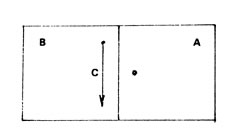 A person standing in a public domain may move [articles] throughout a private domain. Similarly, a person standing in a private domain may move [articles] within a public domain, provided he does not transfer them beyond four cubits.1 If he transfers an article [beyond that distance], he is not liable, because he is located in a different domain.2
A person standing in a public domain may move [articles] throughout a private domain. Similarly, a person standing in a private domain may move [articles] within a public domain, provided he does not transfer them beyond four cubits.1 If he transfers an article [beyond that distance], he is not liable, because he is located in a different domain.2Similarly, a person standing in a private domain may open [a door with a key3] in a public domain.4 [One standing] in a public domain may open [a door with a key] in a private domain.
One may force feed an animal whose head is inside [a stall, although] the major portion of its body is outside.5 One may not, [however, force feed a] camel unless its head and the major portion of its body is within [the stall], since its neck is long.
א
עומד אדם ברשות הרבים ומטלטל ברשות היחיד כולה. ועומד ברה"י ומטלטל ברה"ר ובלבד שלא יוציא חוץ לארבעה אמות. ואם הוציא פטור מפני שהוא ברשות אחרת. וכן עומד אדם ברשות היחיד ופותח ברשות הרבים. ברשות הרבים ופותח ברשות היחיד. בהמה שהיתה רובה בחוץ וראשה בפנים אובסין אותה. ובגמל עד שיהא ראשו ורובו בפנים הואיל וצוארו ארוך:
2
A person should not stand in a private domain and [extend his head into] the public domain to drink, nor [should he stand] in a public domain and [extend his head into] a private domain to drink, unless he brings his head and the majority of his body into the domain in which he is drinking.
When do the above [restrictions] apply? When he is drinking with attractive vessels that he needs.6 [In this instance, our Sages instituted a] decree, lest he transfer [the drinking vessels]. If, however, [the person uses] vessels that are not attractive and which he does not require, all that is necessary is that he bring in his head; it is not necessary that he bring in the majority of his body.7 If a cistern of water is located in a carmelit, [the above leniency applies] even when [the person] uses vessels that are attractive.8
ב
לא יעמוד אדם ברה"י וישתה ברה"ר. ברה"ר וישתה ברה"י. אלא א"כ הכניס ראשו ורובו למקום שהוא שותה. במה דברים אמורים כשהיה שותה בכלים נאים שהוא צריך להן. גזירה שמא יוציאם אבל אם היו כלים שאינן נאים שאינו צריך להן. או שהיה הבור בכרמלית אע"פ שהכלים נאים. מכניס ראשו בלבד ושותה במקומו ואף על פי שלא הכניס ראשו ורובו:
3
A person may stand in a public domain, [extend his hand,] collect water that is flowing from a drainpipe or a wall [while the water is] in the air, and drink, provided he does not touch the drainpipe or the wall and collect the water from them.9
[The following rules apply] should he [in fact] touch [the drainpipe or the wall]: If the place he touches is more than ten [handbreadths] high and within three handbreadths of the roof, the act is forbidden.10 It is as if he removed [the water] from the roof, which is a private domain.
Similarly, if the drainpipe was four [handbreadths] by four [handbreadths] and one collected water from it, this is forbidden regardless of whether the pipe is within ten handbreadths of the ground11 or above ten handbreadths.12 Why is the person not held liable? Because the water is not at rest, but rather continuing to flow.13
ג
עומד אדם ברה"ר וקולט מן האויר מן המים המקלחין מן הצנור או מן הכותל ושותה. ובלבד שלא יגע בצנור או בכותל ויקלוט מעל גבן. ואם נגע אם היה מקום שנגע בו למעלה מעשרה בפחות משלשה סמוך לגג הרי זה אסור. שנמצא כעוקר מעל הגג שהוא רה"י. וכן אם היה בצנור ארבעה על ארבעה. בין שהיה הצנור בתוך עשרה בין שהיה למעלה מעשרה וקלט ממנו מים הרי זה אסור. ולמה אינו חייב מפני שלא נחו המים אלא הרי הן נזחלין והולכין:
4
[The following rules apply when] a projection extends [from the wall of a building] near a window: If the projection is above ten handbreadths high, its use is permitted,14 for the public domain extends only ten handbreadths [above the ground].15 Therefore, it is permissible to use the entire wall, with the exception of the bottom ten handbreadths.16
ד
זיז שלפני החלון יוצא באויר שעל רה"ר. אם היה למעלה מעשרה טפחים מותר להשתמש עליו שאין רה"ר תופסת אלא עשרה טפחים. לפיכך מותר להשתמש בכל הכותל עד עשרה טפחים התחתונים:
5
When does the above apply? When there is [only] one projection extending into the space. When, however, there are two projections extending from the wall, one below the other,17 even though they are both more than ten handbreadths high,18 [different rules apply]: If the upper projection near the window is four [handbreadths] by four [handbreadths] in area, its use is forbidden,19 for it is a domain in its own right, and the projection below it is a separate domain.20 Accordingly, they each cause the other to be forbidden,21 for [the people in] two domains cannot [jointly] use the space of one domain.
ה
במה דברים אמורים כשהיה זיז אחד יוצא באויר. אבל אם היו יוצאים בכותל שני זיזין זה למטה מזה אע"פ ששניהם למעלה מעשרה. אם יש בזיז העליון שלפני החלון רוחב ארבעה על ארבעה אסור להשתמש עליו. מפני שהוא רשות בפני עצמו והזיז שתחתיו רשות אחרת. ואסרו זה על זה. שאין שתי רשויות משתמשות ברשות אחת:
6
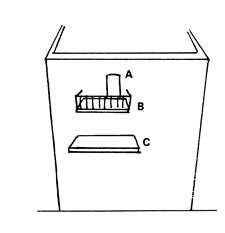 If both the upper projection and the lower projection are not four [handbreadths by four handbreadths], both of them may be used.22 Similarly, [in such a situation,] one may use the entire wall with the exception of the bottom ten handbreadths.
If both the upper projection and the lower projection are not four [handbreadths by four handbreadths], both of them may be used.22 Similarly, [in such a situation,] one may use the entire wall with the exception of the bottom ten handbreadths.If the lower projection was four [handbreadths by four handbreadths], but the upper projection was not four [handbreadths by four handbreadths], [an individual dwelling in the upper storey] may use only that portion of the upper [projection] that is directly opposite his window.23 It is forbidden to use the remainder of the projection that extends on either side of the window, because of the lower projection, which is considered to be a separate domain.24
ו
אין בעליון ארבעה ואין בתחתון ארבעה. משתמש בשניהן וכן בכל הכותל עד עשרה טפחים התחתונים. היה בתחתון ארבעה ובעליון אין בו ארבעה אינו משתמש בעליון אלא כנגד חלונו בלבד. אבל בשאר הזיז שבשני צדדי החלון אסור להשתמש מפני זה שתחתיו שחלק רשות לעצמו:
7
Whenever there is a projection that extends over the public domain25 and may be used, one may place upon it and remove from it only utensils of earthenware, glass, or the like, for if they fall into the public domain they will break. Other utensils and food are prohibited [to be placed there], lest they fall into the public domain, and [one descend and] bring them [into the home].26
ז
כל זיז היוצא על אויר רה"ר שמותר להשתמש עליו. כשהוא משתמש בו אין נותנין עליו ואין נוטלין ממנו אלא כלי חרס וזכוכית וכיוצא בהן שאם יפלו לרה"ר ישברו. אבל שאר כלים ואוכלין אסורים שמא יפלו לרה"ר ויביאם:
8
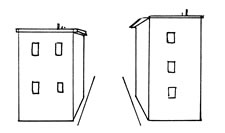 [The following rules apply when] there are two houses on opposite sides of the public domain: If a person throws an article from one to the other and the article is ten [handbreadths] above the ground, he is not liable,27 provided both houses belong to him or there is an eruv between them.28 One may throw even garments and metal utensils.29
[The following rules apply when] there are two houses on opposite sides of the public domain: If a person throws an article from one to the other and the article is ten [handbreadths] above the ground, he is not liable,27 provided both houses belong to him or there is an eruv between them.28 One may throw even garments and metal utensils.29If one of [the two houses] was higher than the other, and they were thus not on the same level, it is forbidden to throw a garment or the like, lest it fall and [one descend and] bring it. One may, however, throw earthenware utensils and the like.30
ח
שני בתים בשני צדי רה"ר זרק מזו לזו למעלה מעשרה פטור. והוא שיהיו שניהם שלו או שיהיה ביניהם עירוב. ואפילו בגדים וכלי מתכות מותר לזרוק. ואם היה זה למעלה מזה ולא היה בשוה אסור לזרוק בגד וכיוצא בו שמא יפול ויביאנו. אבל כלי חרס וכיוצא בהן זורק:
9
[The following rules apply when] a cistern located in the public domain has an opening [to a home] above it: The cistern and the sand [piled around it] are measured together [to see if their height reaches] ten [handbreadths]. [If it does,31] one may draw water from it on the Sabbath.
When does the above apply? When [the cistern] is within four handbreadths of the wall, for then a person cannot pass between them.32 If, however, it is further removed,33 one may not draw water from it unless the sand [piled around it] is ten [handbreadths] high.34 Thus, when the bucket is raised above the sand [pile],35 it enters a makom patur.
ט
בור ברה"ר וחלון על גביו הבור וחולייתו מצטרפים לעשרה וממלאין ממנו בשבת. במה דברים אמורים כשהיה סמוך לכותל בתוך ארבעה טפחים שאין אדם יכול לעבור שם. אבל אם היה מופלג אין ממלאין ממנו אלא אם כן היתה חולייתו גבוהה עשרה שנמצא הדלי כשיצא מן החוליא יצא למקום פטור:
10
It is permitted to pour water [from] a window [of a home] to a garbage heap located in the public domain that is ten handbreadths high, on the Sabbath.36
To what does the above apply? To a garbage heap belonging to the community, for this is unlikely to be removed. We may not, however, pour water onto a garbage heap belonging to an individual.37
It is possible that the garbage heap was cleared away 38 and thus, [unknowingly,39] one will be pouring into the public domain.
י
אשפה ברה"ר גבוהה עשרה טפחים וחלון על גבה שופכין לה מים בשבת. במה דברים אמורים באשפה של רבים שאין דרכה להפנות. אבל של יחיד אין שופכין עליה שמא תתפנה ונמצאו שופכין כדרכן ברה"ר:
11
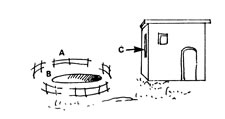 [The following rules apply to] a water conduit that passes through a courtyard: If it is ten [handbreadths] high and between four [handbreadths] and ten cubits wide, we may not draw water from it on the Sabbath, unless one erects a partition [in the water] ten handbreadths high at its entrance [to the courtyard] and its exit.
[The following rules apply to] a water conduit that passes through a courtyard: If it is ten [handbreadths] high and between four [handbreadths] and ten cubits wide, we may not draw water from it on the Sabbath, unless one erects a partition [in the water] ten handbreadths high at its entrance [to the courtyard] and its exit.If it is not ten [handbreadths] high or is less than four [handbreadths] wide, we may draw water from it without [erecting] a partition.
יא
אמת המים שהיא עוברת בחצר אם יש בגובהה עשרה טפחים וברחבה ארבעה או יותר על כן עד עשר אמות אין ממלאין ממנה בשבת אלא אם כן עשו לה מחיצה גבוהה עשרה טפחים בכניסה וביציאה. ואם אין בגובהה עשרה או שאין ברחבה ארבעה ממלאין ממנה בלא מחיצה:
12
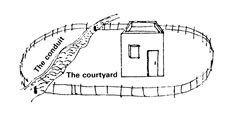 When [the water conduit that passes through the courtyard]40 is more than ten cubits wide, although it is less than ten handbreadths high, we may not draw water from it unless a partition is erected. Since it is more than ten [cubits] wide, it is considered to be an open space and nullifies the existence of the divider.41
When [the water conduit that passes through the courtyard]40 is more than ten cubits wide, although it is less than ten handbreadths high, we may not draw water from it unless a partition is erected. Since it is more than ten [cubits] wide, it is considered to be an open space and nullifies the existence of the divider.41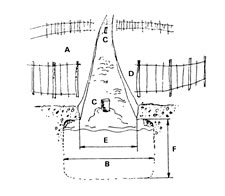 What is the ruling regarding carrying in the courtyard as a whole?42 If there is even a small portion [of the wall] remaining on both sides of the opening, or if a portion [of the wall] four handbreadths in size remains on one side of the opening, it is permitted to carry in the entire courtyard.43 It is forbidden only to draw water from the conduit.44 If, however, no portion of the wall remains, it is forbidden to carry in the entire courtyard, for it has been opened up to the sea,45 which is a carmelit.
What is the ruling regarding carrying in the courtyard as a whole?42 If there is even a small portion [of the wall] remaining on both sides of the opening, or if a portion [of the wall] four handbreadths in size remains on one side of the opening, it is permitted to carry in the entire courtyard.43 It is forbidden only to draw water from the conduit.44 If, however, no portion of the wall remains, it is forbidden to carry in the entire courtyard, for it has been opened up to the sea,45 which is a carmelit.יב
היה ברחבה יתר מעשר אמות אף על פי שאין בגובהה עשרה אין ממלאין ממנה עד שיעשה לה מחיצה. שכל יתר על עשר פרצה היא ומפסדת המחיצות. ומהו לטלטל בכל החצר. אם נשאר מצד הפרצה פס מכאן ופס מכאן בכל שהוא או פס רוחב ארבעה טפחים מרוח אחת מותר לטלטל בכל החצר ואין אסור אלא למלאות מן האמה בלבד. אבל אם לא נשאר פס כלל אסור לטלטל בכל החצר שהרי נפרצה חצר לים שהוא כרמלית:
13
How must the partitions be erected in the water? If [the majority of the partition] is above the water, at least a handbreadth of the partition must descend into the water.46 If the partition as a whole descends into the water, at least a handbreadth must rise above the water level. [In this manner,] the water in the courtyard will be distinct, [from the water in the conduit on either side of the courtyard].
Although the partition does not reach the ground [in the conduit], since it is ten handbreadths high, it is permitted. The use of a partition that remains hanging was allowed only with regard to water.47 Since the prohibition against carrying this water is Rabbinic in origin,48 [the Sages] were lenient regarding [the nature of] the partition [required], for its purpose is only to create a distinction.
יג
והיאך מעמידין את המחיצה במים. אם היתה למעלה מן המים צריך שיהיה טפח מן המחיצה יורד בתוך המים. ואם היתה המחיצה כולה יורדת בתוך המים צריך שיהיה טפח ממנה יוצא למעלה מן המים. כדי שיהיו המים שבחצר מובדלין. אף על פי שאין המחיצה מגעת עד הקרקע הואיל ויש בה עשרה טפחים הרי זו מותרת. ולא התירו מחיצה תלויה אלא במים בלבד. שאיסור טלטול במים מדבריהם והקלו במחיצה שאינה אלא כדי לעשות היכר:
14
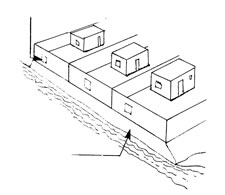 [The following rules apply] when a conduit of water passes between several courtyards and there are openings [from the courtyards] to it:49 If it is not the minimum size [of a domain],50one may lower buckets from the windows and draw water from it on the Sabbath.51
[The following rules apply] when a conduit of water passes between several courtyards and there are openings [from the courtyards] to it:49 If it is not the minimum size [of a domain],50one may lower buckets from the windows and draw water from it on the Sabbath.51When does the above apply? When [the conduit] is not more than three handbreadths away from the wall. If, however, [the conduit] is more than three handbreadths away from the wall, we may not draw water from it52 unless there are projections extending from the walls on either side. Thus the conduit would be considered as if it passes through the courtyard.53
יד
אמת המים העוברת בין החצרות וחלונות פתוחות אליה. אם אין בה כשיעור משלשלין דלי מן החלונות וממלאים ממנה בשבת. במה דברים אמורים בשאינה מופלגת מן הכותל שלשה טפחים. אבל אם היתה מופלגת מן הכותל שלשה טפחים אין ממלאים ממנה אלא אם כן היו פסין יוצאין מן הכותלים מכאן ומכאן שנמצא האמה כאילו היא עוברת בתוך החצר:
15
[The following rules govern] a balcony54 that extends over a body of water with an aperture55 [in its floor] that opens to the water: We may not draw water from it on the Sabbath56 unless a partition ten handbreadths high is constructed over the water parallel to the opening in the balcony.57 Alternatively, we may construct a partition descending from the balcony to the water. Then, we consider this partition as descending until it touches the water.58
Just as we may draw water from [the body of water] after making the partition, so too we may pour water from the balcony to the water.59 [The rationale is:] One is pouring into a carmelit.60
טו
כצוצרה שהיא למעלה מן הים וחלון בתוכה על גבי המים. אין ממלאים ממנה בשבת אלא א"כ עשו מחיצה גבוהה עשרה טפחים על גבי המים כנגד החלון שבכצוצרה. או תהיה המחיצה יורדת מן הכצוצרה כנגד המים ורואין אותה כאלו ירדה ונגעה עד המים. וכשם שממלאין מזו שעשו לה מחיצה כך שופכין ממנה על הים. שהרי על הכרמלית הן שופכין:
16
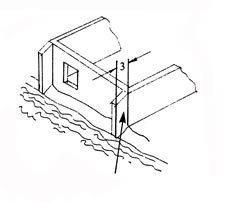 We must not pour water into a courtyard that is less than four cubits by four cubits61 on the Sabbath, because [the water] will flow into the public domain rapidly.62
We must not pour water into a courtyard that is less than four cubits by four cubits61 on the Sabbath, because [the water] will flow into the public domain rapidly.62Therefore, it is necessary to dig a pit that contains two seah63 in the courtyard or in the public domain next to the courtyard, so that the water will collect there. [If the pit is within the public domain], one must build a domed covering64 over this pit from the outside so that the pit will not be seen in the public domain.65
The courtyard and the patio adjoining it are combined [when calculating] the four cubits. How large is a pit that contains two seah? [A pit] half a cubit by a half a cubit in area and three fifths of a cubit high.
טז
חצר שהיא פחותה מארבע אמות על ארבע אמות אין שופכין בתוכה מים בשבת מפני שהן יוצאין לרה"ר במהרה. לפיכך צריך לעשות גומא מחזקת סאתים בתוך החצר או ברה"ר בצד החצר כדי שיהיו המים נקבצים בתוכה. וצריך לבנות עליה כיפה מבחוץ כדי שלא תראה העוקה הזאת ברה"ר. והחצר והאכסדרה מצטרפין לארבע אמות. וכמה הוא המקום שמחזיק סאתים חצי אמה על חצי אמה ברום שלשה חומשי אמה:
17
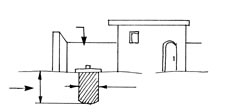 If the pit cannot contain two seah, we may pour [no more than] its contents into it. If it can contain two seah, we may pour [any amount of] water into it, even 60 seah, despite the fact that the water will overflow and spill from the pit outward.
If the pit cannot contain two seah, we may pour [no more than] its contents into it. If it can contain two seah, we may pour [any amount of] water into it, even 60 seah, despite the fact that the water will overflow and spill from the pit outward.When does the above apply? In the rainy season, at which time the courtyards are muddied and many drainpipes spread water. Thus, onlookers will not say that this person is making use of the courtyard and the water is flowing into the courtyard because of his power. In the summer, by contrast, if [the pit] can contain two seah, only that amount may be poured into it. If it cannot contain two seah, no water at all may be poured into it.
יז
היתה העוקה פחותה מסאתים שופכין לה במלואה. היתה מחזקת סאתים שופכין לה אפילו ששים סאה של מים. ואף על פי שהמים יתגברו ויפוצו מעל הגומא לחוץ. בד"א בימות הגשמים שהחצרות מתקלקלות וסתם צנורות מקלחין ולא יבאו הרואים לומר שזה משתמש ברה"ר והמים יוצאים מכחו ברה"ר. אבל בימות החמה אם היתה מחזקת סאתים אין שופכין לה אלא סאתים. היתה פחותה מסאתים אין שופכין לה כל עיקר:
18
[The following rules apply] to a drain through which water is poured and the water flows under the ground into the public domain, and to a gutter when water is poured over its mouth and the water flows down a wall and descends to the public domain: Even if the wall is 100 cubits long or the stretch of ground under which [the water] passes is 100 cubits long, it is forbidden to pour into the mouth of this drain or this gutter, for because of one's power, the water flows into the public domain. Instead, one should pour outside the drain, [allowing the water to] flow into the drain on its own accord.
יח
ביב ששופכין לו מים והן נזחלין והולכין תחת הקרקע ויוצאין לרה"ר. וכן צנור ששופכין על פיו מים והן נזחלין על הכותל ויורדין לרה"ר. אפילו היה אורך הכותל או אורך הדרך שתחת הארץ מאה אמה אסור לשפוך על פי הביב או על פי הצנור מפני שהמים יוצאין מכחו לרה"ר. אלא שופך חוץ לביב והן יורדין לביב:
19
When does the above apply? In the summer. In the winter, by contrast, one may pour [water as mentioned above], and indeed, do so repeatedly, without inhibition. At that time, the gutters are flowing [with water], and a person desires that the water will be absorbed in its place.
[In contrast,] it is permitted for a person to pour water over a drain which flows into the carmelit, even in the summer. No decrees were enacted against [the effect of] a person's power in a carmelit. For this reason, it is permitted to pour [water] down the side of a ship and have it descend to the sea.
יט
בד"א בימות החמה אבל בימות הגשמים שופך ושונה ואינו נמנע. שסתם צנורות מקלחין הן ואדם רוצה שיבלעו המים במקומן. היה שופך על פי הביב והמים יוצאין לכרמלית הרי זה מותר ואפילו בימות החמה שלא גזרו על כחו בכרמלית. לפיכך מותר לשפוך על כותלי הספינה והם יורדין לים:
20
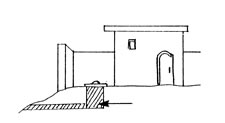 A person who is standing in a ship should not draw water from the sea unless he builds a protrusion, four [handbreadths] by four [handbreadths], extending from the ship above the sea.
A person who is standing in a ship should not draw water from the sea unless he builds a protrusion, four [handbreadths] by four [handbreadths], extending from the ship above the sea.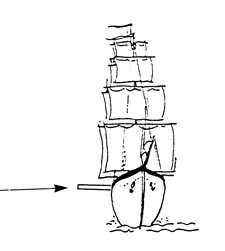 When does the above apply? When [the deck of the ship] is within ten [handbreadths of the water level]. If, however, [the deck] is more than ten [handbreadths above the water level], he may draw water after erecting a protrusion of the smallest size. [The rationale for this leniency is that] he is drawing water through a makom patur, and the protrusion is necessary only to make a distinction.
When does the above apply? When [the deck of the ship] is within ten [handbreadths of the water level]. If, however, [the deck] is more than ten [handbreadths above the water level], he may draw water after erecting a protrusion of the smallest size. [The rationale for this leniency is that] he is drawing water through a makom patur, and the protrusion is necessary only to make a distinction.כ
לא ימלא אדם מים מן הים והוא בתוך הספינה אלא אם כן עשה מקום ארבעה על ארבעה יוצא מן הספינה על הים. במה דברים אמורים כשהיה תוך עשרה אבל אם היה למעלה מעשרה מן הים מוציא זיז כל שהוא וממלא. שהרי דרך מקום פטור ממלא ואינו צריך לזיז זה אלא משום היכר:
21
[The following rules apply when] a person was reading a scroll in a carmelit, a portion of the scroll rolled into the public domain, and a portion remained in his hand: If it rolled more than four cubits, he should turn it face down and leave it. This is a decree, enacted lest [the scroll] drop from his hand and he carry it [more than] four cubits. If it rolled less than four cubits, he should roll it back toward himself. Similarly, if it rolled into a private domain, he should roll it back towards himself.
[The following rules apply when] a person was reading in a private domain and the scroll rolled into a public domain]: If it came to rest, he should turn the scroll face down. If it did not come to rest, but rather remained suspended in the air above the public domain and did not reach the earth, he may roll it back to himself.
כא
הקורא בספר בכרמלית ונתגלגל מקצת הספר לרה"ר ומקצתו בידו. אם נתגלגל לחוץ לארבע אמות הופכו על הכתב ומניחו. גזירה שמא ישמט כולו מידו ויעבירנו ארבע אמות. נתגלגל לתוך ארבע אמות גוללו אצלו. וכן אם נתגלגל לרה"י גוללו אצלו. היה קורא ברה"י ונתגלגל לרה"ר אם נח בה הופכו על הכתב. ואם לא נח אלא היה תלוי באויר רה"ר ולא הגיע לארץ גוללו אצלו:
22
A person who moves thorns so that the public at large will not be injured [should adhere to the following guidelines]: If [the thorns] were in the public domain, he should move them less than four cubits at a time. If they were located in a carmelit, he may move them even 100 cubits in a normal manner.
Similarly, if a corpse [began to decompose,] emit foul odors, and become extremely abhorrent to the extent that the neighbors cannot bear to remain [in the same place], it may be taken from a private domain to a carmelit.
After a person descends to bathe in the sea, he should dry himself when he ascends, lest he carry the water that is on him more than four cubits in a carmelit.
כב
המעביר קוץ כדי שלא יזוקו בו רבים. אם היה ברה"ר מוליכו פחות מארבע אמות. ואם היה בכרמלית מוליכו כדרכו אפילו מאה אמה. וכן מת שהסריח ונתבזה יתר מדאי ולא יכלו שכנים לעמוד מוציאין אותו מרה"י לכרמלית. היורד לרחוץ בים כשהוא עולה מנגב עצמו שמא יעביר מים שעליו ארבע אמות בכרמלית
FOOTNOTES
1.In both these instances, there is not even a Rabbinic prohibition against moving the articles. As mentioned in the notes on the following halachah, Rashi and the Rashba state that this leniency applies only with regard to articles the person does not require in the domain in which he is standing. If he needs them, the Rabbis decreed that they may not be moved, lest the person forget and bring the articles into the domain where he is standing. The Shulchan Aruch (Orach Chayim 350:1) appears to favor the view of these authorities.
2.The Ra'avad questions the Rambam's decision, noting that Eruvin 99a would appear to hold a person liable in such a situation. The difficulty with the Rambam's statements is compounded by the fact that the passage cited above associates the law in question with the following decision, "A person who carries an article from the beginning [of a square] four cubits long to the end [of that square] in the public domain is liable, even when he lifts it above his head." Since the Rambam holds one liable in the latter instance (see Chapter 12, Halachah 14), it would seem that he would hold one liable with regard to the law under discussion. The Ra'avad's arguments are so powerful that the Maggid Mishneh suggests amending the text of the Mishneh Torah accordingly.
The Radbaz (Vol. V, Responsum 1527) notes the Ra'avad's question, and states that he checked all the ancient manuscripts of the Mishneh Torah available to him, and they all state that the person is not liable. Therefore, he explains that a person is not liable for transfering an article unless he is standing in one of the domains involved in the transfer. This concept is derived from the transfer of the articles in the construction of the Sanctuary. In this instance, the people were not standing in a domain other than those involved in the transfer. Based on this foundation, he offers an interpretation - albeit a slightly strained one - for the passage in Eruvin.
3.This and the following law refer to situations where the key is located in the domain where the door is located.
4.The Maggid Mishneh mentions the possibility of placing the key in the door as a forbidden transfer. In the present day, almost every keyhole would be considered to be a makom patur.
5.I.e., we are not worried that perhaps the animal will withdraw its neck and the person will carry the food outside the stall. Note the apparent contradiction to Chapter 17, Halachah 29.
6.As mentioned in the notes on the previous halachah, in their commentary on Eruvin 99a, the source for these halachot, Rashi and the Rashba maintain that if the person requires the vessels, the above restrictions apply even if the vessels are not attractive. The Maggid Mishneh states that although the Rambam's ruling appears most appropriate within the context of the Talmudic passage, in practice the more stringent ruling should be followed. As mentioned, the Shulchan Aruch also rules accordingly.
7.This relects a significant leniency. We are requiring the person to drink while bent over. Even so, the Rabbis did not feel it necessary to forbid the person from drinking, lest he forget, stand upright, and thus bring the drinking vessel into the other domain.
8.The prohibition against transferring an article from a carmelit is Rabbinic in nature. Hence, even if the person were to forget and transfer the drinking vessels to his domain, he would not violate Torah law. Accordingly, there is no need to prohibit him from drinking as a further safeguard.
This represents the opinion of Ravvah (Eruvin 99a) and is accepted by the Shulchan Aruch (Orach Chayim 350:1). Significantly, however, the Talmud also records the opinion of Abbaye, who differs and maintains that since the forbidden labor of transferring articles is a matter that may be taken lightly, the Sages instituted safeguards with regard to Rabbinic decrees as well.
9.As long as he takes the water from the air, there is no difficulty. If he takes the water from ten handbreadths or more above the ground, he has taken it from a makom patur. If he takes it from less than ten handbreadths, he has moved an article less than four cubits in the public domain.
10.Based on the principle of l'vud, since the pipe is within three handbreadths of a private domain, it is considered to be an extension of that domain.
From the Rambam's wording, it appears that if the roof is less than thirteen handbreadths above the ground, the principle of l'vud does not apply. This is so because the principle of l'vud cannot cause a space that is part of the public domain to be considered an extension of a private domain (Maggid Mishneh).
11.In this instance, the pipe would be considered to be a carmelit. Transferring from a carmelit to a public domain is forbidden.
12.In this instance, the drainpipe is considered to be a private domain in its own right.
13.Note the distinction between this ruling and Chapter 13, Halachah 4, which describes removing water that is at rest.
14.I.e., to place articles upon it, transferring them from the building. Note, however, the restrictions mentioned in Halachah 7.
15.The space more than ten handbreadths above a public domain is a makom patur. Hence, one may transfer articles to and from it (Chapter 14, Halachah 12).
16.This applies even if a projection is four handbreadths by four handbreadths in area and directly below an open window. Since it is low enough to be used by the passersby in the public domain, it is considered to be a carmelit.
17.The Maggid Mishneh explains that according to the Rambam, these restrictions apply even when the two projections are not directly above each other.
18.As the Rambam explains, the difficulty is that people from different properties cannot both use a third property which adjoins them - for example (Hilchot Eruvin 3:16), a wall that is four handbreadths wide that separates between two different properties. In particular, there are two conceptions of the Rambam's statements:
a) that of the Shulchan Aruch (Orach Chayim 353:2), which explains that the two projections extend from two windows belonging to two different individuals who have not made an eruv. Since these individuals are forbidden to transfer articles from one projection to the other by Rabbinical decree, certain restrictions were also placed on using the projections themselves.
b) that of the Ritba, who explains that we are speaking of a wall that possesses only a single window. Nevertheless, the lower projection may be used by the passersby in the public domain. (Although the public domain extends only to ten handbreadths, the people in the public domain have the right to use projections and holes in the wall that are above that height.) When there is only one projection, they refrain from using it, because it will be used by the inhabitants of the house. When, however, there are two projections, the passersby feel free to use the lower one. This in turn causes there to be certain restrictions with regard to the use of both projections on the Sabbath. See the diagram on the opposite page.
Although the Merkevet HaMishneh and others explain that the Ritba's interpretation is more appropriate to the wording chosen by the Rambam, our notes will follow the approach of the Shulchan Aruch, for it is accepted by the subsequent halachic authorities. It also must be noted that Rashi's version of the text of Eruvin 98b differs from that of the Rambam. Accordingly, he and the subsequent Ashkenazic authorities have a different conception of these rulings.
19.Note that Shulchan Aruch HaRav 353:3 and the Mishnah Berurah 353:11 explain that this refers to articles that were kept inside the house. Articles that were left on the projection before the Sabbath may be moved on it. See Hilchot Eruvin 3:18-19.
20.This applies even if the lower projection is not four handbreadths by four handbreadths (Shulchan Aruch HaRav 353:4; Mishnah Berurah 353:12).
21.Note the Mishnah Berurah 353:12, which cites opinions that allow the people whose window opens up to the lower projection to use it when it is less than four handbreadths by four handbreadths.
22.There are no restrictions whatsoever, for neither projection is a domain in its own right.
23.This is permitted, because the projection is considered to be an extension of the window, like a hole in the wall of a private domain (Maggid Mishneh).
24.Since the lower projection is a domain in its own right, it includes the space above it until the heavens, and the entire wall is considered as a part of it. In this instance, since the upper projection is not considered to be a domain in its own right, it is divided into portions. The portion directly opposite the window is considered an extension of the window as in the previous note, but the portion on either side is considered part of the lower projection.
25.If the projection extends over a carmelit and is ten handbreadths high, there are no restrictions regarding the articles that may be used on it (Shulchan Aruch, Orach Chayim 353:3).
26.Bringing the articles from the public domain to the home constitutes a forbidden activity. Hence, our Sages instituted this safeguard.
Note the Rashba, who states that if a projection is four handbreadths by four handbreadths, there are no restrictions regarding the articles that may be used on it. Although the Shulchan Aruch (Orach Chayim 353:3) quotes the Rambam's ruling, the Ramah states that on a roof or balcony on which a person stands comfortably, all articles may be carried.
27.Our translation follows the version of the standard published text of the Mishneh Torah. Many early printings and manuscripts of the text state "one is permitted...." From the context, the latter version appears more appropriate.
One is forbidden to transfer from one private domain to another private domain when they are separated by a public domain. Nevertheless, since the public domain extends for only ten handbreadths above the ground, the transfer is not being made through a public domain, but rather through a makom patur (Shulchan Aruch HaRav 353:1).
28.See Hilchot Eruvin 1:1-4, which explains that although according to the Torah itself, one may transfer from one private domain to another, our Sages forbade this unless an eruv was constructed.
29.These articles are not breakable. Nevertheless, since the houses are on the same level, it is not difficult to throw from one to the other. Accordingly, our Sages did not feel the need for a safeguard, lest the article fall and the person descend to the public domain and bring them into his home, a private domain.
30.Even if the articles fall into the public domain, they will break. Hence, there is no need to worry that the person may bring them home.
The above restrictions apply only to houses on two sides of a public domain. If two houses are located on two sides of a carmelit, there are no restrictions regarding the type of articles that may be thrown, because there is no possibility of a Torah prohibition being violated (Maggid Mishneh).
31.A cistern that is ten handbreadths deep is considered as a private domain. Were the sand piled around the cistern to be ten handbreadths high, the enclosure would be considered a private domain. Eruvin 99b teaches us a new concept, that the sum of ten handbreadths can be reached by combining the two together.
Hence, there is no difficulty in drawing water from the enclosure to the house, since one is transferring from one private domain to another. Needless to say, it is forbidden to transfer from such an enclosure to the public domain.
32.Since there is no room for a person to pass comfortably between the sand pile and the wall of the house, the space between them is not considered as part of the public domain, but rather as a carmelit (compare to Chapter 14, Halachah 6). Therefore, the space above it is also considered as a carmelit. Thus, one would be transferring from a private domain to a private domain via a carmelit. In this instance (in contrast to Chapter 14, Halachah 14), our Sages allowed such a transfer.
33.When there is room for people to pass between the cistern and the house in a normal manner, the space between them is considered as part of the public domain. Therefore, a person who draws water through the opening to his home would be considered to be transferring from a private domain - the cistern - through a public domain - the area above the space between the sand pile and the home - to one's home - a private domain. See Chapter 13, Halachah 16.
34.Here, the importance of the height of ten handbreadths is not significant because it creates a private domain, but because, as explained in the following note, this will cause the bucket to be more than ten handbreadths above the ground as it passes over the sand pile.
35.I.e., as the bucket is transferred from the enclosure to the home, it passes above the public domain. In this instance, since the sand pile is ten handbreadths high, there is no difficulty, because the space ten handbreadths above the public domain is a makom patur.
36.Since the garbage heap is ten handbreadths high, it constitutes a private domain.
Thus, when water is poured from the house, the water will pass from a private domain through a makom patur - the space more than ten handbreadths above the public domain - to another private domain. This is permitted.
37.This is a Rabbinic decree, instituted for the reason to be explained. Shulchan Aruch HaRav 354:3 states that this restriction applies even if the garbage heap is located in a carmelit.
38.Eruvin 99b cites an example where the Sages considered such a possibility.
39.I.e., we suspect that without looking, the person will follow his usual habit and pour water onto the place where the garbage heap was located previously without noticing that it had been removed.
40.In this halachah as well, most commentaries maintain that the Rambam is referring to a water conduit that passes through a place where a portion of the wall of the courtyard has been taken down. As mentioned above, the Ra'avad interprets Eruvin 12b, the source for this halachah, differently, and therefore objects to the Rambam's ruling.
Significantly, the Merkevet HaMishneh notes that the second clause of the halachah appears to indicate that the conduit breaks through the wall entirely, and it therefore offers a different interpretation of the Rambam's words.
41.Since the conduit is not deep enough to constitute a domain of its own, it would normally be considered part of the domain through which it passes. (See Chapter 14, Halachah 24.) Nevertheless, since this conduit is so wide, it is no longer considered part of the private domain.
42.I.e., does the conduit nullify the courtyard's distinction as a private domain? Significantly, this question is asked in this halachah and not in the previous one. In the previous halachah, although the conduit itself was considered a separate domain, since the opening was less than ten handbreadths, it is considered as an entrance and the enclosure is not nullified. This halachah, however, mentions an opening of more than ten cubits, an aperture which ordinarily nullifies an enclosure.
43.Several explanations have been offered for the Rambam's ruling. Among them: the small portion of the wall which remains juts out over the water. Therefore, the opening to the courtyard is less than ten cubits (Rabbenu Yonason, commenting on Rabbenu Yitzchak Alfasi). The portions of the wall which remain on either side are considered like poles. As stated in Chapter 17, Halachah 7, it is permitted to carry in a courtyard with poles on either edges of the entrance to the fourth side (an ancient commentary on the Mishneh Torah from Egypt). See also the Or Sameach.
44.For the reasons mentioned above, the wall of the courtyard is an acceptable divider, and thus the courtyard as a whole is still considered to be a private domain. Nevertheless, since the wall was not made for the purpose of distinguishing the water that is outside the courtyard from that which is within the courtyard, a separate partition is required for that purpose (ibid.).
45.When there are no portions jutting out over the water (according to the first interpretation in note 49) or when the entire wall is destroyed (according to the second), the courtyard is considered as enclosed on three sides alone and it is forbidden to carry within.
46.For the entire intent of this partition is to make a distinct separation between the water in the courtyard and the water in the public domain outside of it. [See the Rambam's Commentary on the Mishneh (Eruvin 8:6). See also Hilchot Eruvin 3:21-22 where the Rambam mentions a similar requirement.]
47.Generally, a partition must descend within three handbreadths of the ground.
48.For, as mentioned above, the courtyard is a private domain, and carrying within it is permitted. Furthermore, even the water conduit is considered as a private domain according to the Torah itself and its designation as a carmelit is Rabbinic in origin.
49.In contrast to the conduit mentioned in the previous halachot, this conduit does not pass through the courtyards, but merely by their side. Hence, it cannot be considered as part of the courtyard itself.
50.I.e., ten handbreadths deep and four handbreadths wide.
51.The conduit is considered to be a carmelit; the windows, the holes adjacent to a carmelit. One may transfer an article from a carmelit to such holes. This interpretation follows Rabbenu Chanan'el's interpretation of Eruvin 87b. The Ra'avad has a different conception of this passage, and hence objects to the Rambam's rulings.
52.Since the opening is more than three handbreadths away, it is no longer considered to be a hole adjacent to the carmelit, but rather a separate entity. Hence, it is forbidden to transfer from the carmelit to it.
53.I.e., the projections would cause the courtyard to be considered as extending beyond its wall, into the space of the conduit. Therefore, taking water from the conduit would be considered as moving an article within a single private domain.
54.In his Commentary on the Mishnah (Eruvin 8:8), the Rambam explains that just as it is customary to erect balconies over the public domain, it is also customary to erect balconies over bodies of water.
55.The Shulchan Aruch (Orach Chayim 355:1) states that the aperture must be four handbreadths by four handbreadths.
56.Since the body of water is considered to be a carmelit. It is forbidden to transfer from a carmelit to a private domain.
57.The partition need not reach the water itself. Because of the principle gud acheit mechitzata, the partition is considered as if it extends into the water, even though it actually ends above its surface. This leniency is granted, because the entire prohibition is Rabbinic in origin.
Thus it is considered as if the hole extends into the water itself. Accordingly, we are allowed to draw water through it, because the portion of the body of water beneath it is considered to be an extension of the private domain [the Rambam's Commentary on the Mishnah (ibid.)].
58.The partition need not reach the balcony. Because of the principle gud asik mechitzata, the partition is considered as if it extends to the balcony, even though it actually ends below it (ibid.). See also Shulchan Aruch (Orach Chayim 355:1).
59.Eruvin 88a explains that the leniency of pouring into the body of water has an added dimension of severity. The current of the water will cause the water that has been poured to flow beyond the periphery of the aperture and into the portion of the body of water that is a carmelit. Nevertheless, since the person does not perform this transfer himself, there is no restriction.
60.Since the prohibition is Rabbinic in origin, the construction of such a partition is sufficient (Ma'aseh Rokeach).
61.The Maggid Mishneh explains that the Rambam's wording is intended to negate an opinion mentioned in Eruvin 88a, which states that even if a courtyard is not four handbreadths by four handbreadths, if its total area is 16 square handbreadths (e.g., it is is eight cubits by two), the restrictions mentioned in this halachah do not apply. Significantly, the Rashba accepts the more lenient view and, in this instance, the Shulchan Aruch (Orach Chayim 357:1) follows his ruling.
62.Pouring the water into the courtyard does not violate a Torah prohibition, because the courtyard itself is an extension of the home. Although the water flows into the public domain, this is due to the forces of gravity and inertia. Thus, the person's pouring of the water is considered as merely a cause; it is not considered as if he poured the water into the public domain directly. Nevertheless, the Rabbis forbade pouring the water in this manner.
63.A seah is approxinmately 8.25 liters according to Shiurei Torah and 14.4 liters according to the Chazon Ish. The Sages chose this measure because they considered this to be the average quantity of water used by a person every day (the Rambam's Commentary on the Mishnah, Eruvin 8:9).
64.Note the Shulchan Aruch (loc. cit.), which differs and mentions a covering of boards, which most likely is flat.
65.In his Commentary on the Mishnah (op. cit.), the Rambam explains that the covering will cause the pit to be separated from the public domain. (See Shulchan Aruch HaRav 357:1 and the Be'ur Halachah, which explain that because of its dome-like cover, people will not walk over it easily. Hence, since its opening faces the private domain, it is considered to be a hole adjacent to the private domain or a makom patur.) Note the Beit Yosef (Orach Chayim 357) who explains that the reason for the cover is to prevent people's suspicions from being aroused.
Shabbat - Chapter Sixteen
1
[The following rules pertain to] a place that is enclosed for purposes other than habitation, and is used as an open space - e.g., gardens and orchards, an open area that is enclosed to protect it, or the like: If the walls surrounding it are ten handbreadths or more high, it is considered to be a private domain with regard to a person's being liable for transferring, throwing, or passing an object from it to the public domain, or from the public domain to it.1
We are not allowed to carry within it, unless its area is equivalent to that necessary to sow two seah [of grain]2 or less. If its area is larger than the space necessary to sow two seah, we may not carry more than four cubits within it, as in a carmelit.3
א
מקום שלא הוקף לדירה אלא שיהיה תשמישו לאויר כגון גנות ופרדסים וכגון המקיף מקום מן הארץ לשומרו וכיוצא בהן. אם יש בגובה המחיצות עשרה טפחים או יתר הרי הוא כרה"י לחייב המוציא והזורק והמושיט ממנו לרה"ר או מרה"ר לתוכו. ואין מטלטלין בכולו אלא אם כן יש בו בית סאתים או פחות. אבל אם היה בו יתר על בית סאתים אסור לטלטל בו אלא בארבע אמות ככרמלית:
2
Similarly, if a surface is elevated more than ten handbreadths high4 and whose area is equivalent to the space necessary to sow two seah or less, we may carry on the entire surface. If its area exceeds the space necessary to sow two seah, we may carry only within a space of four cubits upon it.5
When a rock in the sea is less than ten handbreadths high, we may carry from it to the sea, and from the sea to it, for the entire area is a carmelit.6 If [the rock] is ten handbreadths high, [different rules apply]. If the size of its area is between7four handbreadths [by four handbreadths]8 and the space necessary to sow two seah, [our Sages forbade] carrying from [the rock] to the sea or from the sea to the rock. [This restriction is a safeguard, instituted,] because we are permitted to carry on the entire [rock].
If its area exceeds the space necessary to sow two seah, although it is a private domain and yet it is forbidden to carry more than four cubits upon it as in a carmelit, it is permitted to carry from it to the sea and from the sea to it. This is an atypical situation. Hence, the Sages did not [include] it [in their] decree.9
ב
וכן עמוד שגבוה עשרה טפחים ורחב עד בית סאתים מטלטלין על כולו. היה רחב על בית סאתים אין מטלטלין בו אלא בארבע אמות. סלע שבים היה גבוה פחות מעשרה מטלטלין מתוכו לים ומן הים לתוכו שהכל כרמלית. היה גבוה עשרה אם היה רחבו מארבעה טפחים עד בית סאתים הואיל ומותר לטלטל בכולו אין מטלטלין לא מתוכו לים ולא מן הים לתוכו. היה יתר מבית סאתים אע"פ שהוא רה"י הואיל ואסור לטלטל בו אלא בארבע אמות ככרמלית הרי זה מותר לטלטל מתוכו לים ומן הים לתוכו שזה דבר שאינו מצוי הוא ולא גזרו בו:
3
How large is an area in which a seah [of grain can be sown]? Fifty cubits by fifty cubits. Thus, the area in which two seah [of grain can be sown] is 5000 square cubits.10
This measure11 applies whether the area is a square of 70 cubits and a fraction by 70 cubits and a fraction,12or it is a circle, or it is of another shape.13 [If its area equals the sum mentioned,] it is considered as "the area in which two seah [of grain can be sown]."
ג
כמה היא בית סאה חמשים אמה על חמשים אמה. נמצא בית סאתים מקום שיש בתשבורתו חמשת אלפים אמה. וכל מקום שיש בו כמדה הזאת בין שהיה מרובע שהוא שבעים אמה ושירים על שבעים אמה ושירים בין שהיה עגול בין שאר הצורות הרי זה נקרא בית סאתים:
4
[The following rules apply when] an area that is enclosed for purposes other than habitation and is large enough for two seah [of grain to be sown within is rectangular in shape]: If its length is twice its width - for example, it is 100 by 50, as was the courtyard of the Sanctuary - carrying is permitted within it.
If, however, [it is more elongated] and its length exceeds twice its width by even one handbreadth,14 we are permitted to carry only four cubits within it.15 [This restriction is imposed because the permission to carry as one may carry] in other courtyards [within] an open space large enough for two seah [of grain to be sown within], is derived from the courtyard of the Sanctuary.16
ד
מקום שלא הוקף לדירה שיש בו בית סאתים אם היה ארכו פי שנים כרחבו כדי שיהיה מאה על חמשים כחצר המשכן מותר לטלטל בכולו. אבל אם היה ארכו יתר על שנים כרחבו אפילו אמה אין מטלטלין בו אלא בארבע אמות. שלא עשו בית סאתים שתשמישו לאויר כשאר החצרות אלא מחצר המשכן:
5
[The status of] a place that was originally enclosed for purposes other than habitation [may be changed in the following manner]. A person tears down [a portion of the wall, creating] an open space that is more than ten cubits long and ten handbreadths high17 and then re-encloses that space for the purpose of habitation.18 [After this has been done,] one may carry within the entire enclosure.
Moreover, even if one [did not complete the entire process at once, but rather] tore down a single cubit and re-enclosed that space for the purpose of habitation, tore down another single cubit and re-enclosed that space for the purpose of habitation19 - [when one continues this process until] one re-encloses a space greater than ten cubits one may carry within the entire enclosure, even though it is several millim20 in size.
ה
מקום שהוקף שלא לשם דירה אם פרץ בו פרצה יתר על עשר אמות בגובה עשרה טפחים וגדר בה לשם דירה עד עשרה מותר לטלטל בכולה. ואפילו פרץ אמה וגדרה לשם דירה ופרץ אמה וגדרה לשם דירה עד שהשלימה ליתר מעשר מותר לטלטל בכולה אף על פי שיש בו כמה מילין:
6
When [produce] is sown in the majority of an area that is larger than the space [necessary to sow] two seah [of grain] that was enclosed for the sake of habitation, the area is considered to be a garden,21 and it is forbidden to carry within it in its totality.22
[The following rules apply when produce] is sown merely within a minor portion [of the enclosure]: If the portion [where the produce] was sown is equal23 to the space [necessary to sow] two seah [of grain], one may carry within the entire [enclosure].24 If the portion [where the produce] was sown is larger than the space [necessary to sow] two seah [of grain],25one may not carry within the entire [enclosure].26
When trees are planted in the majority [of the enclosure],27 it is considered to be a courtyard, and one may carry within the entire [enclosure].28
Should [the enclosure] become filled with water,29 [the following rules apply]: If [the water] is fit to be used [by humans],30 [the water] is considered to be like trees,31 and it is permitted to carry within the entire enclosure. If [the water] is not fit to be used [by humans], we may carry only [within a square of] four cubits in [the enclosure].32
ו
מקום יתר מבית סאתים שהוקף לדירה אם נזרע רובו הרי הוא כגנה ואסור לטלטל בכולו. נזרע מיעוטו אם נזרע ממנו בית סאתים מותר לטלטל בכולו. ואם היה המקום הזרוע יתר מבית סאתים אסור לטלטל בכולו. נטע רובו הרי הוא כחצר ומותר לטלטל בכולו. נתמלא מים אפילו היו עמוקים הרבה אם היו ראויין לתשמיש הרי הן כנטעים ומותר לטלטל בכולו. ואם אינן ראויין לתשמיש אין מטלטלין בו אלא בארבע אמות:
7
 [The following rule applies when a roof is constructed33over a portion of] an area large enough for three seah [of grain to be sown within] which originally had been enclosed for purposes other than habitation: If the roof34 covers [a portion of this area] large enough for a seah [of grain to be sown], we are permitted [to carry throughout the entire enclosure] because of the roof. [The rationale is:] The edge of the roof is considered to descend and close off
[The following rule applies when a roof is constructed33over a portion of] an area large enough for three seah [of grain to be sown within] which originally had been enclosed for purposes other than habitation: If the roof34 covers [a portion of this area] large enough for a seah [of grain to be sown], we are permitted [to carry throughout the entire enclosure] because of the roof. [The rationale is:] The edge of the roof is considered to descend and close off[the covered portion from the enclosure as a whole].35
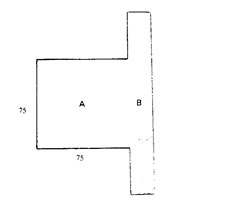 [The following rule applies when the wall surrounding an area that was enclosed for purposes other than habitation] was torn down,36 opening the enclosure up to an adjoining courtyard, and [a portion of the wall of the courtyard] opposite [the enclosure] was also torn
[The following rule applies when the wall surrounding an area that was enclosed for purposes other than habitation] was torn down,36 opening the enclosure up to an adjoining courtyard, and [a portion of the wall of the courtyard] opposite [the enclosure] was also torn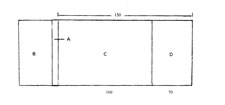 down: 37 [We are] permitted [to carry] within the courtyard as [we] previously [were], and [we are] forbidden [to carry] within the enclosure as [w] previously [were].38 [The rationale is:] The open space of the courtyard does not cause [carrying] to be permitted [within the enclosure].39
down: 37 [We are] permitted [to carry] within the courtyard as [we] previously [were], and [we are] forbidden [to carry] within the enclosure as [w] previously [were].38 [The rationale is:] The open space of the courtyard does not cause [carrying] to be permitted [within the enclosure].39ז
מקום שהוקף שלא לשם דירה שיש בו בית שלש סאין וקירו בו בית סאה קירויו מתירו שפי תקרה יורד וסותם. נפרץ במלואו לחצר ונפרצה חצר כנגדו. חצר מותרת כשהיתה והקרפף אסור כשהיה. שאין אויר החצר מתירו:
8
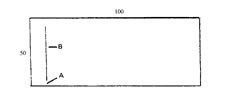 When [the area of an enclosure] is greater than the space necessary [to sow] two seah [of grain], and one attempts to reduce its size40 by planting trees, its [size is not considered to have been] reduced.41
When [the area of an enclosure] is greater than the space necessary [to sow] two seah [of grain], and one attempts to reduce its size40 by planting trees, its [size is not considered to have been] reduced.41If one builds a pillar ten [handbreadths] high and three or more [handbreadths] wide at the side of the wall,42 [the size of the enclosure is considered to have been] reduced.43 If, however, [the pillar] is less than three [handbreadths] wide, [the size of the enclosure is not considered to have been] reduced, for an entity that is within three handbreadths of an existing entity is considered to be an extension of the latter entity.44
Similarly, a person who erects a partition that is more than three [handbreadths] removed from the wall [is considered to have] reduced [the size of the enclosure].45 If [the partition] is less than three [handbreadths from the wall], it is of no consequence.46
ח
היה יתר מבית סאתים ובא למעטו באילנות אינו מיעוט. בנה בו עמוד בצד הכותל גבוה עשרה ורחב שלשה או יתר הרי זה מיעוט. פחות משלשה אינו מיעוט שכל פחות משלשה כלבוד דמי. וכן אם הרחיק מן הכותל שלשה ועשה מחיצה הרי זה מיעוט. פחות משלשה לא עשה כלום:
9
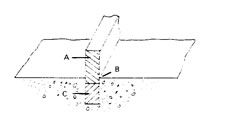 If one applies cement to the wall, one reduces [the size of the enclosure],47 although [the cement] is not substantial enough to stand as a separate entity.48
If one applies cement to the wall, one reduces [the size of the enclosure],47 although [the cement] is not substantial enough to stand as a separate entity.48[The following rule applies when an area which is larger than the space required to sow two seah of grain is located on a mound:] If one builds a wall [with the intent of enclosing the area for habitation] at the edge of the mound, it is not of consequence,49 for a partition that is built on top of another partition is of no consequence.50
[The following rule applies when] a wall [that was constructed for the purpose of habitation was built] on top of a wall [that was not constructed for the purpose of habitation,]51 the lower wall sunk within the ground,52 and the upper wall remained: Since the upper wall was constructed for the purpose of dwelling, and it is the only [wall] visible at present, it is [now] considered of consequence and one may carry within the entire [enclosure].
ט
טח את הכותל בטיט אע"פ שאינו יכול לעמוד בפני עצמו הרי זה מיעוט. הרחיק מן התל שלשה ועשה מחיצה הועיל. עשה מחיצה על שפת התל אינו מועיל שהעושה מחיצה על גבי מחיצה אינו מועיל. נבלעה מחיצה התחתונה והרי העליונה קיימת. הואיל ונעשית העליונה לשם דירה והרי אין שם נראה אלא היא הרי זה הועיל ומותר לטלטל בכולה:
10
We may carry only within [a square of] four cubits in a yard53 that is located behind [a group of] houses larger than the space necessary [to sow] two seah [of grain], even when there is an opening from [one of] the homes to [the yard].54
If one opens an entrance [from one of the homes] to [the yard] and then encloses it, [the yard] is considered as enclosed for the purpose of habitation, and we are permitted to carry throughout its total [area].55
י
רחבה שאחורי בתים יתירה על בית סאתים אין מטלטלין בה אלא בארבע. ואפילו היה פתח הבית פתוח לתוכה. ואם פתח הפתח לשם ואחר כך הקיפה הרי זו כמוקפת לדירה ומותר לטלטל בכולה:
11
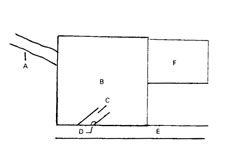 [Permission is granted to carry within] a yard56 that opens to a city at one side and a path that leads to a river on the other [in the following manner]:57 If one erects a post58 at the side near the city, it is permitted to carry within [the yard], from [the yard] to the city,59 and from the city to [the yard].
[Permission is granted to carry within] a yard56 that opens to a city at one side and a path that leads to a river on the other [in the following manner]:57 If one erects a post58 at the side near the city, it is permitted to carry within [the yard], from [the yard] to the city,59 and from the city to [the yard].יא
רחבה הפתוחה למדינה מצד אחד ומצד אחר פתוחה לשביל המגיע לנהר. עושה לה לחי מצד המדינה ויהיה מותר לטלטל בכולה ומתוכה למדינה ומן המדינה לתוכה:
12
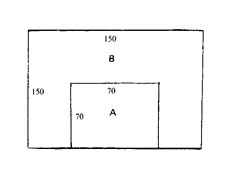 [The following rules apply when] an individual spends the Sabbath in an open valley and constructs a partition60 around his [immediate area]: If [the enclosed area] is the size of the area in which two seah [of grain can be sown] or less, he may carry within the entire [enclosed area]. If [the enclosed area] is larger, he may carry only within [a square of] four cubits.61
[The following rules apply when] an individual spends the Sabbath in an open valley and constructs a partition60 around his [immediate area]: If [the enclosed area] is the size of the area in which two seah [of grain can be sown] or less, he may carry within the entire [enclosed area]. If [the enclosed area] is larger, he may carry only within [a square of] four cubits.61The same [rules apply when] two individuals [spend the Sabbath in an open valley]. When, however, three or more Jews62 spend the Sabbath in an open valley [and erect a partition enclosing their immediate area], they are considered a caravan and they are allowed to carry as far as necessary,63 even several millim, provided there is not a space larger than the area [necessary to sow] two seah left vacant without utensils. If, however, [the enclosed area] includes a space larger than the area [necessary to sow] two seah that is left vacant without utensils, and that is of no use to them,64 they are allowed to carry only within [a square of] four cubits within the enclosure.65
A minor66 is not included in [the reckoning of the minimum number of people necessary to compose] a caravan.
יב
יחיד ששבת בבקעה ועשה מחיצה סביב לו אם יש בה עד בית סאתים מותר לטלטל בכולה. ואם היתה יתר על בית סאתים אינו מטלטל בה אלא בארבע אמות. וכן אם היו שנים. אבל שלשה ישראלים או יתר עליהן ששבתו בבקעה הרי הן שיירא ומותר להם לטלטל בכל צרכן אפילו כמה מילין. והוא שלא ישאר מן המחיצה שהקיפו בית סאתים פנוי בלא כלים. אבל אם נשאר בית סאתים פנוי בלא כלים ולא היו צריכים לו אסורים לטלטל בכל המחיצה אלא בארבע אמות ואין הקטן משלים לשיירא:
13
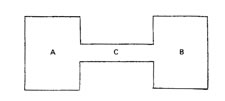 When three people enclose an area large enough for their needs67 and establish this as their place for the Sabbath, [those who remain] are allowed to [continue] carrying within the entire [enclosure]68 despite the fact that one of them dies [on the Sabbath].
When three people enclose an area large enough for their needs67 and establish this as their place for the Sabbath, [those who remain] are allowed to [continue] carrying within the entire [enclosure]68 despite the fact that one of them dies [on the Sabbath].[by contrast] two individuals establish [an enclosed area] larger than the space [necessary to sow] two seah [of grain] as their place for the Sabbath, they may carry only within four cubits despite the fact that a third person joins them [on the Sabbath]. [The rationale for both decisions is that the ruling] is determined by the manner in which the individuals establish [a site as] their place for the Sabbath [at the commencement of the Sabbath], and not on the number of people who are actually present [on the Sabbath day].69
יג
שלשה שהקיפו כדי צרכן וקנו שביתה ואחר כך מת אחד מהן הרי הם מותרין לטלטל בכולה. קנו שנים שביתה ביתר מבית סאתים ואחר כך בא להם שלישי אסורין לטלטל אלא בארבע אמות כשהיו קודם שיבוא זה. שהשביתה היא הגורמת לא הדיורין:
14
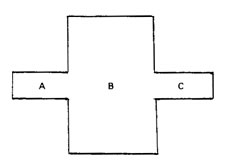 [Our Sages did not establish restrictions against carrying in the following instance:] Three areas that are enclosed for purposes other than habitation are located adjacent to each other, and lead70 to each other. The two outer enclosures are wide, while the middle enclosure is narrow. Thus, there are barriers around the outer enclosures on either side. If [three people spend the Sabbath in this place,] one in each of these enclosures, [the three] are considered as a caravan,71 and they are allowed to carry [wherever] necessary.72
[Our Sages did not establish restrictions against carrying in the following instance:] Three areas that are enclosed for purposes other than habitation are located adjacent to each other, and lead70 to each other. The two outer enclosures are wide, while the middle enclosure is narrow. Thus, there are barriers around the outer enclosures on either side. If [three people spend the Sabbath in this place,] one in each of these enclosures, [the three] are considered as a caravan,71 and they are allowed to carry [wherever] necessary.72If the middle enclosure is wide, while the two outer enclosures are narrow, there are barriers around the middle enclosure on either side. [Thus,] it is considered separate. Therefore, [if three people spend the Sabbath in this place,] one in each of these enclosures, they are not allowed to carry without restriction.73 Instead, each one is allowed to carry within his own enclosure [provided it is smaller74than the space necessary to sow] two seah [of grain].
If a single individual [spends the Sabbath] in each [of the outer enclosures], while two people are in the middle enclosure, or two people [spend the Sabbath] in each [of the outer enclosures], while one person is in the middle enclosure, they are allowed to carry [wherever] necessary.75
יד
שלשה מקומות המוקפין שלא לשם דירה זה בצד זה ופתוחים זה לזה שנים החיצונים רחבים והאמצעי קצר שנמצאו לשנים החיצונים פסין מכאן ומכאן והיה יחיד בזה ויחיד בזה ויחיד בזה נעשו כשיירא ונותנין להם כל צרכן. היה האמצעי רחב ושנים החיצונים קצרים שנמצא האמצעי בפסין משני רוחותיו הרי הוא מובדל משנים החיצונים. לפיכך אם שבת יחיד בזה ויחיד בזה ויחיד בזה אין נותנין להן כל צרכן אלא כל אחד ואחד יש לו בית סאתים במקומו. היה יחיד בזה ויחיד בזה ושנים באמצעי או שנים בזה ושנים בזה ואחד באמצעי נותנין להן כל צרכן:
15
Any partition76 that cannot stand in the face of an ordinary wind is not considered a significant partition.77 [Similarly,] any partition which is not constructed in a lasting manner78 is not considered a significant partition. [Likewise,] a partition constructed only for the purpose of modesty79 is not considered a significant partition.
Any partition that is not ten handbreadths high is not considered to be a complete partition.80 A mound81 five handbreadths high and a partition [on top of it] five handbreadths [high] are combined [and together are considered to be a valid partition].
טו
כל מחיצה שאינה יכולה לעמוד ברוח מצויה אינה מחיצה. וכל מחיצה שאינה עשויה לנחת אינה מחיצה. וכל מחיצה שאינה עשויה אלא לצניעות בלבד אינה מחיצה. וכל מחיצה שאין בגובהה עשרה טפחים או יותר אינה מחיצה גמורה. גידוד חמשה ומחיצה חמשה מצטרפין:
16
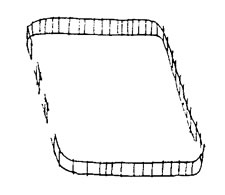 Any partition whose open portion exceeds its closed portion is not considered to be a partition.82 If, however, the open portion is equivalent to its closed portion, it is permitted [to carry within the enclosure], provided none of the open portions is larger than ten cubits wide.83 [The rationale for this leniency is that an open space] ten cubits [or less] is considered to be an entrance.84
Any partition whose open portion exceeds its closed portion is not considered to be a partition.82 If, however, the open portion is equivalent to its closed portion, it is permitted [to carry within the enclosure], provided none of the open portions is larger than ten cubits wide.83 [The rationale for this leniency is that an open space] ten cubits [or less] is considered to be an entrance.84If, however, this open space [is enclosed by] the frame of an entrance,85, even if it is wider than ten cubits the partition is not considered to be nullified,86 provided the open space does not exceed the closed portion.87
טז
כל מחיצה שיש בה פרוץ מרובה על העומד אינה מחיצה. אבל אם היה פרוץ כעומד הרי זו מותרת. ובלבד שלא יהיה באותן הפרצות פרצה שהיא יתר על עשר אמות. אבל עשר אמות הרי היא כפתח. אם היה לפרצה זו צורת פתח אף על פי שיש בה יותר מעשר אינה מפסדת המחיצה. והוא שלא יהא הפרוץ מרובה על העומד:
17
When does the above apply? When the open spaces are three handbreadths or wider. If, however, the open spaces are each less than three handbreadths,88 the partition is acceptable although the total open space exceeds the space which is enclosed. For whenever there is an opening of less than three handbreadths, the portions separated in this manner are considered as parts of a solid partition.
יז
במה דברים אמורים בזמן שהפרצות משלשה טפחים ולמעלה. אבל אם היו הפרצות כל פרצה מהן פחותה משלשה הרי זו מותרת. ואף על פי שהפרוץ מרובה על העומד. שכל פחות משלשה הרי הוא כלבוד:
18
What does the above imply? For example, a person makes an enclosure with reeds - as long as there is less than three handbreadths between one reed and the next, the partition is fully acceptable. Similarly, if one makes a partition with ropes, as long as there is less than three handbreadths between one rope and the next [the partition is fully acceptable]. [The above applies] even when the [reeds or ropes] run vertically but not horizontally,89 or horizontally but not vertically.90
The height of the reeds must be at least ten [handbreadths], or there must be ten handbreadths from the earth to the top of the highest rope if one makes an enclosure with rope. For a partition cannot be less than ten handbreadths high. All these measures are part of the oral tradition transmitted to Moses on Mount Sinai.91
יח
כיצד הרי שהקיף בקנים ואין בין קנה לחבירו שלשה טפחים. או שהקיף בחבלים ואין בין חבל לחבירו שלשה טפחים. הרי זו מחיצה גמורה. אף על פי שהיא שתי בלא ערב או ערב בלא שתי. וצריך שיהיה גובה הקנה עשרה או שיהיה מן הארץ עד סוף עובי החבל העליון עשרה אם הקיף בחבלים. שאין מחיצה פחותה מעשרה. וכל השיעורין האלו הלכה למשה מסיני הן:
19
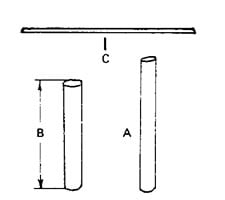 Whenever the term "frame of an entrance" is mentioned, it refers to a structure that has at the very least one reed at either side and another reed above them.92 [There is a further leniency:] The height of the posts at the sides must be at least ten handbreadths, but it is not necessary for the reed or other material placed above them to touch them. Even if it is several cubits above them,93 since the posts at the side are ten [handbreadths] high, [the structure] is considered to be a frame of an entrance.
Whenever the term "frame of an entrance" is mentioned, it refers to a structure that has at the very least one reed at either side and another reed above them.92 [There is a further leniency:] The height of the posts at the sides must be at least ten handbreadths, but it is not necessary for the reed or other material placed above them to touch them. Even if it is several cubits above them,93 since the posts at the side are ten [handbreadths] high, [the structure] is considered to be a frame of an entrance.The frame of an entrance mentioned94 must be sturdy enough to hold a door.95 Nevertheless, [the door need not be of a heavy substance;] a door of straw is also sufficient.
יט
צורת פתח האמורה בכל מקום היא אפילו קנה וכיוצא בו מכאן וקנה מכאן וקנה על גביהן. גובה שני הלחיים עשרה טפחים או יתר והקנה וכיוצא בו שעל גביהן אף על פי שאינו נוגע בשני הלחיים אלא יש ביניהן כמה אמות הואיל וגובה הלחיים עשרה הרי זו צורת פתח. וצורת פתח שאמרו צריכה שתהא בריאה לקבל דלת אפילו דלת של קש:
20
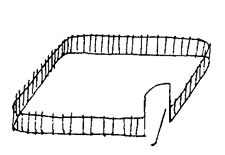 When the upright portions of the sides of an entrance that is structured in the form of an arch are ten [handbreadths] high,96 it is considered to be a "frame of an entrance."
When the upright portions of the sides of an entrance that is structured in the form of an arch are ten [handbreadths] high,96 it is considered to be a "frame of an entrance."A frame of an entrance that is constructed at the side of a partition97 is not significant, for it is not common for entrances to be constructed at the corner [of a wall],98 but rather in its center.
כ
פתח שצורתו כיפה אם יש באורך רגלי הכיפה עשרה טפחים הרי זה צורת פתח. וצורת פתח שעשה אותה מן הצד אינה כלום שאין דרך הפתחים להיות בקרן זוית אלא באמצע:
21
A partition may be made from any substances:99 utensils, food stuffs, or human beings.100 Even livestock101 and other animals and birds [may be used for this purpose] provided they are bound102 so that they will not depart.
כא
בכל עושין מחיצה בין בכלים בין באוכלים בין באדם אפילו בבהמה ושאר מיני חיה ועוף והוא שיהיו כפותים כדי שלא ינודו:
22
A partition that arises on its own accord103 is acceptable. Similarly, a partition that is erected on the Sabbath is considered to be a partition.104 If it is constructed unintentionally, carrying within [the enclosed area] is permitted on that Sabbath,105 provided it is not constructed with the knowledge of those who carry within.
If, however, a person intends that a partition be erected on the Sabbath, he is forbidden to carry within [the enclosure] on that Sabbath, even though the person who actually constructed the partition did not do so with the intent of violating [the Sabbath laws].106 Similarly, if [a partition] is erected with a conscious intent to violate [the Sabbath laws], it is forbidden to carry within [the enclosure]107 even if [the person who erected the structure] did not intend to carry within it.
כב
מחיצה העומדת מאליה הרי זו כשרה. ומחיצה הנעשית בשבת הרי זו מחיצה. ואם נעשית בשגגה מותר לטלטל בה באותה שבת. והוא שתעשה שלא לדעת המטלטל. אבל אם נתכוין אדם לזו המחיצה שתעשה בשבת כדי לטלטל בה אע"פ שעשה אותה העושה בשגגה אסור לטלטל בה באותה שבת. וכן אם נעשית במזיד אף על פי שלא נתכוין זה לטלטל בה הרי זה אסור לטלטל בה:
23
It is permitted to erect a human partition on the Sabbath - i.e., people standing next to each other108 - provided that the people whose bodies form the partition do not know that they are standing there for that purpose.109 Nor may the person who desires to use this enclosure be the one who has them stand there.110 Instead, another person should have them stand there without the knowledge of [the person who will benefit from the enclosure].111
כג
מותר לעשות מחיצה של בני אדם בשבת שיעמוד זה בצד זה ובלבד שלא ידעו אלו העומדין שבשביל לעשותן מחיצה העמידן. ולא יעמיד אותן אדם שהוא רוצה להשתמש במחיצה זו אלא יעמיד אותן אחר שלא לדעתו:
24
The branches of a tree which hang downward and which reach within three handbreadths of the earth [may serve as an enclosure].112 One should place straw, stubble, and the like between the branches and the leaves, and should tie them to the earth so that they will stand firmly and not flutter in the face of an ordinary wind.113 [When this is done,] one may carry under the entire [tree].
[The above applies] when there is less than the space [necessary to sow] two seah [of grain beneath the tree]. If, however, the area [below the tree] is larger than that, we are allowed to carry only within four cubits [in this space], since the space beneath [the tree] was enclosed for purposes other than dwelling.114
כד
אילן שהוא מיסך על הארץ אם אין נופו גבוה מן הארץ שלשה טפחים ממלא בין בדיו ועליו תבן וקש וכיוצא בהן וקושרן בארץ עד שיעמוד ברוח מצויה ולא יתנדנד ומטלטל תחת כולו. והוא שיהיו תחתיו עד בית סאתים. אבל אם היה יתר מבית סאתים אין מטלטלין תחתיו אלא בארבע אמות מפני שתחתיו מקום שלא הוקף לדירה הוא
FOOTNOTES
1.The majority of this chapter is devoted to an explanation of the laws pertaining to a karpef, a large area that is enclosed by four walls, but these walls were not constructed for the purpose of habitation.
Since this area is enclosed by four walls, it is considered a private domain according to Torah law. Therefore, one is liable for transferring articles to and from it. Nevertheless, as the Rambam c ontinues, the Rabbis imposed certain restrictions on carrying within this space for the reasons mentioned below. We are, however, allowed to carry within an area enclosed for the purpose of habitation regardless of how large it is (Rambam's Commentary on the Mishnah, Eruvin 2:5).
2.The size of this space is defined in Halachah 3.
3.Since this is a large space in which there are no inhabitants, it appears to resemble a public domain or a carmelit. Accordingly, the Sages placed certain restrictions on carrying within it, lest one err and carry in the public domain as well (Shulchan Aruch HaRav 358:1).
4.A surface four handbreadths by four handbreadths that is elevated ten handbreadths above the ground is considered to be a private domain.
5.I.e., although it is a private domain according to Torah law, our Sages forbade carrying upon it for the reasons explained in the previous halachah.
6.Although one is allowed to carry from one carmelit to another, one may not carry more than a total of four cubits.
7.If it is less than four handbreadths by four handbreadths, it is a makom patur, and there is no difficulty in carrying from it to the sea or from the sea to it.
8.A rock that is this high above the sea and this size is considered to be a private domain.
9.Although our Sages generally forbade transferring an article from a private domain to a carmelit, since this is a very unusual circumstance they did not include it in their decree.
10.Eruvin 23b identifies the area in which two seah of grain can be sown with the courtyard of the Sanctuary in the desert, which was 100 cubits by 50 cubits.
The Shulchan Aruch HaRav explains the significance of this concept. All of the prohibitions against labor on the Sabbath are derived from the Sanctuary. The courtyard of the Sanctuary was a large area which was enclosed for purposes other than habitation. Nevertheless, it was permitted to carry within it. Therefore, when the Sages prohibited carrying in large areas that were enclosed for purposes other than habitation, they used the size of the courtyard of the Sanctuary as the lower limit.
11.Here we see a contrast to the measures of four handbreadths by four handbreadths or four cubits by four cubits, where the intent is a square or a larger area in which such a square could be inscribed.
12.In his Commentary on the Mishnah (Eruvin 2:5), the Rambam states that the square is approximately 70 cubits and five sevenths of a cubit by 70 cubits and five sevenths of a cubit, but that there is no perfect square root for the number 5000.
13.This is obvious from the connection to the courtyard of the Sanctuary, which, as mentioned, was a rectangle and not a square.
14.Note the Rambam's explanation of the difference in opinion between Rabbi Yosse and Rabbi Eliezer, in his Commentary on the Mishnah (Eruvin 2:5). On the basis of this explanation, it would appear that his conception of the Mishnah is closer to that of Tosafot, Eruvin 23b than to that of Rashi (loc. cit.).
15.As in a carmelit.
16.Hence, when such an open area does not resemble the courtyard of the Sanctuary, the leniency does not apply.
17.Once this extent of a wall has been broken down, it is considered as if the entire wall is no longer of significance as indicated in Halachah 16.
18.When one re-encloses the wall, it is considered as if the entire enclosure has been made for the purpose of habitation. Therefore, the area is considered to be an ordinary private domain, and one is allowed to carry within without restriction.
The Maggid Mishneh questions the Rambam's statements on the basis of those of Rashi, Eruvin 24a, which state that the intent to use the enclosure for habitation is not sufficient. There must be a house that opens up to the enclosure.
The Merkevet HaMishneh states that, according to the Rambam, "habitation" does not necessarily mean "human habitation." Therefore, the intent could be to use the enclosure as a corral for animals or the like. Rav Kapach cites the Rambam's Commentary on the Mishnah (Eruvin 2:5), from which it appears that as long as there is a storage vat in the enclosure, it is considered as "enclosed for the purpose of habitation," although it does not contain a house or lead to a house.
Thus according to the Rambam, "everything depends on the person's intention." If he encloses the area for the sake of habitation, he is allowed to carry freely within it. Why is this leniency granted? Because the prohibition against carrying within such an area is Rabbinic in origin, and the Sages enforced this stringency only when a person's intent was not for the sake of habitation, for then the enclosure resembles a public domain. The Shulchan Aruch (Orach Chayim 358:2), however, follows Rashi's view, that a house is required within the enclosure or the enclosure must lead to a home.
19.Since the entire enclosure was never opened up for ten cubits at one time, one might assume that the original enclosure was never nullified. Nevertheless, since ultimately a span of ten cubits was constructed, the enclosure is considered as פנים חדשות, "a new entity" (Shulchan Aruch HaRav 358:8). Note a parallel ruling in Hilchot Kellim 6:2.
20.A mil is approximately a kilometer in contemporary measure.
21.Although the area was enclosed for the purpose of habitation originally, since it is large and the person sowed produce within the majority of its space, it is clear that he considers it to be a commercial field or garden. It is not common for people to dwell in such a place (Rashi, Eruvin 23b).
22.I.e., one may carry only within a square of four cubits even in the portion of the enclosure where the produce was not sown, because there is no barrier enclosing the area on the side that faces the portion where the produce has been sown (Maggid Mishneh). Alternatively, the portion in which the produce was not sown is considered to be a secondary part of the entire field in which it is forbidden to carry (Rashi, Eruvin 24a).
23.Obviously, if produce was sown in a smaller portion of the enclosure, the same leniency applies. The portion of a field necessary to sow two seah of grain is the upper limit.
24.In such an instance, the portion of the enclosure in which produce was sown is considered like a private garden a person has in his yard.
It must be noted that in this instance, the Shulchan Aruch (Orach Chayim 358:10, following the opinion of Rabbenu Asher) is more stringent than the Rambam and forbids carrying an article from the garden to the house.
25.Since the produce was planted in such a large area, it is considered like a commercial garden or field.
26.In this instance, the commentaries quote the opinion of the Maggid Mishneh mentioned above: that the portion of the enclosure facing the side where the produce has been sown is not considered to be enclosed.
The Turei Zahav 358:6 is more lenient and explains that since according to the Torah, one could carry within the entire enclosure, even according to Rabbinic law one should be allowed to carry within the portion where produce was not sown. His opinion is not, however, accepted by the later authorities.
27.The Mishnah Berurah 358:63 states that this ruling applies even when one planted trees throughout the entire enclosure.
28.It is a common practice to plant trees in one's yard for shade. Hence, planting them is not considered to be a sign that one no longer considers the enclosure to be intended for the purpose of habitation.
29.The Rashba states that this applies when the water is ten handbreadths or more deep. If it is shallower than that, there are no restrictions on carrying within the enclosure. Although Sefer HaBatim differs with this interpretation, the Rashba's ruling is accepted by the Shulchan Aruch (Orach Chayim 358:11).
30.Rashi (Eruvin, loc. cit.) states that the water must be fit to drink. The Rashba and other Sephardic authorities state that it is sufficient that the water be fit for laundry and the like. This appears to be the Rambam's view. Although the Shulchan Aruch (loc. cit.) quotes Rashi's view, Sha'ar HaTziyun 358:81 states that one may rely on the Rashba's ruling.
31.For, indeed, it is an advantage to have a source of water near one's home. Hence, the water does not nullify the enclosure (Rashi, loc. cit.).
32.From the gloss of the Magen Avraham 358:15, it appears that if the area in which the water is collected is set off from the enclosure as a whole because its height descends abruptly, we may carry within the remainder of the enclosure.
33.The Maggid Mishneh explains that according to the Rambam's interpretation of Eruvin 25a, this refers to a roof that is open on all sides, which the watchmen in a garden construct for shade. The Rashba interprets that passage as referring to a roof with two proper walls that are joined at one corner. Rabbenu Chanan'el's interpretation of that passage also indicates that the sides of the covered area are entirely open.
34.Note the Kessef Mishneh and the Shulchan Aruch (Orach Chayim 358:12), where Rabbi Yosef Karo states that this principle applies even when the roof is sloped. Generally, the principle, "The edge of the roof is considered to descend and close off," does not apply with regard to a sloped roof. Nevertheless, since according to the Torah itself, it is permitted to carry within this enclosure, leniency is allowed. (Compare also to Chapter 17, Halachah 35.)
It must be emphasized that according to the Maggid Mishneh's understanding of the Rambam's rulings (see note 33), this entire matter is extraneous.
35.Thus, the remainder of the enclosure is not larger than the space necessary to sow two seah of grain. Hence, there are no restrictions against carrying within it.
36.This represents the Rambam's interpretation of a passage in Eruvin 25b. Although Rabbenu Chanan'el and Rav Zerachiah HaLevi interpret the passage in this manner, the Ra'avad, Rashi, the Rashba and others follow a slightly different version of the text, and therefore interpret the passage differently. Their interpretation is quoted in the Shulchan Aruch (Orach Chayim 358:13).
37.According to the Maggid Mishneh (and seemingly, also according to Rabbenu Chanan'el), both openings are no more than ten cubits wide. Otherwise, it would be forbidden to carry within the courtyard.
38.The Maggid Mishneh and others explain that the Rambam is referring to a T-shaped area in which the enclosure opens up to the courtyard, which extends on either side. The enclosure is not considered part of the courtyard, nor is the courtyard considered part of the enclosure, and the laws that originally applied to both areas continue to apply.
According to the Maggid Mishneh, this clause is not a continuation of the first clause of this halachah, but rather a separate concept in its own right. Rav Kapach, however, notes that both the Talmud (Eruvin, loc. cit.) and the Rambam link this and the previous clause together. On this basis, he follows the interpretation of Rabbenu Chanan'el, which states that the unroofed area of the enclosure was originally not larger than the space for two seah of grain to be sown within it. Therefore, we were permitted to carry within it. When, however, the wall connecting it to the courtyard was torn down, the open space was increased and became larger than the space for two seah of grain to be sown within it. Hence, it became forbidden to carry within it.
39.I.e., we do not say that the enclosure becomes considered as an extension of the courtyard.
40.So that one will be able to carry within it.
41.Since it is common to plant trees in such enclosures, even when the trees are ten handbreadths high and four handbreadths by four handbreadths in area (at which point they are considered to be a separate domain in certain contexts), they do not reduce the size of the enclosure (Maggid Mishneh in the name of the Rashba).
42.Rashi interprets Eruvin 25a, the source for this halachah, as referring to a pillar of this size, whether it is in the middle of the enclosure or next to the wall. Rashi's interpretation is followed by the Shulchan Aruch (Orach Chayim 358:5).
43.Thus, if the area of the enclosure minus the area of the pillar is less than 5000 square cubits, one is allowed to carry within it.
44.Based on the principle of l'vud, the pillar is not considered to be an independent entity, but rather an extension of the wall. Therefore, although in practice, the open space within the enclosure has been reduced in size, this reduction is not considered as halachically significant.
45.I.e., the size of the enclosure is calculated from the new partitions. If it is less than 5000 square cubits, one may carry within. It must be noted that, with regard to this clause as well, Rashi interprets the Talmudic passage differently, explaining that the new partition is erected to enclose the area for the purpose of habitation. His interpretation is accepted by the Shulchan Aruch (loc. cit.:6).
46.Because of the principle of l'vud.
The Maggid Mishneh questions this ruling on the basis of the first clause of the following halachah, which states, "If one applies cement to the wall, one reduces [the size of the enclosure]." Since the cement reduces the size of the enclosure, even though it actually becomes part of the wall, one could surely assume that a new partition would reduce the size of the wall although it is considered part of the wall because of the principle of l'vud.
The Maggid Mishneh explains that since the partition is halachically insignificant, it cannot take the place of the previous wall. Hence, it is not considered to reduce the size of the enclosure. In contrast, the cement adds on to the size of the previous wall, and the space it takes up is subtracted from the open space of the enclosure.
47.I.e., if the entire space taken up by the cement that is added to the wall is sufficient to reduce the size of the enclosure to less than 5000 square cubits, one may carry within the enclosure.
48.In this instance as well, the Ra'avad differs with the Rambam. Based on his interpretation of Eruvin 25a, the cement is counted only when it is substantial enough to stand on it is own if the original wall was removed. Although the Shulchan Aruch (Orach Chayim 358:7) follows the Ra'avad's view, the Mishnah Berurah 358:55 states that the Rambam's opinion may be relied upon in time of need.
49.We are speaking about a mound ten handbreadths high which is considered as set apart as a separate domain. Since the area is being surrounded by a partition that is constructed for the purpose of dwelling, one might think that it would be permissible to carry within the enclosure. Nevertheless, this is forbidden for the reason stated by the Rambam.
50.Since the mound, the original dividing point for the enclosure, is still standing, the new walls built are not considered significant.
51.As mentioned in the previous clause, as long as the original wall is visible, the new wall is of no consequence.
52.And less than ten handbreadths of the original wall extends above the ground (Mishneh Berurah 358:57).
53.Our translation is based on the Mishnah Berurah 359:1, which states that in Talmudic times there would be yards both in front and behind the homes. A yard in front of a home was referred to as a חצר. These were frequently used by the people of that era and mentioned often in the Talmud. A yard behind a home was referred to as a רחבה, a term used comparatively rarely in the Talmud. These yards were used infrequently by people of that era.
54.As apparent from the following clause, this applies when the yard was enclosed before an entrance leading to one of the homes was opened.
The Ramah (Orach Chayim 359:1) rules that the restriction mentioned in this law does not apply at present, since it has become customary to use our back yards. Hence, we assume that they were enclosed for the purpose of habitation.
55.Eruvin 24a states that this leniency applies even when a portion of the yard is used as a threshing floor. Since the person enclosed the area after opening an entrance to his home, we assume that the yard's primary purpose is to serve the home.
56.The yard is larger than 5000 square meters and was enclosed for purposes other than habitation (Rashi, Eruvin 24b).
57.The Rambam's decision is based on the description of such a yard in Eruvin 24b.
58.Using a post, a lechi, as a divider is discussed in Chapter 17, Halachot 2 and 9.
As the Rambam mentions there, the post is considered as a fourth wall. In this instance, by erecting the post, one will be considered as erecting a new wall to enclose the yard for the sake of habitation (Rashi, loc. cit.).
59.This refers to a city surrounded by a wall, which is considered to be a private domain.
60.This refers even to an inferior partition, such as those mentioned in Halachah 18. Rashi (Eruvin 16b, the source for this halachah) states that the restrictions of this law apply only when the enclosure uses such an inferior partition. If a proper partition is erected, one may carry within the entire enclosure, since the enclosure was erected for the purpose of habitation. Note the Merkevet HaMishneh, who emphasizes that the Rambam does not accept this leniency.
The wording of the Shulchan Aruch and the Beit Yosef (Orach Chayim 360:1) appears to concur with Rashi's view. The later authorities also accept his ruling.
61.Since the area is so large and it is enclosed only for a temporary period, the Sages placed restrictions on carrying within it.
It must, however, be emphasized that according to Torah law, the enclosure is considered a private domain. Accordingly, a person who carries from it to a public domain or from a public domain to it is liable (Shulchan Aruch HaRav 360:1; Mishnah Berurah 360:5).
62.With this term, the Rambam excludes a gentile. The Ramah (loc. cit.) also rules that a gentile may not be included in a caravan.
63.According to Torah law, such an area is a private domain. The Rabbis did not place any restrictions upon it, because it has - albeit temporarily - been enclosed for the purpose of habitation.
64.See Shulchan Aruch HaRav 360:2, which mentions that it is acceptable if the land is used for pasture.
65.Since the enclosure includes such a large empty space, our Sages forbade carrying within it.
Based on the Mordechai, the Shulchan Aruch mentions a further leniency: If three people spend the Sabbath in an enclosure whose area is less than 18,000 square cubits, they are allowed to carry without restriction. The rationale is: Each individual is granted 5000 square cubits. Thus, there are less than 5000 square cubits that are not accounted for. This leniency is not, however, accepted by the other authorities.
66.The Jerusalem Talmud (Eruvin 1:10) does not resolve the question whether or not to count a child as a member of the caravan. In his Beit Yosef (loc. cit.), Rav Yosef Karo questions the Rambam's decision, for generally we follow the rule that when a doubt exists pertaining to a question of Rabbinic law, the more lenient view should be followed. Accordingly, he does not mention the matter in his Shulchan Aruch. The Ramah cites the Rambam's view, but prefaces it with the phrase "There are those who maintain," which implies that the opinion cited is not accepted universally.
67.I.e., greater than 5000 square cubits.
68.This leniency applies only on the Sabbath on which the person dies. On the following Sabbath, they are forbidden to carry unless they are joined by a third individual.
69.See a further expression of this principle in Hilchot Eruvin 3:25.
70.I.e., the middle enclosure does not have a wall, but is totally open on either side (Shulchan Aruch, Orach Chayim 360:3). The Shulchan Aruch, however, follows the interpretation of the Ritba, who requires the walls of the narrow courtyard to enter into the space of the wider courtyard. The Rambam, however, does not appear to make such a requirement.
71.Since the individuals in each of the outer courtyards are considered as sharing the space of the middle courtyard.
72.I.e., they may carry freely from one enclosure to another. Note the Shulchan Aruch (loc. cit.), which states that they must make an eruv to join their respective enclosures together. Similarly, the Shulchan Aruch mentions a more restrictive opinion, which allows the individuals to carry freely only when the outer enclosures are less than 5000 square cubits in size.
73.I.e., the outer enclosures are considered to be distinct entities without any connection to each other. Thus it is not considered as if three people are spending the Sabbath in the same place.
74.The bracketed additions are based on the commentary of Rashi (Eruvin 93a, the source for this halachah) and the Shulchan Aruch (loc. cit.).
75.In both of these instances, three individuals share a single portion of space. Therefore, they are allowed to carry freely from one enclosure to another.
76.In this halachah, the Rambam begins to describe the rules that govern the walls that enclose a private domain. The concepts he mentions are also relevant to the laws of sukkah and other contexts within Jewish law.
77.I.e., it is as if the partition were not there. See notes below.
Rashi, Sukkah 24b, states that this applies not only when the wall will fall because of the wind, but also to a cloth wall that will blow back and forth. From Halachah 24, it appears that this ruling is also accepted by the Rambam. It is quoted by the Shulchan Aruch (Orach Chayim 362:1 and 630:10).
78.Our translation follows Rabbenu Chanan'el's text of Eruvin 26a. According to this interpretation, our Sages are teaching us that a partition must be constructed in a firm and sturdy fashion. (See also the interpretation of the term in the Aruch.) See also Halachah 12 and notes.
The Ra'avad, Rashi, and others follow a different text of the Talmud, which reads כל מחיצה העשויה לנח ת. According to this interpretation, this refers to a partition erected for storage purposes and not for people to dwell within. This latter view is quoted by the Shulchan Aruch (Orach Chayim 362:1).
79.The commentaries on Eruvin (loc. cit.) interpret this as a temporary partition that builders construct for shade. (Rav Kapach, however, cites interpretations of the Geonim that interpret the term "for the sake of modesty" literally, to change one's clothes behind.)
Thus, all three partitions mentioned in this halachah share the same drawback; they are not constructed in a lasting or sturdy manner.
In his gloss on this halachah, the Maggid Mishneh quotes the Rashba, who mentions that since all these partitions are valid according to Torah law, the expression "they are not partitions" must be interpreted as follows: They are not partitions constructed for the purpose of habitation. Therefore, if an area larger than 5000 square cubits is enclosed with such a partition, it is forbidden to carry within. If, however, an area less than 5000 square cubits is enclosed by such a partition, one may carry within. This opinion is quoted by the Tur and the Shulchan Aruch (loc. cit.).
The Lechem Mishneh, the Beit Yosef (Orach Chayim 362) and others maintain that the Rambam does not accept the Rashba's view. Kinat Eliyahu, however, notes that the fact that the Rambam mentions these laws directly after the laws concerning a karpef may have been intended to allude to the Rashba's concept.
80.The Maggid Mishneh interprets the phrase "it is not a complete partition" to mean: It is not a partition significant enough to cause an enclosure to be considered to be a private domain. It may, however, cause an enclosure to be considered to be a carmelit.
81.Our translation is based on the gloss of the Maggid Mishneh, which is quoted by the Shulchan Aruch (Orach Chayim 362:2).
See also the interpretation of Rabbenu Chanan'el to Eruvin 93b, which interprets it as a "rock." From a halachic perspective, these interpretations are not mutually exclusive. See Chapter 15, Halachah 9.
82.I.e., if a wall includes open spaces, the area that is open may not exceed the area that is enclosed. As mentioned in the following halachah, this refers to open spaces that are larger than three handbreadths wide. As the Rambam states in Halachah 18, this refers to spaces in the horizontal as well as the vertical portion of the wall.
83.I.e., when there is an open space larger than ten cubits wide, the entire partition is nullified.
84.As long as the opening is ten cubits wide or less, there is no need to enclose it with a frame of an entrance. It is commonplace for a wall to have an entrance that is less than ten cubits wide without a frame.
85.The Rambam explains the structure of a frame of an entrance (tzurat hapetach) in Halachah 19.
86.I.e., by erecting the frame of an entrance, one enables a partition to be considered acceptable despite the fact that it has an opening that is larger than ten cubits.
87.This ruling represents a point of difference between the Rambam and most other authorities. According to the Rambam, although the frame of an entrance enables an opening larger than ten cubits to be accepted, the opening is still considered an open space. Accordingly, if the total amount of open space on any one side of a partition exceeds the closed space, the partition is unacceptable, even though portions of the open space possess a frame of an entrance.
Many authorities (e.g., the Rashba and Tosafot, Eruvin 11a) differ and maintain that once a frame of an entrance is constructed, the space below it is deemed closed and should be considered as such when calculating whether the enclosed portion of a partition exceeds its open area. The opinion of these authorities is accepted by the Shulchan Aruch (Orach Chayim 362:10). Nevertheless, Shulchan Aruch HaRav 362:19 and the Mishnah Berurah 362:59 state that it is proper to be stringent and follow the Rambam's ruling.
Rabbenu Asher cites the Jerusalem Talmud (Eruvin 1:9) and Kilayim 4:2 as the source for the Rambam's ruling. (See also Hilchot Shofar V'Sukkah V'Lulav 4:12, where the Rambam accepts a more lenient view regarding the walls of a sukkah. Note also the glosses of the Kessef Mishneh and the Maggid Mishneh there.)
See also the commentary of Rav Kapach, who advances an interpretation of the Rambam's statements here and in his Commentary on the Mishnah (Eruvin 1:8) that maintains that the Rambam follows the view advanced by the Rashba. Even those who reject this interpretation in most instances are forced to accept it with regard to the third side of an alley, as stated in Chapter 17, Halachah 3. (Note also Chapter 17, Halachah 27.)
The difference between the Rambam's ruling and that of the other authorities is particularly relevant in contemporary communities that permit carrying because of an eruv. Most of these communities are enclosed, not by a proper wall, but by a series of "frames of an entrance" constructed using telephone poles and the like. According to the Rambam, these enclosures are not acceptable. Indeed, this is one of the reasons why the carefully observant refrain from carrying in these communities.
88.More precisely, the same ruling applies if some of the spaces are wider than three handbreadths, as long as the size of the total of the open spaces wider than three handbreadths does not exceed the remainder of the partition.
89.As the Rambam continues, a partition of reeds will generally be constructed by implanting them upright in the ground, one near the other. As long as the reeds are not three handbreadths apart, the partition is acceptable even if there are no reeds that run horizontally.
90.Generally, a partition of ropes will be constructed by stretching them from one post to another. As long as the ropes are not three handbreadths apart, the partition is acceptable, even if there are no ropes that run vertically.
91.In the Introduction to his Commentary on the Mishnah, the Rambam defines the Hebrew term halachah l'Mosheh miSinai as referring to laws that have no obvious source in the Written Torah, yet have been accepted throughout the centuries as an integral part of the Torah tradition.
92.As the Shulchan Aruch (Orach Chayim 362:11) emphasizes, the reed must be placed exactly above the two side posts. It is not acceptable for it to be attached to their sides, for then it does not resemble the lintel of a doorway.
93.In his gloss on this halachah, Rabbi Akiva Eiger explains that this is acceptable because of the principle gud asik - i.e., the posts at the side are considered to be extended until they reach the crossbar. Based on this rationale, it follows that the two posts need not be of the same height. Even if one is higher than the other, they may still be considered as part of the same frame of an entrance. (Note also the application of this principle in Hilchot Sukkah 4:2.)
94.According to the Shulchan Aruch (loc. cit.), this refers to the posts on the side. The crossbar above need not be sturdy at all.
95.The Rambam's decision is based on Eruvin 11b. His ruling, however, has aroused questions. The passage cited also mentions opinions that require the post to have a hinge for the door on at least one side. Although there are authorities who also accept the latter requirement, the Shulchan Aruch (loc. cit.) follows the Rambam's view.
96.I.e., the circular portion of the arch is not counted in the calculation of the entrance's height.
The commentaries draw attention to the Rambam's decision in Hilchot Mezuzah 6:4, where he also requires an arched doorway to have doorposts ten handbreadths high in addition to the arch, for the doorway to need a mezuzah. There is, however, a difference - and somewhat of a divergence - between the rationales the Rambam gives in both sources.
97.I.e., there is an opening of more than ten cubits at the corner where two walls would merge if they were continued. Even if one constructs a frame of an entrance at this opening, it is not acceptable. (See the Rambam's Commentary on the Mishnah, Eruvin 9:3.)
It must be noted that in their commentaries on Eruvin 11b, the source for this halachah, Rashi and the Rashba interpret the passage as referring, not to an entrance constructed at the corner of a wall, but to a lintel, projecting from the side of a doorpost. As mentioned in Halachah 19, the requirement for a frame of an entrance is for the lintel to be above the door posts and not projecting from their sides (Kessef Mishneh).
98.Note Chapter 17, Halachah 35, which mentions another law based on this same principle.
99.See parallels in Chapter 17, Halachah 12, and Hilchot Sukkah 4:16.
100.Unlike the animals that the Rambam proceeds to mention, a human being need not be bound, as is obvious from Halachah 23.
101.If the animal is standing and there are three handbreadths b etween the animal's body and the ground, that space must be filled with other substances (Shulchan Aruch HaRav 362:12).
102.Note that in Hilchot Sukkot (loc. cit.), the Rambam does not require that animals be bound when they serve as part of a wall. The Shulchan Aruch (Orach Chayim 630:11) states that the animals must be bound even when used for the purpose of a sukkah's wall.
103.The Shulchan Aruch (Orach Chayim 362:3) explains this as referring to a structure that was not built with the intent of enclosing an area, but accomplished that purpose nonetheless.
104.I.e., in all instances, the partition is considered valid, and the enclosure is considered a private domain. Therefore, a person who transfers an article into this enclosure from the public domain is liable. Our Sages, however, placed certain restrictions on carrying within such an enclosure, as the Rambam continues to explain.
105.I.e., the person who constructed the partition did so without knowing that it was the Sabbath or without knowing that it is forbidden to build on the Sabbath (Mishnah Berurah 362:18).
106.According to the Chemed Mosheh, this refers to a situation in which one person had another construct an enclosure for the former to carry within on the Sabbath. Although the person who actually constructed the enclosure did not intend to violate the Sabbath laws, the person for whom he performed the labor desired that such a violation take place. Hence, that person is prohibited from carrying within. This explanation resolves the question raised by the Rashba that is quoted by the Maggid Mishneh.
107.As mentioned in the notes on Chapter 6, Halachah 23, when a Jew intentionally performs a forbidden labor on the Sabbath, it is forbidden for other Jews to benefit from that labor on that Sabbath itself. The person who performed the labor, by contrast, is never permitted to benefit from it. Thus, in this instance, he would be forbidden from ever carrying within this enclosure on the Sabbath. (See Or Sameach.)
Note the Shulchan Aruch (loc. cit.), which states that if a partition had been standing before the Sabbath, it was removed on the Sabbath and then reconstructed on the Sabbath, it is permitted to carry within the enclosure. This applies even if the partition was rebuilt intentionally on the Sabbath. The Mishnah Berurah 362:26, however, cites authorities that do not accept this leniency.
108.I.e., within three handbreadths of each other (Shulchan Aruch, Orach Chayim 362:5). Note the Bayit Chadash (Orach Chayim 362) and the Be'ur Halachah 362, which question why the people may not be even further separated.
109.Although constructing a partition of this nature is not considered as building, it is still forbidden for the people who stand there to have in mind that their bodies serve as an enclosure, lest they come to treat the Sabbath prohibitions lightly (Mishnah Berurah 362:39).
110.The Rashba differs with this ruling and maintains that there is no difficulty if the person who desires to use the enclosure has the people stand there. According to his opinion, the only difficulty is when the people forming the partition have such an intent. The Shulchan Aruch (Orach Chayim 362:7) prefaces the quotation of the Rambam's ruling with the words, "There is one who says," which implies that it is not accepted by all. Similarly, the later authorities do not obligate compliance with this stringency.
Significantly, when discussing the use of human beings as part of the wall of a sukkah on the holiday, the Rambam (Hilchot Sukkah 4:16) states that the people serving as the wall may not know that their bodies are being used in that capacity, but the person sitting in the sukkah may have that intent.
111.Note the Ramah (Orach Chayim 362:7), who states that the leniency of using human beings to form an enclosure on the Sabbath should be employed only in a very extreme situation. He maintains that it is preferable to have a child bring in an article from the public domain without making an enclosure, rather than to have an adult carry the article in within an enclosure consisting of human beings. Although the later authorities raise questions regarding employing a child for this purpose, they accept the Ramah's hesitation about using an enclosure of human bodies.
112.For this rule to apply, there must be a place four handbreadths by four handbreadths in area and ten handbreadths high beneath the tree. Otherwise, the space is considered as a carmelit (Shulchan Aruch HaRav 362:2; Mishnah Berurah 362:5).
113.See Halachah 15. (See also Hilchot Sukkah 4:5, where the Rambam mentions similar concepts with regard to using a tree as a wall for a sukkah.)
114.As mentioned at the beginning of the chapter, when an area was enclosed for purposes other than habitation, one may not carry within it, if it is larger than the space necessary to sow two seah of grain - i.e., 5000 square cubits.
Shabbat - Chapter Seventeen
1
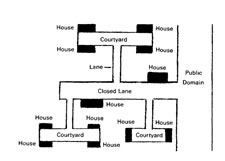 A lane with three walls is called a closed lane.1 In contrast, a lane that has only two walls, one opposite the other, and thus passersby enter from one end and leave from the other, is referred to as an open lane.2
A lane with three walls is called a closed lane.1 In contrast, a lane that has only two walls, one opposite the other, and thus passersby enter from one end and leave from the other, is referred to as an open lane.2א
מבוי שיש לו שלשה כתלים הוא הנקרא מבוי סתום. ומבוי שיש לו שני כתלים בלבד זה כנגד זה והעם נכנסין ברוח זו ויוצאין בשכנגדה הוא הנקרא מבוי המפולש:
2
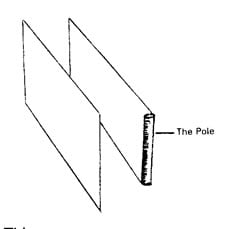 What must be done to allow people to carry within a closed lane?3 We should erect one pole4 at the fourth side or extend a beam above it;5 this is sufficient.6 The beam or the pole is considered to have enclosed the fourth side, making it [equivalent to] a private domain.7 Thus, carrying is permitted within it.
What must be done to allow people to carry within a closed lane?3 We should erect one pole4 at the fourth side or extend a beam above it;5 this is sufficient.6 The beam or the pole is considered to have enclosed the fourth side, making it [equivalent to] a private domain.7 Thus, carrying is permitted within it.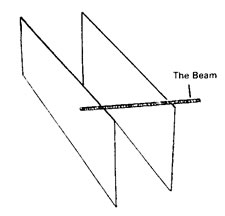
According to Torah law, one is permitted to carry [within an area enclosed] by three partitions.8 [The requirement to enclose the] fourth side is Rabbinic [in origin]. Therefore, it is sufficient to erect a pole or a beam.
ב
היאך מתירין מבוי הסתום. עושה לו ברוח רביעית לחי אחד או עושה עליו קורה ודיו. ותחשב אותה קורה או אותו לחי כאילו סתם רוח רביעית ויעשה רה"י ויהיה מותר לטלטל בכולו. שדין תורה בשלש מחיצות בלבד מותר לטלטל ומדברי סופרים היא הרוח הרביעית ולפיכך די לה בלחי או קורה:
3
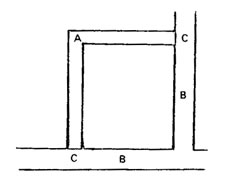 What must be done to allow people to carry within an open lane? A frame of an entrance must be erected at one side and either a pole or a beam must be erected at the other side.9
What must be done to allow people to carry within an open lane? A frame of an entrance must be erected at one side and either a pole or a beam must be erected at the other side.9An L-shaped10 lane is governed by the same rules as an open lane.11
ג
והיאך מתירין מבוי מפולש. עושה לו צורת פתח מכאן ולחי או קורה מכאן. ומבוי עקום תורתו כמפולש:
4
When a lane is level, but descends on an incline to the public domain, or if its entrance to the public domain is level but it itself descends on an incline,12 it does not require either a pole or a beam, for it is clearly distinct from the public domain.13
ד
מבוי שהוא שוה מתוכו ומדרון לרשות הרבים או שוה לרה"ר ומדרון לתוכו אינו צריך לא לחי ולא קורה שהרי הוא מובדל מרה"ר:
5
When one side of a lane ends at the sea and the other side ends at a public garbage dump, there is no need for [further measures to enable carrying to be permitted].14
[Leniency is granted,] because a public garbage dump is unlikely to be removed,15 and we do not suspect that the sea will wash up mud and rocks [which will dry out and create a surface level with that of the lane].16
ה
מבוי שצדו אחד כלה לים וצדו אחד כלה לאשפה של רבים אינו צריך כלום. שאשפה של רבים אינה עשויה להתפנות ואין חוששין שמא יעלה הים שרטון:
6
[The following rules apply to] an open lane that ends in the middle of a yard17 belonging to many different people: If [the end of the lane] is not opposite the entrance to the yard,18 it is considered to be closed and does not require any further measures at the side of the yard. If, however, it ends at the sides of the yard, it is forbidden [to carry within the lane].19
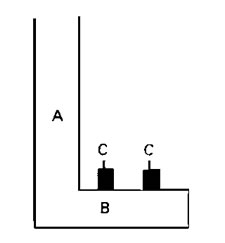 Moreover, if the yard belongs to a single individual, it is forbidden [to carry within the lane] even if the lane leads into the middle of the yard. [The rationale for this prohibition is that] at times, [the owner] may build on one of the sides of the yard. [After these improvements have been made,] it is possible that the lane will end at the side of the yard.
Moreover, if the yard belongs to a single individual, it is forbidden [to carry within the lane] even if the lane leads into the middle of the yard. [The rationale for this prohibition is that] at times, [the owner] may build on one of the sides of the yard. [After these improvements have been made,] it is possible that the lane will end at the side of the yard.ו
מבוי מפולש שהוא כלה לאמצע רחבה של רבים. אם לא היה מכוון כנגד פתח הרחבה הרי זה כסתום ואינו צריך מצד הרחבה כלום. אבל אם היה כלה לצדדי הרחבה אסור. ואם היתה של יחיד אף לאמצעה אסור. פעמים בונה מצד אחד ונמצא כלה לצדה של רחבה:
7
Permission [to carry within] a lane because a pole or a beam was erected is granted only when [the following conditions are met]:20
[several] houses and courtyards open into it;21
it is four cubits long or more;22 and
its length exceeds its width.
If, however, the length23 and the width24 of a lane are equal, it is considered to be a courtyard, and permission [to carry within is granted] only [when one erects] two poles - there is no minimum requirement with regard to their width - one at each of its sides, or one erects a barrier four handbreadths [wide]25 at one side.26
ז
אין המבוי ניתר בלחי או קורה עד שיהיו בתים וחצרות פתוחות לתוכו ויהיה ארכו מארבע אמות ולמעלה ויהיה ארכו יתר על רחבו. אבל מבוי שארכו כרחבו הרי הוא כחצר ואינו ניתר אלא בשני לחיים משני רוחותיו כל לחי במשהו. או בפס רחב ארבעה מרוח אחת:
8
When the length27 of a courtyard exceeds its width, it is considered to be a lane, and [carrying within it] is permitted [only when one erects] a pole or a beam.
[When several] houses and courtyards28 do not open into a lane - e.g., only one house or one courtyard does - and similarly, [when] a lane is not four cubits long, permission [to carry within is granted] only [when one erects] two poles29 or a barrier (more than)30 four handbreadths [wide].
ח
חצר שארכה יתר על רחבה הרי היא כמבוי וניתרת בלחי או קורה. ומבוי שאין בתים וחצירות פתוחות לתוכו כגון שלא היה בו אלא בית אחד או חצר אחת וכן מבוי שאין בארכו ארבע אמות אינו ניתר אלא בשני לחיים או בפס ארבעה ומשהו:
9
When a lane is not three handbreadths wide,31 one may carry throughout it; it does not require either a pole or a beam. [This leniency is granted because] an opening less than three handbreadths wide is considered to be an extension of the existing wall.32
When a beam is erected over a lane to make it possible for people to carry within as in a private domain, [the lane is not considered to be a private domain, and] a person who throws an article from it to the public domain or from the public domain into it is not liable. The beam is [there merely] to create a distinction.33
When, by contrast, a pole is erected [to make it possible for people to carry], [the lane is a private domain, and] a person who throws an article from it to the public domain or from the public domain into it, is liable. The pole is considered to be a wall on the fourth side.34
ט
מבוי שאין ברחבו שלשה טפחים אינו צריך לא לחי ולא קורה ומותר לטלטל בכולו. שכל פחות משלשה הרי הוא כלבוד. מבוי' שהכשירו בקורה אף על פי שמותר לטלטל בכולו כרה"י הזורק מתוכו לרה"ר או מרה"ר לתוכו פטור. שהקורה משום היכר היא עשויה. אבל אם הכשירו בלחי הזורק מתוכו לרשות הרבים או מרה"ר לתוכו חייב שהלחי הרי הוא כמחיצה ברוח רביעית:
10
How is it possible to [make it permissible for people to carry] between two walls of the public domain through which people [frequently] pass? One makes gates on both sides,35 causing the space between them to be considered to be a private domain.36
[In practice,] the gates need not be locked at night, but they must be fit to lock.37 If they are sunken in the earth, [the earth must be] cleared away and [the gates] adjusted so that they can be locked. The frame of an entrance,38 a pole, or a beam are not sufficient to make it possible for people to carry within a public domain.39
י
שני כותלים ברשות הרבים והעם עוברים ביניהם כיצד מכשיר ביניהם. עושה דלתות מכאן ודלתות מכאן ואחר כך יעשה ביניהם רה"י. ואינו צריך לנעול הדלתות בלילה אבל צריך שיהיו ראויות להנעל. היו משוקעות בעפר מפנה אותן ומתקנן להנעל. אבל צורת פתח או לחי וקורה אינן מועילין בהכשר רה"ר:
11
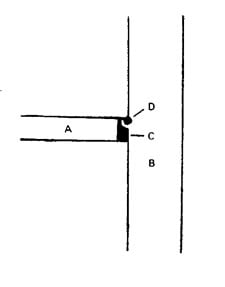 It is permissible to carry in [the portion of] the lane that is under the beam or opposite the pole.40 When does the above apply? When these structures are constructed near a public domain.
It is permissible to carry in [the portion of] the lane that is under the beam or opposite the pole.40 When does the above apply? When these structures are constructed near a public domain.When, by contrast, [a lane is] near a carmelit, it is forbidden to carry in [the portion of] the lane that is under the beam or opposite the pole,41 unless one erects another pole to permit carrying within the entrance.42
[The rationale for this stringency is that according to the Torah, a carmelit is a makom patur. Therefore, when] this entity, [the space opposite the pole or under the beam, which is also a makom patur, is adjacent] to an entity of this type, [the carmelit,] its presence is deemed significant [and it is considered to be an extension of the carmelit].43
יא
מותר לטלטל במבוי תחת הקורה או בין הלחיים. במה דברים אמורים בשהיה סמוך לרה"ר. אבל אם היה סמוך לכרמלית אסור לטלטל תחת הקורה או בין הלחיים עד שיעשה לחי אחר להתיר תוך הפתח שהרי מצא מין את מינו ונעור:
12
A pole may be constructed employing any substance, even a living entity,44 or even an object from which we are forbidden to benefit. [For example, if] a false deity or a tree that is worshiped45 is employed as a pole, it is acceptable.46 [The rationale for this ruling is that] there is no minimum requirement regarding the width of a pole.
The height of the pole may not be less than ten handbreadths.47 There is not, however, a minimum requirement for its width and breadth.
יב
בכל עושין לחיים אפילו בדבר שיש בו רוח חיים ואפילו באיסורי הנייה עכומ"ז עצמה או אשרה שעשה אותה לחי כשר שהלחי עוביו כל שהוא. גובה הלחי אין פחות מעשרה טפחים רחבו ועביו כל שהוא:
13
A beam may be constructed employing any substance, with the exception of a tree that has been worshiped.48 [The latter restriction is applied] because there is a minimum measure for the width of a beam, and a tree that has been worshiped is forbidden to be used whenever there is a minimum measure specified.
The width of a beam may be no less than a handbreadth;49 there is, however, no minimum measure for its thickness. Nevertheless, it must be sturdy enough50 to hold a brick51 that is one and a half handbreadths by three handbreadths.52 The supports53 for the beam must be sturdy enough to hold the beam and a brick of the size mentioned above.54
יג
בכל עושין קורה אבל לא באשרה לפי שיש לרוחב הקורה שיעור. וכל השיעורין אסורים מן האשרה. וכן רוחב הקורה אין פחות מטפח ועביה כל שהוא. והוא שתהיה בריאה לקבל אריח שהוא חצי לבינה של שלשה טפחים על שלשה טפחים. ומעמידי קורה צריכין שיהיו בריאין כדי לקבל קורה וחצי לבינה:
14
Of what size may the entrance of a lane be for a pole or a beam to be sufficient to allow [people to carry within]? Its height may not be less than ten handbreadths,55 nor more than twenty cubits.56 Its width may not be more than ten cubits.57
[The above applies] when [the opening] is not built with a frame of an entrance.58 If, however, [the opening] is built with the frame of an entrance, even if it is 100 cubits high, less than ten [handbreadths high],59 or more than 100 cubits wide, it is permissible [to carry within].60
יד
כמה יהיה פתח המבוי ויהיה די להכשירו בלחי או קורה. גבהו אין פחות מעשרה טפחים ולא יתר על עשרים אמה ורחבו עד עשר אמות. בד"א שלא היה לו צורת פתח. אבל אם היה לו צורת פתח אפילו היה גבוה מאה אמה או פחות מעשרה או רחב מאה אמה הרי זה מותר:
15
Similarly, if the beam over a lane is ornamented or it has designs61 so that everyone looks at it, it is acceptable even if it is more than 20 cubits high.62 A beam serves as a distinguishing factor. Therefore, [generally,] if it is higher than 20 cubits, [it is not acceptable because] it will not be noticed.63 If, however, it is ornamented or if it has designs - since it attracts attention, it serves as a distinguishing factor.
טו
וכן אם היה בקורה של מבוי כיור וציור עד שיהיו הכל מסתכלין בה אע"פ שהיא למעלה מכ' אמה כשרה. שהקורה משום היכר עשויה ואם היתה למעלה מכ' אינה ניכרת ואם יש בה ציור וכיור מסתכלים בה ונמצא שם היכר:
16
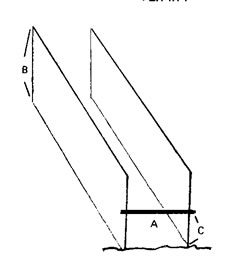 When the height of a lane, from the earth until the bottom of the beam is 20 cubits, it is acceptable even though the width of the beam extends higher than 20 [cubits above the ground.]
When the height of a lane, from the earth until the bottom of the beam is 20 cubits, it is acceptable even though the width of the beam extends higher than 20 [cubits above the ground.]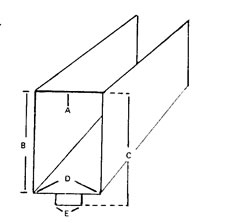 If the lane is more than 20 cubits high and one desires to reduce its height by placing a beam lower than it,64 the beam must be a handbreadth wide. If the lane is less than ten handbreadths high, one should dig out a portion that is four cubits by four cubits65 in area, deep enough so that [the walls of the lane will be] a full ten handbreadths [in height].
If the lane is more than 20 cubits high and one desires to reduce its height by placing a beam lower than it,64 the beam must be a handbreadth wide. If the lane is less than ten handbreadths high, one should dig out a portion that is four cubits by four cubits65 in area, deep enough so that [the walls of the lane will be] a full ten handbreadths [in height].טז
מבוי שהיה גובהו מן הארץ עד קרקעית קורה עשרים אמה ועובי הקורה למעלה מעשרים כשר. היה גובהו יתר מעשרים ובא למעטו בקורה שמניח אותה למטה צריך להיות ברוחבה טפח כקורה. היה גובהו פחות מעשרה חוקק בו משך ארבע על ארבע אמות ומעמיק כדי להשלימו לעשרה:
17
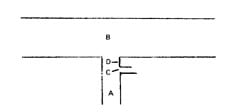 [The following rules apply when] an opening is made in the side of a lane,66 near its front:67 If a portion of the wall four handbreadths wide touching the front [wall] remains standing, it is permissible [to carry within the lane],68 provided the opening is not more than ten cubits wide.69
[The following rules apply when] an opening is made in the side of a lane,66 near its front:67 If a portion of the wall four handbreadths wide touching the front [wall] remains standing, it is permissible [to carry within the lane],68 provided the opening is not more than ten cubits wide.69If, however, a portion of the wall four handbreadths wide does not remain, it is forbidden [to carry within the lane]70 unless the opening is less than three handbreadths. [Any opening] less than three handbreadths [is considered to be closed,] based on the principle of l'vud.
יז
נפרץ בו פרצה מצדו כלפי ראשו אם נשאר עומד בראשו פס רוחב ארבעה טפחים מותר והוא שלא תהיה הפרצה יתר על עשר. ואם לא נשאר פס ארבעה אסור אלא א"כ היתה הפרצה פחות משלשה שכל פחות משלשה כלבוד:
18
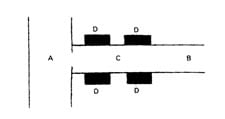 [The following rules apply when] a lane opens up entirely71 to a courtyard and the courtyard opens up on the opposite side72 to the public domain: it is forbidden [to carry within], because it is like an open lane. It is [however] permissible to carry within the courtyard, for although many people pass through a courtyard - entering from this side and departing from the other - it is still considered a private domain.73
[The following rules apply when] a lane opens up entirely71 to a courtyard and the courtyard opens up on the opposite side72 to the public domain: it is forbidden [to carry within], because it is like an open lane. It is [however] permissible to carry within the courtyard, for although many people pass through a courtyard - entering from this side and departing from the other - it is still considered a private domain.73יח
נפרץ המבוי במלואו לחצר ונפרצה חצר כנגדו לרה"ר הרי זה אסור מפני שהוא מבוי מפולש. והחצר מותרת שהחצר שרבים בוקעין בה ונכנסין בזו ויוצאין בזו הרי היא רה"י גמורה:
19
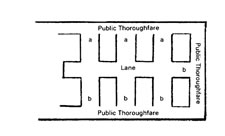 [The following rules apply when] there are several paths leading [from the public domain] to a lane, [merging with it] at different points.74 Although the entrances are not opposite one another, since
[The following rules apply when] there are several paths leading [from the public domain] to a lane, [merging with it] at different points.74 Although the entrances are not opposite one another, since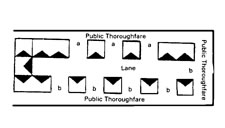 they all lead to the public domain, every one is considered to be an open lane.75
they all lead to the public domain, every one is considered to be an open lane.75 What must be done [to make it possible to carry within this lane]? A frame of an entrance should be constructed for each of the paths at one end.76 Similarly, [a frame of an entrance should be constructed] at the main entrance [of the lane to the public domain]. At the other side of all the paths, one should construct a pole or a beam.
What must be done [to make it possible to carry within this lane]? A frame of an entrance should be constructed for each of the paths at one end.76 Similarly, [a frame of an entrance should be constructed] at the main entrance [of the lane to the public domain]. At the other side of all the paths, one should construct a pole or a beam.יט
מבוי שהיו לו שבילים מצד זה ושבילים מצד אחר שנמצאו מפולשין לרה"ר אע"פ שאינן מכוונין זה כנגד זה הרי כל אחד מהן מבוי מפולש. כיצד מכשירין אותו עושה צורת פתח לכל אחד ואחד מן השבילים שבצד האחד. וכן לפתח הגדול ועושה לכל השבילים שבצד השני לחי או קורה:
20
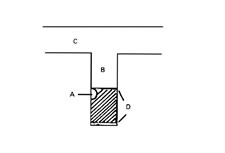 When one of the walls of a lane [that leads to the public domain] is long and the other is short,77 one should place the beam near the shorter wall.78
When one of the walls of a lane [that leads to the public domain] is long and the other is short,77 one should place the beam near the shorter wall.78When a pole79 is constructed in the midst of a lane, it is permissible to carry within the inner portion of the lane80 that is behind the pole.81 It is, however, forbidden [to carry] in the outer portion of the lane that is beyond the pole.
כ
מבוי שצדו אחד ארוך וצדו השני קצר מניח את הקורה כנגד הקצר. העמיד לחי בחצי המבוי הפנימי שהוא לפנים מן הלחי מותר לטלטל בו והחצי החיצון שהוא חוץ מן הלחי אסור:
21
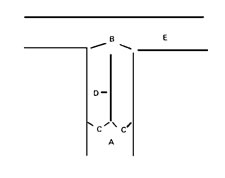 When a lane is twenty cubits wide, [it is possible to enable people to carry within by erecting a pole or a board in the following manner]:82 One may build a wall ten handbreadths high and four cubits long - the latter being the minimum length of a lane - and place [the wall perpendicularly] in the middle [of the entrance].
When a lane is twenty cubits wide, [it is possible to enable people to carry within by erecting a pole or a board in the following manner]:82 One may build a wall ten handbreadths high and four cubits long - the latter being the minimum length of a lane - and place [the wall perpendicularly] in the middle [of the entrance].[As such,] it is as if there are two lanes, each with an entrance of ten cubits.83
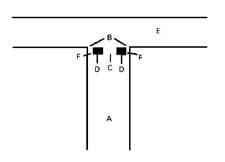 Alternatively, one may leave a space of two cubits from [one side of the lane] and set up a wall three cubits long, and [similarly,] leave a space of two cubits [from the other side of the lane] and set up a wall three cubits long. Thus, the opening of the lane will be ten cubits wide,84 and the sides will be considered to be closed, because the enclosed portions exceed the open portions.85
Alternatively, one may leave a space of two cubits from [one side of the lane] and set up a wall three cubits long, and [similarly,] leave a space of two cubits [from the other side of the lane] and set up a wall three cubits long. Thus, the opening of the lane will be ten cubits wide,84 and the sides will be considered to be closed, because the enclosed portions exceed the open portions.85כא
מבוי שהוא רחב עשרים אמה עושה פס גבוה עשרה טפחים במשך ארבע אמות שהוא שיעור משך המבוי ומעמידו באמצע ונמצא בשני מבואות שיש בפתח כל אחד מהן עשר אמות. או מרחיק שתי אמות מכאן ומעמיד פס שלש אמות ומרחיק שתי אמות מכאן ומעמיד פס שלש אמות מכאן ונמצא פתח המבוי עשר אמות והצדדין הרי הן כסתומין שהרי עומד מרובה על הפרוץ:
22
 A pole that projects outward from the wall of the lane is acceptable.86 [Similarly,] a pole that is standing [at the side of the entrance to a lane] without having been placed there [intentionally]87 is acceptable, provided one has the intent of relying on it before [the commencement of] the Sabbath.88
A pole that projects outward from the wall of the lane is acceptable.86 [Similarly,] a pole that is standing [at the side of the entrance to a lane] without having been placed there [intentionally]87 is acceptable, provided one has the intent of relying on it before [the commencement of] the Sabbath.88 When a pole can be seen from the inside of a lane but cannot be seen from the outside,89 or conversely, when it can be seen from the outside, but from within the lane appears flush with the wall, it is acceptable as a pole.90
When a pole can be seen from the inside of a lane but cannot be seen from the outside,89 or conversely, when it can be seen from the outside, but from within the lane appears flush with the wall, it is acceptable as a pole.90A pole that is lifted three handbreadths above the ground91 or that is more than three handbreadths away from the wall,92 is not at all significant. Anything less than three handbreadths is, however, acceptable, based on the principle of l'vud.
When a pole is very wide - whether its width is less than or equal to half the width of the lane, it is acceptable and is considered to be a pole. If, however, [its width] exceeds half the width of the lane, [it is considered to be a wall and this side is considered to be enclosed], because the enclosed portion exceeds the open portion.93
כב
לחי הבולט מדפנו של מבוי כשר. ולחי העומד מאליו אם סמכו עליו מקודם השבת כשר. ולחי שהוא נראה מבפנים לחי ומבחוץ אינו נראה לחי. או שהיה נראה מבחוץ לחי ומבפנים נראה שהוא שוה וכאילו אין שם לחי. הרי זה נידון משום לחי. לחי שהגביהו מן הקרקע שלשה טפחים או שהפליגו מן הכותל שלשה לא עשה כלום. אבל פחות מג' טפחים כשר שכל פחות משלשה כלבוד. לחי שהיה רחב הרבה. בין שהיה רחבו פחות מחצי רוחב המבוי בין שהיה רחבו כחצי רוחב המבוי כשר ונידון משום לחי. אבל אם היה יתר על חצי רוחב המבוי נידון משום עומד מרובה על הפרוץ:
23
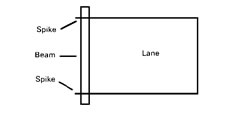 When a mat is spread over a beam, the beam's [function in making it possible to carry within the lane] is nullified, for it is no longer conspicuous.94 [It is possible, however, for it still to be possible to carry within the lane, provided the mat reaches within three handbreadths of the ground.95] If the mat is three handbreadths or more from the ground, it is not considered to be a wall [and carrying is forbidden within the lane].
When a mat is spread over a beam, the beam's [function in making it possible to carry within the lane] is nullified, for it is no longer conspicuous.94 [It is possible, however, for it still to be possible to carry within the lane, provided the mat reaches within three handbreadths of the ground.95] If the mat is three handbreadths or more from the ground, it is not considered to be a wall [and carrying is forbidden within the lane].If one implants two spikes into the front of the wall96 of a lane and places a beam upon them, one's actions are of no significance [and it is forbidden to carry within the lane]. For a beam [to be significant, it] must be positioned over a lane and not next to it.97
כג
קורה שפירס עליה מחצלת הרי ביטלה שהרי אינה ניכרת. לפיכך אם היתה המחצלת מסולקת מן הארץ שלשה טפחים או יתר אינה מחיצה. נעץ שתי יתדות בשני כותלי מבוי מבחוץ והניח עליהן הקורה לא עשה כלום. שצריך להיות הקורה על גבי המבוי לא סמוך לו:
24
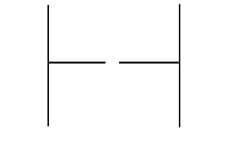 [The following rules apply when] a beam extends outward from one wall of a lane,98 but does not reach the second wall, or if one beam extends outward from one wall and another beam extends outward from the second wall: If they reach within three [handbreadths] of each other, there is no need to bring another beam.99 If there is more than three handbreadths between them, one must bring another beam.
[The following rules apply when] a beam extends outward from one wall of a lane,98 but does not reach the second wall, or if one beam extends outward from one wall and another beam extends outward from the second wall: If they reach within three [handbreadths] of each other, there is no need to bring another beam.99 If there is more than three handbreadths between them, one must bring another beam.כד
קורה היוצאה מכותל זה ואינה נוגעת בכותל השני וכן שתי קורות אחת יוצאה מכותל זה ואחת יוצאה מכותל זה ואינן מגיעות זו לזו פחות משלשה אינו צריך להביא קורה אחרת. היה ביניהן שלשה צריך להביא קורה אחרת:
25
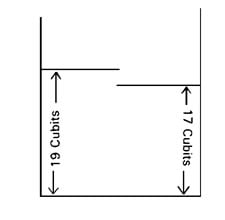 Similarly, when two beams are positioned parallel to each other and neither of them is able to support a brick [of the required size],100 there is no need to bring another beam if the two beams can support the brick together.101
Similarly, when two beams are positioned parallel to each other and neither of them is able to support a brick [of the required size],100 there is no need to bring another beam if the two beams can support the brick together.101If one is on a higher plane and the other is on a lower plane, we see the upper one as if it were lower and the lower one as if it were raised [and thus the two are regarded as though they were on the same plane].102 [This applies] provided the upper board is not higher than 20 cubits high,103 the lower board is not less than ten handbreadths high104 and there would be less than three handbreadths between the two if the upper one were lowered and the lower one were raised until they were parallel to each other on the same plane.105
כה
וכן שתי קורות המתאימות לא בזו כדי לקבל אריח ולא בזו כדי לקבל אריח אם יש בשתיהן כדי לקבל אריח אינו צריך להביא קורה אחרת. היתה אחת למטה ואחת למעלה רואין את העליונה כאילו היא למטה והתחתונה כאילו היא למעלה. ובלבד שלא תהיה עליונה למעלה מעשרים ולא תחתונה למטה מעשרה. ולא יהיה ביניהן שלשה טפחים. כשרואין אותה שירדה זו ועלתה זו בכונה עד שיעשו זו בצד זו:
26
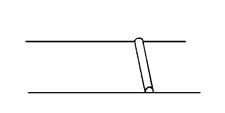 If the beam is crooked, we consider it as if it were straight. If it is rounded,106 we consider it as if it were linear. Thus, if its circumference is three handbreadths, it is a handbreadth in diameter.107
If the beam is crooked, we consider it as if it were straight. If it is rounded,106 we consider it as if it were linear. Thus, if its circumference is three handbreadths, it is a handbreadth in diameter.107[The following rules apply when] a beam is located in the midst of a lane, but because it is crooked, a portion projects outside the lane, or because it is crooked, a portion projects above twenty [cubits] or below ten [handbreadths] high: We consider the distance that would remain between the two ends of the beam were the crooked portion [which projects outside the desired area] to be removed:108 If less than three handbreadths remain, there is no need to bring another beam. If [more remain], another beam is required.
כו
היתה הקורה עקומה רואין אותה כאילו היא פשוטה. עגולה רואין אותה כאילו היא מרובעת. ואם היה בהיקפה שלשה טפחים יש בה רוחב טפח. היתה הקורה בתוך המבוי ועקומה חוץ למבוי. או שהיתה עקומה למעלה מעשרים או למטה מעשרה. רואין כל שאילו ינטל העיקום וישארו שני ראשיה אין בין זה לזה שלשה אינו צריך להביא קורה אחרת. ואם לאו צריך להביא קורה אחרת:
27
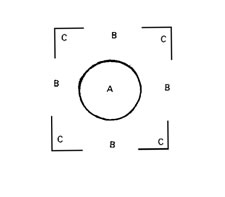 When eight walls are positioned at the corners [of a square around] a well,109 two attached [perpendicularly] at each corner, they are considered to be an enclosure. Even though [the length of the] open portion exceeds that of the walls on each of the sides, since [there are walls] standing at all of the corners, it is permitted to draw water from the well and permit an animal to drink.110
When eight walls are positioned at the corners [of a square around] a well,109 two attached [perpendicularly] at each corner, they are considered to be an enclosure. Even though [the length of the] open portion exceeds that of the walls on each of the sides, since [there are walls] standing at all of the corners, it is permitted to draw water from the well and permit an animal to drink.110How high must each of these walls be? Ten handbreadths. The walls must each be six handbreadths wide,111 and there must be space between each wall for two teams - each consisting of four cattle - one entering and one departing. This measure is not more than thirteen and one third cubits.112
כז
באר שעשה לה שמונה פסין מארבע זויות שני פסין דבוקין בכל זוית הרי אלו כמחיצה. ואע"פ שהפרוץ מרובה על העומד בכל רוח ורוח. הואיל וארבע הזויות עומדות הרי זה מותר למלאות מן הבאר ולהשקות לבהמה. וכמה יהיה גובה כל פס מהן עשרה טפחים ורחבו ששה טפחים ובין כל פס לפס כמלוא שתי רבקות של ארבעה ארבעה בקר אחת נכנסת ואחת יוצאה. שיעור רוחב זה אין יתר על שלש עשרה אמה ושליש:
28
[It is not always necessary for this space to have actual walls positioned at its corners]. If at one of the corners, or at all four of the corners, there is positioned a large stone, a tree, a mound whose incline is more than ten handbreadths within four cubits, or a bundle of reeds, [the following rules apply]: We see whether the article in question has a section one cubit long on either side that is ten handbreadths high when divided [at the corner].113 [If this is true,] it is considered to be two walls positioned at a corner.
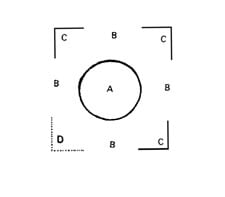 When five reeds are erected [around the corner of such a square] with less than three [handbreadths] between each pair of them,114 [the space between them is considered to be closed].115 If there are six handbreadths on one side and six handbreadths on the other side, they are considered to be two walls positioned at a corner.
When five reeds are erected [around the corner of such a square] with less than three [handbreadths] between each pair of them,114 [the space between them is considered to be closed].115 If there are six handbreadths on one side and six handbreadths on the other side, they are considered to be two walls positioned at a corner.כח
היה במקום אחד מן הזויות או בכל זוית מארבעתן אבן גדולה או אילן או תל המתלקט עשרה מתוך ארבע אמות או חבילה של קנים. רואין כל שאילו יחלק ויש בו אמה לכאן ואמה לכאן בגובה עשרה נדון משום זוית שיש בה שני פסין. חמשה קנים ואין בין זה לזה שלשה ויש ביניהן ששה טפחים לכאן וששה טפחים לכאן נדונים משום זוית שיש בה שני פסין:
29
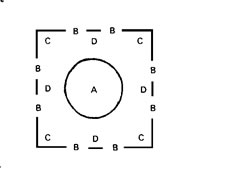 It is permissible to bring these four corners closer to the well, provided there is still enough space for the majority of a cow's body to be within these walls when it is drinking.116 Although one does not hold the head of the animal together with the vessel from which it is drinking, since there is space for the head [of a cow] and the majority [of its body] within [the square], it is permitted.
It is permissible to bring these four corners closer to the well, provided there is still enough space for the majority of a cow's body to be within these walls when it is drinking.116 Although one does not hold the head of the animal together with the vessel from which it is drinking, since there is space for the head [of a cow] and the majority [of its body] within [the square], it is permitted.[If the square is this size,] it is permissible even for a camel117 [to use] it. If [the square] is smaller, it is forbidden to draw water within [the square], even for a kid whose entire body can enter within.
It is permissible to separate [the walls] from the well as far as one desires, provided that one adds straight walls on every side,118 so that there will never be more than thirteen and one third cubits between each of the two walls.
כט
מותר להקריב ארבע הזויות האלו לבאר. והוא שתהיה פרה ראשה ורובה לפנים מן הפסין ושותה. אע"פ שלא יאחז ראש הבהמה עם הכלי שבו המים הואיל וראשה ורובה בפנים מותר אפילו לגמל. היו קרובים יתר מזה אסור להשקות מהן אפילו לגדי שהוא כולו נכנס לפנים. ומותר להרחיק כל שהוא ובלבד שירבה בפסים פשוטים שמניחין אותן בכל רוח ורוח כדי שלא יהא בין פס לחבירו יותר על שלש עשרה אמה ושליש:
30
[The use of] such walls was permitted only in Eretz Yisrael, and for the sake of the herds119 of the festive pilgrims. Similarly, [this leniency] was granted only with regard to a fresh-water well120 that belongs to the public.121.
In contrast, should a person desire to drink, he should descend to the well and drink, or should make a barrier ten handbreadths high around the wall,122 stand within it, draw water, and drink. If the well is very wide and a man is unable to climb down it, he may draw water and drink within [a structure of] corner walls [as described above].
ל
לא התירו הפסים האלו אלא בארץ ישראל ולבהמת עולי רגלים בלבד והוא שיהיה באר מים חיים של רבים. אבל בשאר ארצות אדם ירד לבאר וישתה או יעשה לו מחיצה מקפת לבאר גבוהה עשרה טפחים ויעמוד בתוכה וידלה וישתה. ואם היה הבאר רחב הרבה שאין אדם יכול לירד בו הרי זה ידלה וישתה בין הפסין:
31
Similarly, it is forbidden to draw water from a cistern that belongs to the public or from a well that belongs to a private individual - even in Eretz Yisrael - unless one constructs a barrier123 ten handbreadths high around them.
לא
וכן בור הרבים ובאר היחיד אפילו בארץ ישראל אין ממלאין מהן אלא אם כן עשו להן מחיצה גבוהה עשרה טפחים:
32
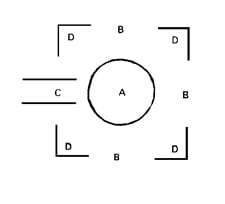 When a person was drawing [water] for his animal that is standing between the walls [of the abovementioned enclosure], he may draw water and place it before [the animal] in the vessel [with which it was drawn].
When a person was drawing [water] for his animal that is standing between the walls [of the abovementioned enclosure], he may draw water and place it before [the animal] in the vessel [with which it was drawn].If the [animal was in] a stall ten handbreadths high and four handbreadths [by four handbreadths] wide, whose front portion projected within such walls, the person should not draw water and place [the vessel] before [the animal].124 [This restriction was instituted] lest the stall be broken and the person carry the bucket into the stall, and from the stall [bring it] to the ground of the public domain.125 Instead, he should draw water, pour it before [his animal], who will drink it itself.
לב
הממלא לבהמתו בין הפסים ממלא ונותן בכלי לפניה. ואם היה אבוס ראשו נכנס לבין הפסים והיה גבוה עשרה ורחב ארבעה לא ימלא ויתן לפניה שמא יתקלקל האבוס ויוציא הדלי לאבוס ומן האבוס לקרקע רה"ר אלא ממלא ושופך והיא שותה מאליה:
33
When a person throws [an article] from the public domain into [a space surrounded by] walls of this nature, he is liable. Since there is an actual wall that is ten [handbreadths] high and more than four [handbreadths] by four [handbreadths] in area in every corner, the square is a definitive and distinct entity.126 Hence, the entire [enclosure] is considered to be a private domain.127
[The above applies] even [were such a structure to be built] in a valley where there is no well, for there is a wall on each side of each corner [of the enclosure]. Even if many people pass through the enclosure, the walls are not considered to have been nullified.128[Instead, the enclosure] is considered to be like a courtyard through which many people pass. [All agree that] a person who throws [an object] into [such a courtyard] is liable.129If there is a well located within such an enclosure, [our Sages relaxed some of their restrictions and] permitted drawing water for an animal.
לג
הזורק מרה"ר לבין הפסין חייב הואיל ויש בכל זוית וזוית מחיצה גמורה שיש בה גובה עשרה ויותר מארבעה על ארבעה והרי הרבוע ניכר ונראה ונעשה כל שביניהם רה"י. ואפילו היה בבקעה ואין שם ביניהם באר שהרי בכל רוח ורוח פס מכאן ופס מכאן. ואפילו היו רבים בוקעין ועוברין בין הפסין לא בטלו המחיצות והרי הן כחצרות שהרבים בוקעין בהן והזורק לתוכן חייב. ומותר להשקות הבהמה ביניהן אם היה ביניהן באר.
34
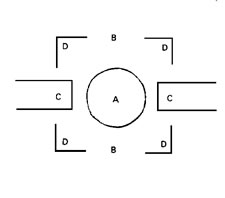 When one end of a courtyard enters between the walls of the abovementioned enclosure, it is permitted to carry from [the courtyard] into the enclosure and from the enclosure into [the courtyard].130 When [portions of] two courtyards enter between the walls of the abovementioned enclosure, it is forbidden to carry [from the enclosure to the courtyards and from the courtyard to the enclosure] unless an eruv is made.131
When one end of a courtyard enters between the walls of the abovementioned enclosure, it is permitted to carry from [the courtyard] into the enclosure and from the enclosure into [the courtyard].130 When [portions of] two courtyards enter between the walls of the abovementioned enclosure, it is forbidden to carry [from the enclosure to the courtyards and from the courtyard to the enclosure] unless an eruv is made.131If the well dries up on the Sabbath, it is forbidden to carry between the walls [of the enclosure].132 [Our Sages133] considered these walls to be an acceptable enclosure to allow [people] to carry within, only because of the water. If the well begins to flow with water on the Sabbath,134 it is permitted to carry within [the enclosure], for an enclosure that is established on the Sabbath is an [acceptable] enclosure.135
When the beam or pole [used to permit people to carry within] a lane is removed on the Sabbath, it is forbidden to carry within,136 even if it opens up to a carmelit.137
לד
חצר שראשה אחד נכנס לבין הפסין מותר לטלטל מתוכה לבין הפסין ומבין הפסין לתוכה. היו שתי חצירות אסורין עד שיערבו. יבשו המים בשבת אסור לטלטל בין הפסין שלא נחשבו מחיצה לטלטל בתוכן אלא משום המים. באו לו מים בשבת מותר לטלטל ביניהן. שכל מחיצה שנעשית בשבת שמה מחיצה. מבוי שניטלה קורתו או לחיו בשבת אסור לטלטל בו אע"פ שנפרץ לכרמלית:
35
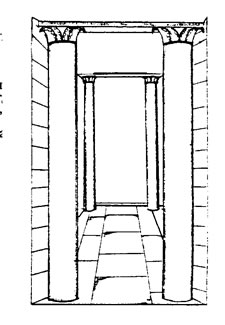 When an excedra138 is constructed in an open area, it is permitted to carry within its entire space although it has only three walls and a roof.139 We consider it to be as though the edge of the roof descends and closes off the fourth side.140 A person who throws an article into it from the public domain is not liable.141 It is as if one throws an article into a closed lane that possesses a roof.
When an excedra138 is constructed in an open area, it is permitted to carry within its entire space although it has only three walls and a roof.139 We consider it to be as though the edge of the roof descends and closes off the fourth side.140 A person who throws an article into it from the public domain is not liable.141 It is as if one throws an article into a closed lane that possesses a roof.When the corner of a house or a courtyard is broken and an opening of ten cubits is created, it is forbidden to carry within it at all. Although [generally] whenever an opening is ten cubits or less we consider it to be an entrance,142 [no leniency is granted in this instance, because] an entrance is not made in a corner.143
Should there be a board extending across the length of the opening, it is considered as if it descends and closes the opening.144 Thus, it is permitted to carry within the entire area. [This leniency applies] provided [the beams] are not [constructed at] an angle.145
לה
אכסדרה בבקעה מותר לטלטל בכולה ואע"פ שהיא בת שלש מחיצות ותקרה. שאנו רואין כאילו פי תקרה יורד וסותם רוח רביעית. והזורק מרה"ר לתוכה פטור כזורק למבוי סתום שיש לו קורה. בית או חצר שנפרץ קרן זוית שלה בעשר אמות הרי זה אסור לטלטל בכולו אע"פ שכל פרצה שהיא עד עשר אמות כפתח. אין עושין פתח בקרן זוית. ואם היתה שם קורה מלמעלה על אורך הפרצה רואין אותה שירדה וסתמה ומותר לטלטל בכולו והוא שלא תהיה באלכסון:
36
The term "fingerbreadth" when used as a measurement, universally refers to the width of a thumb.146 A handbreadth is the size of four fingerbreadths.147 Whenever the term "cubit" is used whether with regard to the laws of the Sabbath, a sukkah, or the prohibition of growing mixed species, it refers to a cubit of six handbreadths.148
There are times when we measure a cubit as six handbreadths pressed one to the other, and other occasions when we consider the handbreadths as amply spaced one from the other.149 In both instances, the intent is that this lead to a more stringent ruling.
For example, the length of a lane [is required to be a minimum of] four cubits. These are measured in amply spaced cubits. The height [of a lane may not exceed] twenty cubits. These are measured in constricted cubits. Similarly, the length of an opening [may not exceed] ten cubits. These are measured in constricted cubits. Similar principles apply regarding the laws of a sukkah and the prohibition of growing mixed species.
לו
האצבע שמשערין בה בכל מקום היא רוחב הגודל של יד. והטפח ארבע אצבעות. וכל אמה האמורה בכל מקום בין בשבת בין בסוכה וכלאים היא אמה בת ששה טפחים. ופעמים משערין באמה בת ששה טפחים דחוקות זו לזו. ופעמים משערין באמה בת ששה שוחקות ורווחות וזה וזה להחמיר. כיצד משך מבוי בארבע אמות שוחקות וגובהו עשרים אמה עציבות. רוחב הפרצה עשר אמות עציבות וכיוצא בהן לענין סוכה וכלאים
FOOTNOTES
1.In Talmudic times, it was not customary that homes open to streets, as is the practice today. Instead, several homes would open up to a single courtyard. These courtyards would open up to paths or lanes that led to the public marketplaces and the thoroughfares of the towns. Sometimes, these paths or lanes would end in a cul-de- sac, and on other occasions they would lead from one thoroughfare to another.
2.This refers to a lane leading from one marketplace or thoroughfare to another. Needless to say, the lane must be less than sixteen cubits wide. If it is sixteen cubits wide, it would be deemed as a public domain according to the Rambam, as mentioned in Chapter 14, Halachah 1.
3.This question applies within a city that is not surrounded by an eruv. As the Rambam explains in his Commentary on the Mishnah (Eruvin 1:2), a lane with three walls is considered to be a carmelit. Thus according to the Torah itself, such an area is regarded as a makom patur, and one is permitted to carry within it. The Rabbis nevertheless forbade carrying within such an area, unless a person constructed either of the following structures: a lechi - a pole constructed at one of the corners of the fourth side - or a korah - a beam constructed across the entrance. (See also the gloss of the Maggid Mishneh.)
4.The dimensions required for a pole and a beam are mentioned in Halachot 12 and 13. When a pole is constructed at the corner of the fourth side of the lane, the lane is considered to be enclosed and thus is viewed as a private domain. (See Halachah 9 of this chapter and Chapter 14, Halachah 1.)
5.As explained in Halachah 9, extending a beam over the lane is a Rabbinic measure that makes a distinction between such a lane and a lane that is not enclosed at all. Because of this distinction, the Rabbinic prohibition against carrying in such a lane is lifted.
6.This refers merely to the process of enclosing the area in question. In addition, as mentioned in Hilchot Eruvin 1:1-2, it is necessary for the people who share the lane to join together in an eruv, each contributing a certain measure of food.
7.The Rambam's definition of a lane follows the conception of Rabbenu Chanan'el in his commentary on Eruvin 12a. Most other Rishonim [including Rashi (Eruvin, loc. cit.), Tosafot, the Rashba, and the Ra'avad] differ, and maintain that as long as a lane has three walls (or two walls and a pole on the third side), it is considered a private domain according to the Torah. (See Be'ur Halachah 363:1.)
The difference between the Rambam's view and that of these other authorities does not concern the license to carry, for all agree that it is forbidden to carry within the lane until a pole or a beam is constructed at the fourth side. Instead, the difference involves transferring an article into such a lane with three walls from the public domain. According to the Rambam, one is not liable from such a transfer, while according to the other authorities, one is.
8.As mentioned above, according to the Rambam, one may carry in this lane, because any enclosure with three walls or less is deemed as a carmelit. According to the Torah, there is no restriction against carrying in such a domain.
9.This ruling follows that of Rabbenu Yitzchak Alfasi in his Halachot. Nevertheless, there are many authorities who differ and maintain that this ruling applies only when the lane opens to a carmelit on at least one side. If it opens up to a public domain on both sides, it is not sufficient to erect a frame of an entrance, and a proper gate must be erected (Maggid Mishneh). The Rambam's ruling is accepted by the Shulchan Aruch (Orach Chayim 364:1).
10.Our translation is based on the gloss and drawings of the Maggid Mishneh.
11.The Rambam rules that all that is necessary is a frame of an entrance at one opening of the lane, and a pole or a beam at the other end. Nothing is necessary at the bend of the lane. This follows the opinion of Rav (Eruvin 6a, 8b).
Rashi and Rabbenu Asher, however, interpret Rav's ruling differently and require that a frame of an entrance be constructed at the lane's bend, and a pole or a beam be constructed at both the lane's openings. They explain that this is necessary because, unless the frame of an entrance is constructed at the bend, a person who does not walk through the entire lane will not be aware of the pole or the beam at the other entrance to the lane. This is the view accepted by the Shulchan Aruch (loc. cit.:3).
12.Based on Shabbat 100a and the Tosefta, Shabbat 11:4, the Ra'avad and the Rashba define this as referring to an incline of ten handbreadths within four cubits. If the incline is gentler than that, this leniency does not apply. The Shulchan Aruch (Orach Chayim 363:36) accepts this definition.
13.According to the Torah, one is allowed to carry within the lane, and the prohibition is merely Rabbinic in origin. Thus, since the steep incline makes the lane distinct from the public domain (and distinct from other lanes), there is no need for any further measures to permit carrying.
From the wording chosen by the Rambam, however, it appears that he does not consider the incline as a wall enclosing the lane (see the Ramah, Orach Chayim, loc. cit.), but rather as a distinguishing factor similar to a beam. Accordingly, a person who transfers an article into this lane from the public domain would not be held liable.
14.This refers to a lane that has walls on either side. Thus, it is considered as if the lane had barriers on all four sides. For the garbage dump can be assumed to be ten handbreadths high and four handbreadths wide. Thus, it is considered to be an added wall, and the sea itself can be assumed to be ten handbreadths deep. Therefore, it is also considered to be a wall (Mishnah Berurah 363:118).
15.This law does not apply regarding a private garbage dump, because the possibility exists that such a dump will be removed at any time.
16.Our translation follows the commentary of Rabbenu Chanan'el and Rashi on Eruvin 8a. Although both these authorities agree on the definition of the word שרטון, they quote different versions of that Talmudic passage. Rabbenu Chanan'el follows the version quoted here by the Rambam, which states that "we do not suspect that the sea will wash up a שרטון." The version of the passage quoted by Rashi (and printed in our texts of the Talmud today) states, "we suspect that the sea will wash up a שרטון."
Significantly, this difference in approach to this passage has been preserved. The Shulchan Aruch (Orach Chayim 363:29) follows the ruling of the Rambam, while subsequent Ashkenazic authorities and the Ramah follow that of Rashi which forbids carrying in such a lane. According to this view, it is impossible to enclose it with an eruv.
17.See the definition of the term רחבה in Chapter 16, Halachah 10.
18.Were the lane to end directly opposite the entrance from the yard to the public domain, a more stringent ruling would be applied and it would be necessary to construct a frame of an entrance. See Halachot 3 and 18.
19.The Maggid Mishneh explains that were the lane to end at the side of the yard, it would resemble an L-shaped lane. Hence, the laws mentioned in Halachah 3 would apply. When, however, the lane does not end at the side of the yard, it has no resemblance to an L-shaped lane. Therefore, the entrance to the yard is itself considered a distinguishing factor. (Note, however, Rabbenu Asher and the Shulchan Aruch, Orach Chayim 365:3, which require that the people whose homes open up to the lane and the yard join together in an eruv.)
Significantly, according to the Maggid Mishneh, the word "forbidden" used by the Rambam, appears to mean "requires an eruv." This would concur with the Ra'avad's interpretation of Eruvin 7b which states that if the people whose homes open to the yard join in an eruv together with the people whose homes open to the lane, it is permitted to carry in the lane even if it ends in the side of the yard.
Note, however, the Shulchan Aruch (loc. cit.) which mentions that an eruv can never be effective for such a lane. See the explanation of this ruling in the Mishnah Berurah 365:23.
20.The fundamental principle behind these conditions is that an enclosure that is used by a private person will afford greater privacy than an enclosure used by many people. Therefore, it is necessary that the enclosure be more substantial (the Rashba as quoted by the Kessef Mishneh).
21.When only a single house or courtyard opens to a lane, it bears a far closer resemblance to private property.
22.If a lane is not more than four cubits or if it is square shaped, it appears like a courtyard.
23.I.e., the distance from one entrance to the other.
24.The distance between the two walls on either side.
25.A barrier of this length is considered to be a wall, and thus a portion of this side of the lane is also considered to be enclosed.
26.Although the requirement to construct two poles or a barrier is more stringent than the norm for a lane, it still represents a leniency. There is no need to construct the frame of an entrance as in a courtyard.
The Rambam's ruling (with several additions) is quoted by the Shulchan Aruch (Orach Chayim 363:26). In his gloss, the Ramah adds that it has become customary to enclose all lanes with the frame of an entrance - i.e., two poles, and a cord above them.
27.The length of a courtyard refers to the space from its entrance to the opposite wall (Maggid Mishneh). Although there are other interpretations, this is the definition accepted as halachah (Mishnah Berurah 363:116).
28.Our translation is based on the second interpretation of the Rambam's words offered by the Maggid Mishneh, which is supported by the Rambam's statements in Hilchot Eruvin 5:15. From that source, it appears that the Rambam conceives of a lane as having several courtyards and several houses open up to it. If, however, there is only one house opening up to it, although it contains several courtyards, or one courtyard although it contains several houses, it is not sufficient.
Rashi (Eruvin 12b), however, offers a different interpretation, explaining that to be considered a lane, an enclosure must have two courtyards open up to it, and each of the courtyards must have two houses open up to it. This view is accepted by the Rashba and by the Shulchan Aruch (Orach Chayim 363:26).
29.Note the Shulchan Aruch (loc. cit.), which states that when a lane is less than four cubits long, the frame of an entrance is required to enclose it. Significantly, however, Shulchan Aruch HaRav 363:27 quotes the Rambam's ruling and not that of the Shulchan Aruch. (See also Mishnah Berurah 363:93.)
30.In the standard published text of the Mishneh Torah, the word, ומשהו (lit. "and something") is added in parentheses. Rav David Arameah and the Shulchan Aruch (loc. cit.) interpret this to mean that the four handbreadths must be "ample." B'nei Binyamin explains that there is a printing error and the word משהו refers to the poles as in the previous halachah. Rav Kapach maintains that the word is a printer's addition and does not exist in the authoritative manuscripts of the Mishneh Torah.
31.The Kessef Mishneh (and his view is quoted by the Magen Avraham 363:29) explains that even if the majority of the lane is wider than three handbreadths, since its entrance is less than three handbreadths it is considered to be closed, and no further measures are necessary.
32.I.e., based on the principle of l'vud, the lane is considered to be a closed space and not open (Kessef Mishneh). Although there are more lenient opinions, the Shulchan Aruch (Orach Chayim 363:28) accepts the Rambam's ruling.
33.As mentioned in the notes on the first halachah of this chapter, the Rambam differs with many of the other Rishonim and maintains that, according to Torah law, an area enclosed by three partitions is a makom patur and not a private domain. Therefore, a person who transfers an article to it from the public domain or vice versa is not liable.
As mentioned in several places throughout the first chapter of the tractate of Eruvin, there is a difference of opinion among the Sages regarding why one is permitted to carry within a lane when a beam is erected over its fourth side. The opinion quoted by the Rambam maintains that although the Sages forbade carrying in such a domain, their prohibition is lifted because the beam serves as a distinction, setting this lane apart, physically and conceptually, from the public domain.
The other opinion maintains that the beam is considered to be a wall (i.e., it is considered as if there were a wall descending from the beam downward enclosing the lane). Hence, the lane is considered to be enclosed on all four sides and therefore, as a private domain.
34.In the first chapter of the tractate of Eruvin, our Sages also differ regarding why permission is granted to carry in a lane when a pole is erected at its fourth side. According to the opinion quoted by the Rambam, it is considered as if a wall emerges from the pole, and thus the lane is considered to be enclosed by a wall on all of its sides.
There is, however, another opinion, which states that the pole is erected merely to create a distinction and it is not considered to be a wall.
35.Some of the authorities who maintain that an enclosure with three walls is considered to be a private domain according to Torah law, permit carrying within a public domain if gates are erected on one side and a frame of an entrance, pole, or beam is erected on the other. (See the Mishnah Berurah 364:6.)
36.The definition of a public domain is taken from the encampment of the Jewish people in the desert, and there the public domain did not have gates (Mishnah Berurah 364:7). The gates enclose the domain on all four sides. Hence, even though many people walk through it, it is still considered as "private."
37.Based on Eruvin 6a-b, many Rishonim differ with the Rambam on this point and maintain that not only must the gates be fit to be closed at night, they must actually be closed, in order for carrying to be permitted in a public domain. Gates that can be closed, but are not actually closed, are effective only in an open lane. Although the Shulchan Aruch (Orach Chayim 364:2) mentions the Rambam's view, the more stringent opinion is favored.
It must be emphasized that from Chapter 14, Halachah 1, and Hilchot Eruvin 1:1, it appears that the Rambam also requires doors that are actually closed. Several explanations are offered by the commentaries in resolution of this difficulty.
38.Note Shulchan Aruch HaRav 364:4, which states that a frame of an entrance is considered to be a wall. Therefore, if one erected poles on each corner of a square and connected them with a string above, one creates a private domain. Nevertheless, the Rabbis forbade carrying within an area fit to be considered a public domain unless it has a proper gate at its entrance. The Rambam, however, could not accept this ruling, because as stated in Chapter 16, Halachah 16, if the open portions of a barrier exceed the enclosed portions, it is not acceptable.
39.Herein lies one of the points of controversy regarding the eruvim that are constructed around communities today. For few modern cities or villages are enclosed by actual walls with gates, and in practice, most of these eruvim employ a frame of an entrance, using telephone wires and the like.
As mentioned in Chapter 14, Halachah 1, and its notes, the Rambam does not subscribe to the opinion that a public domain must contain 600,000 people passing through it. Although the later Ashkenazic authorities accept this more lenient view, they also suggest that those who are careful in their observance accept the Rambam's ruling.
Whether this principle is to be applied with regard to great metropolises like Manhattan, Brooklyn, London, and the like which have more than 600,000 passersby or with regard to smaller communities which are considered a public domain only according to the more stringent view, the public domain must be enclosed by proper walls. The use of a frame of an entrance employing telephone or electric wires and the like is not sufficient.
40.Although the inner portion of the beam or the pole is of most importance, it is, nevertheless, permitted to carry under the beam or opposite the pole, because that area is considered to be a makom patur (Shulchan Aruch HaRav 365:6).
41.The Rambam's ruling is based on Rabbenu Chanan'el's interpretation of Eruvin 8b,9a. The Ra'avad and most Ashkenazic authorities (among them Tosafot and Rabbenu Asher) interpret that passage differently and maintain that we are permitted to carry beneath a beam when it opens up to a carmelit.
The Shulchan Aruch (Orach Chayim 365:4) follows the Rambam's ruling. The Mishnah Berurah 365:27, however, mentions the more lenient views. Furthermore, many authorities (e.g., Maggid Mishnah, Shulchan Aruch HaRav 365:6) agree that if a beam is four handbreadths wide and is strong enough to support a roof, it is permitted to carry beneath it. In that instance, the outer end of the beam is considered to descend and serve as a fourth wall.
42.In that instance, the area between the poles is considered to be a distinct entity, with walls on either side.
43.Generally, one is allowed to carry within a makom patur. Nevertheless, our Sages forbade carrying in a carmelit, a makom patur which resembles a public domain. In the situation at hand, since one makom patur (the carmelit) is adjacent to another makom patur (the area opposite the pole or beneath the beam), the two are combined and form a single entity. Therefore, carrying is forbidden, not only in the carmelit, but also between the poles.
44.The Maggid Mishneh states that an animal used as a pole must be bound and may not be free to move. This concept can be derived from Chapter 16, Halachah 21, which states that an animal used for a partition may be bound. As mentioned in Halachah 9, a pole is considered to be a partition.
45.See Hilchot Avodat Kochavim 7:10-15 and 8:3 with regard to the different laws pertaining to an asherah, a tree that is worshiped.
46.The leniency mentioned represents a novel concept, for seemingly it applies even when the pole is associated with the idol worship of a Jew. (A pole worshiped by gentiles can be used if the gentiles nullfiy its connection with idol worship before it comes into the possession of a Jew. If, however, it is owned by a Jew, the connection with idol worship can never be nullified.)
Generally, since we are obligated to destroy objects that are associated with idol worship, from a halachic perspective, they are considered as if they have already been burnt to ashes. For example, Hilchot Shofar 1:3 states that it is forbidden to use a shofar belonging to an עיר הנדחת ("an apostate city") and Hilchot Lulav 8:1 states that a palm branch used for idol worship is unacceptable for use as a lulav. Since both a shofar and lulav have a minimum requirement for their length, an object that must be destroyed because of its connection with idol worship is unacceptable.
In the case at hand, however, since there is no minimum requirement for the width or breadth of a pole, there is no difficulty in using a tree that has been worshiped.
The Ra'avad objects to the Rambam's explanation, for although there is no minimum width or breadth required for a pole, there is a minimum requirement for its height. Since the wood of the tree that has been worshiped is considered as though it had been burned to ash already, it lacks this minimum height.
(The Ra'avad, therefore, differs with the Rambam and maintains that a pole, like a beam, is merely a distinction. Therefore, no minimum height is required.)
Many of the other Rishonim differ with the Ra'avad and accept the Rambam's decision. The Maggid Mishneh differentiates between a shofar and a lulav - which must have three coordinates: width, breadth, and height - and a beam, which requires only one: height. The fundamental point of his explanation is that although such a beam is considered to lack dimensions, it exists and in this instance all that is necessary is its existence. See the notes of Rav Chayim Soloveichik to this halachah.
Tosafot (Eruvin 80b) offers a different explanation, stating that even if the tree was burned, one could stick its ashes together and obtain a pole ten handbreadths high.
47.In his Commentary on the Mishnah (Eruvin 1:6), the Rambam explains that this height is required for a pole, because the minimum height of a lane is ten handbreadths. Thus, the pole would extend for the entire height of the lane. Even if the lane is higher, the pole is not required to be more than ten handbreadths high.
48.Based on Hilchot Avodat Kochavim 8:9, it can be inferred that this refers to a tree that was worshiped by a Jew or a tree that was worshiped by a gentile, but which was cut down before the gentile nullified its connection with idol worship.
49.Even though the beam must be sturdy enough to support a brick that is one and a half handbreadths wide, it is possible for there to be a portion of the brick extending on either side of the beam (Eruvin 14a, Kessef Mishneh).
50.When a beam is built in such a sturdy fashion, it is obviously placed there as a permanent part of the lane, and thus will serve as a distinction for the people inside of it.
51.Based on the Jerusalem Talmud, the Maggid Mishneh states that it is not enough for the beam to support a single brick. It must be sturdy enough to support an entire row of bricks of this size. Although the Shulchan Aruch (Orach Chayim 363:17) quotes the Rambam's wording, the later authorities (Shulchan Aruch HaRav 363:19, Mishnah Berurah 363:59) quote the Maggid Mishneh's view.
Significantly, the Shulchan Aruch (loc. cit.:18) also quotes the opinion of Rabbenu Asher that if the beam is more than four handbreadths wide, it does not have to be sturdy enough to hold a brick.
52.Literally "half of three handbreadths by three handbreadths."
53.I.e., the supports that are attached to the walls on which the beam is placed.
54.Rabbenu Asher differs and maintains that the supports need not be that sturdy. The Shulchan Aruch (loc. cit.:18) quotes both opinions without coming to a final decision. Similarly, there is a difference of opinion among the later authorities concerning this issue.
55.If the walls of the lane are not ten handbreadths high, they are not significant and it is considered as if the lane lacks enclosures on either side.
56.The Maggid Mishneh states that this restriction applies only when a beam is being used, for the passersby will not notice a beam that is more than twenty cubits high. If, however, a pole is used, there is no limitation on the height of the lane. This interpretation is also quoted by the Shulchan Aruch (Orach Chayim 363:26).
57.As mentioned in Chapter 16, Halachah 16, an opening that is larger than ten cubits is too large to be considered to be an entrance.
58.I.e., the entrance to the lane is an open space without a doorway or gate.
59.The Ra'avad and others object to this ruling, stating that if the walls of a lane are not ten handbreadths high, the fact that the opening is constructed in the form of a frame of an entrance is of no significance. Since the walls of the lane are not high enough to be considered significant entities, of what value is the fact that the opening is constructed in the form of a frame of an entrance?
The Meiri explains that since the frame of the entrance is at least ten handbreadths high, the fact that the walls of the lane themselves are lower is insignificant. The Shulchan Aruch (loc. cit.) quotes the Rambam's opinion. Note the explanation of Shulchan Aruch HaRav 363:27, which explains that this applies in a situation when the walls of the lane are not ten handbreadths high. Nevertheless, the lane is considered a private domain because of the walls of houses and courtyards that adjoin it.
See also the Mishnah Berurah 363:93, which mentions that many later authorities accept the Ra'avad's objection and allow people to carry in such a lane only when the walls are ten handbreadths high. These authorities, however, explain that if the walls of the lane are ten handbreadths throughout the lane, with the exception of its opening, the construction of a frame of an entrance at the opening makes it permissible for people to carry within.
60.When the frame of an entrance is constructed, there is no need for a post or a beam. For the construction of a frame of an entrance causes an entrance to be considered as if it were enclosed, as stated in Chapter 16, Halachah 16.
61.From the Rambam's Commentary on the Mishnah (Eruvin 1:1), it is clear that he is speaking about designs and ornaments on the beam itself. The Ramah (Orach Chayim 363:26, based on Rabbenu Asher's interpretation of Eruvin 3a), states that it is sufficient for there to be designs on the wall next to the beam. For when people look at the designs, their attention will also be drawn to the beam.
62.Note the Kessef Mishneh's statements that permission is not granted to carry in a lane that is more than ten handbreadths wide, despite the fact that the beam placed above it has designs.
63.The principle that objects above 20 cubits high will not be noticed easily by the human eye is also applied with reference to a sukkah (the s'chach may not be more than 20 cubits high) and with regard to a Chanukah candelabra (which may not be placed 20 cubits above the ground).
64.We have translated the Rambam's words in the most simple fashion, following Rav Kapach's interpretation. The Maggid Mishneh (based on Eruvin 4b) offers a much more complicated interpretation, explaining that if originally a beam was erected more than 20 cubits above the ground and then a second beam was erected above the floor to reduce its height, there may not be more than 20 cubits between the first beam and the second. This approach is also followed by the Shulchan Aruch (Orach Chayim 363:26).
65.Rashi (Eruvin 5a) explains that a smaller area is not sufficient. A lane is not considered significant unless it is more than four cubits by four cubits, as explained in Halachah 7. Thus, there must be a portion of the lane with walls that are ten handbreadths high, with at least this area.
66.Leading to a public domain or a carmelit (Shulchan Aruch HaRav 365:1).
67.I.e., the opening is made in the side wall of the lane. Nevertheless, it is very close to the opening of the lane where the pole or the beam erected to permit carrying was placed.
68.Although generally the walls of a lane must be four cubits long, as mentioned in Halachah 7, leniency is allowed in this instance, since the lane existed previously (Shulchan Aruch HaRav, loc. cit.; Mishnah Berurah 365:2).
69.As mentioned in Chapter 16, Halachah 16, an opening that is larger than ten cubits causes the entire side to be considered to be unenclosed, unless a frame of an entrance is constructed above it.
70.Although the opening is not too large to nullify the enclosure, since the people will be going in and out through the new opening, they will not notice the beam or the pole erected at the original entrance (Shulchan Aruch HaRav, loc. cit.).
71.When the walls of the lane open to the courtyard and there is an opening to the public domain on the opposite side, it appears as if the lane leads directly into the public domain. If, however, there are projections remaining at the side of the entrance from the lane to the courtyard, they are considered to be equivalent to a pole, and it is permitted to carry within the lane. (See Mishnah Berurah 365:12- 13.)
72.See the Shulchan Aruch (Orach Chayim 365:3), which states that the question of whether the opening to the public domain must be directly opposite the opening to the lane for the restriction to apply depends on whether or not an eruv has been made between the inhabitants of the lane and the inhabitants of the courtyard. See the notes to Halachah 1.
73.This clarifies the definition of "private domain" given at the beginning of Chapter 14 - i.e., private property belonging to a single individual, a group, or a collective.
74.Eruvin 8b describes this situation as "a lane structured like a centipede" - i.e., that has different paths leading into it like the legs of a centipede. The Maggid Mishneh depicts this as follows.
There is, however, some difficulty with his interpretation, because the Rambam specifically states, "Although the openings are not opposite one another." Accordingly, Rav Kapach has drawn the following diagram.
The Shulchan Aruch (Orach Chayim 364:5) mentions both possibilities, stating that they are both governed by the same laws. As will be mentioned, its rulings are based on a different perspective than that of the Rambam.
75.See Halachah 3 with regard to an L-shaped lane.
76.The Maggid Mishneh interprets the Rambam's words as requiring the frame of an entrance to be constructed at the entrance from the path to the public domain on one side. On the other side of the path, at the entrances that lead to the public domain, a pole or a beam is sufficient.
The Shulchan Aruch (loc. cit.) differs and maintains that the frame of an entrance should be made at the entrance of the path to the main lane. At the entrance to the public domain, a pole or a beam is sufficient. The difference between these rulings depends on their rulings regarding an L-shaped lane, as mentioned in the notes on Halachah 3.
77.At one side of the lane the wall protrudes further than the other, so that the opening to the lane is a diagonal.
78.Placing the beam at a diagonal is not acceptable, because a beam is intended to create a distinction between the lane and the public domain. When the beam is positioned at a diagonal, a person carrying in the extension of the lane will not differentiate between it and the public domain.
The Rashba (quoted in the Maggid Mishneh) states that one may carry in the extended portion of the lane only by erecting the frame of an entrance across the diagonal. This ruling is accepted by the Shulchan Aruch (Orach Chayim 363:30). If, however, one erects a pole at both sides of the entrance to the lane, it is not acceptable. One may, however, carry in the area behind the inner pole (Shulchan Aruch HaRav 363:36; Mishnah Berurah 363:125).
79.The Maggid Mishneh quotes the Rashba as saying that the same laws apply if one erected a beam over the midst of a lane. This ruling is quoted by the Shulchan Aruch (Orach Chayim 363:32).
80.Eruvin 14b explains that this law is seemingly self-evident. Nevertheless, it was necessary to mention it, for one might think that carrying would be forbidden within the inner half lest one carry in the outer half.
81.The Maggid Mishneh and the Shulchan Aruch (loc. cit.) emphasize that the inner portion must meet all the criteria for a lane mentioned in Halachah 7.
82.As mentioned in Halachah 14, it is possible to enable people to carry within a lane by erecting a beam or a pole only when the opening to a lane is ten cubits or less wide. If the opening is wider, a frame of an entrance is necessary.
83.The fact that the two lanes merge is not significant, for it is the width at the entrance that is the determining factor. In this instance as well, the Maggid Mishneh and the Shulchan Aruch (Orach Chayim 363:33) follow the rationale mentioned in the notes to the previous halachah and emphasize that both the new lanes created by the erection of the wall must meet all the conditions for a lane mentioned in Halachah 7.
84.The Shulchan Aruch (loc. cit.:34) states that the measures cited by the Rambam are not arbitrary figures. As long as the walls erected exceed the size of the empty space between them and the wall, and the opening is ten cubits wide or less, it is possible to allow people to carry within the lane by erecting a pole or a beam.
Eruvin 10a mentions that generally as long as the enclosed portion of a side is equal to the open portion, it is acceptable. (See Chapter 16, Halachah 16.) In this instance, however, since a majority of the side is left open for the entrance, the enclosed portion of the remainder must exceed the open portion.
85.The Shulchan Aruch (loc. cit.) underscores that the leniency mentioned in this halachah applies only when people do not enter and leave through the spaces on the sides. It is, nevertheless, unlikely that they would do so unless there is a clear indication that this is the common practice (Shulchan Aruch HaRav 363:40; Mishnah Berurah 363:148). See Halachah 17.
86.Based on Eruvin 5 a-b, the Maggid Mishneh interprets this as referring to a portion of the wall that projects into the lane, but which was not constructed for the purpose of serving as a pole. It is, nevertheless, acceptable.
The Maggid Mishneh also mentions other opinions that interpret the above Talmudic portion as referring to a projection that is less than four cubits wide. If the width of the projection exceeds four cubits, the projection is considered to be a wall. If the width of the entire side exceeds eight cubits, another pole is required. This opinion is also quoted by the Shulchan Aruch (Orach Chayim 363:12).
87.E.g., a tree that is growing at the side of the lane.
88.The Maggid Mishneh interprets Eruvin 15a, the source for this halachah, as referring to a situation where a tree was growing near a pole at the side of the lane, and the pole was removed. If it was removed before the Sabbath, we can assume that the people relied on the tree to use as a pole. Hence, it is acceptable. If, however, the pole was removed on the Sabbath itself, the tree is not acceptable, for there was no intent to use it for this purpose before the commencement of the Sabbath. This conception is quoted by the Shulchan Aruch (loc. cit.:11).
89.This diagram, taken from the Maggid Mishneh, is also repeated in Shulchan Aruch HaRav 363:11 and the Mishneh Berurah 363:31. See the accompanying diagram. In this way, the projection is seen only by those standing within the lane and not by those standing outside.
90.This is a matter of controversy among the commentaries. Rashi, Eruvin 9b, interprets this as a direct opposite of the above diagram. Tosafot objects, and reverses the interpretation of the terms.
91.The Mishnah Berurah 363:35 explains that even when the pole is ten handbreadths high, it is not acceptable if it is more than three handbreadths above the ground. The rationale for this ruling is that a pole is considered like a wall, and a wall must reach within three handbreadths of the ground.
92.Note the Mishnah Berurah 363:22, which states that this restriction applies regardless of the size of the pole.
93.As mentioned in the notes on the beginning of the halachah, the Rambam's ruling is not accepted by all the authorities.
94.As mentioned in Halachah 9, a beam that is placed over the entrance of a lane differentiates between the lane and the public domain. When, however, this beam is covered by a mat, it appears that it was placed there to hang objects on it and thus no longer serves its original function.
95.Although the beam is no longer considered significant for its original purpose. If the mat reaches the ground - or because of the principle of l'vud, within three handbreadths of the ground - it is considered to be a wall, provided it is tied so that it will not be moved by the wind. (See Chapter 16, Halachah 24.)
96.The Shulchan Aruch (Orach Chayim 363:25) mentions that these spikes are implanted at an angle, inclined toward the inside of the lane. Thus, there are two difficulties with the beam:
a) It is placed on the spikes and not on the walls of the lane itself,
b) Its span is shorter than the width of the lane itself.
From the diagram drawn by the Maggid Mishneh to depict the Rambam's conception, it would appear that there is a difference of opinion and the difficulty is that the spikes and the beam are outside the lane.
97.The Shulchan Aruch (loc. cit.) mentions that if the pole is within three handbreadths of the wall of the lane, it is acceptable, based on the principle of l'vud.
98.The Maggid Mishneh, Shulchan Aruch HaRav 363:23, and the Mishnah Berurah 363:67 explain that even if the beam does not reach either wall (e.g., it is placed atop a pillar, in the midst of the lane), it is acceptable as long as it is within three handbreadths of both walls.
99.For they are considered as though they are connected, based on the principle of l'vud.
100.See Halachah 13.
101.Based on Eruvin 14a, the Ra'avad explains that the beams must be close enough to each other actually to support the brick if placed there. The Rambam (see the gloss of the Maggid Mishneh) explains that as long as the beams are within three handbreadths of each other, and their combined width is a handbreadth, theoretically, they would be strong enough to support a brick placed upon them. Hence, it is sufficient even though in their present position, the beams are unable to support a brick.
The Shulchan Aruch (Orach Chayim 363:22) mentions both interpretations, but appears to favor that of the Rambam. Note, however, Shulchan Aruch HaRav 363:24, which states that one should be stringent and follow the Ra'avad's view.
102.This is based on the principle of chavot rami, literally, "cast it down." We find this principle also applied in Hilchot Sukkah 5:21 and Hilchot Tum'at Meit 16:6.
The Maggid Mishneh and the Kessef Mishneh, however, both note the apparent differences between the Rambam's citation of this principle here and in Hilchot Sukkah, where the Rambam states:
If the s'chach was uneven - i.e., some of it high and some of it low, it is kosher, provided there is less than three handbreadths between the [height of the] upper and lower [portions of the s'chach].
If the upper portion [of the s'chach] is a handbreadth or more wide, even though it is more than three handbreadths above [the lower portion], we consider it to be descending and touching the edge of the lower portion.
Since as mentioned in the previous notes, it is only the combined width of the beams which is a handbreadth, and each beam is smaller, the Maggid Mishneh asks why the principle of chavut rami applies. Seemingly, it would be necessary for the upper beam to be a handbreadth wide as well.
103.The maximum acceptable height for a beam (Halachah 14).
104.The minimum acceptable height for a beam (ibid.).
105.As explained in the opening clause of this halachah. With regard to this clause as well, the objection raised by the Ra'avad with regard to the first clause is also relevant. Indeed, it is far more applicable in this instance, for when the boards are not on the same plane, it is impossible for them to hold a brick.
As in the first clause, the Shulchan Aruch (loc. cit.:23) quotes both opinions, but appears to favor the Rambam's view. In this instance, however, most of the later authorities suggest accepting the stringency suggested by the Ra'avad.
106.The Mishnah Berurah 363:63 explains that this law involves a further leniency: Since the beam is rounded, it will not be able to support a brick. Nevertheless, since it would be strong enough to accept a brick if it were straight, it is acceptable.
107.The Rambam's words are a direct quote from the Mishnah (Eruvin 1:5). In his Commentary on the Mishnah, the Rambam notes that the relation mentioned here is merely an approximation, and the ratio of the diameter of a circle to its circumference is pi.
108.I.e., the portion of the beam that extends beyond its place is considered as if it did not exist, and we calculate the distance - on a straight line - between the two points of the beam on the extremity of the permitted area. If that distance is less than three handbreadths, it is acceptable, because of the principle of l'vud. If not, a new beam is required.
109.Wells are generally ten handbreadths deep and four handbreadths by four handbreadths wide, thus constituting a private domain. Accordingly, if the area around them is not enclosed, it is forbidden to draw water and drink, since by doing so one will be removing an article from a private domain to a carmelit or to a public domain.
As mentioned in Halachah 30, our Sages granted the leniency mentioned in this halachah as a specific dispensation to the pilgrims journeying to Jerusalem for the festivals. Rather than require the well to be surrounded by a proper wall, they allowed the use of such a structure.
110.See Figure A. Note the Mishnah, Eruvin 2:1, which uses the term d'yomdin, which literally means "two pillars" to describe the structure positioned at each of the corners of the square.
111.This is the minimum length of the walls placed at each side of the corner. Although a wall of four handbreadths is considered significant in many instances, in the case at hand a larger measure is required, because the majority of the enclosure remains open.
112.This is the maximum size of the space allowed between walls. As obvious from Halachah 29, it may be smaller.
113.See Figure B.
114.See Figure C.
115.Based on the principle of l'vud.
116.If the enclosure was any smaller, it is likely that an animal may turn and its owner would carry the bucket out of the enclosure. Eruvin 19a states that this distance is two cubits in length on each side.
117.A camel is much larger than a cow and its head and the majority of its body cannot fit into the space for the head and the majority of the body of a cow.
118.I.e., the further the distance from the well, the larger the distance between the corners becomes. Rather than make the corner walls larger, it is proper to add a third (or more) wall to each side, to maintain the distance between each wall at thirteen and one third cubits or less (Eruvin 18a). See the accompanying diagram.
119.As the halachah mentions below, this leniency was generally allowed for animals; only when the well was very wide were men also allowed to benefit from it.
120.I.e., a well - which is itself a source of water - but not a reservoir or cistern in which water was stored. See the following halachah.
121.I.e., in contrast to one belonging to a private individual. See the following halachah.
122.This distinguishes the area as a private domain. In regard to descending to drink from the well see Chapter 24, Halachah 4.
123.This interpretation of the Hebrew חגורה follows the commentary of Tosafot, rather than Rashi (Eruvin 22b).
124.Although there is no transgression in performing such an activity, since the stall projects within the enclosure, our Sages forbade this for the reasons stated by the Rambam.
125.The Rambam's ststements are based on Eruvin 20b, which explains that while attempting to fix the broken stall, the person may carry the bucket to the public domain. Nevertheless, as the Merkevet HaMishneh notes, the Rambam slightly changes the description of the situation mentioned in the Talmud to allow for a shorter, more concise text.
126.Note the Avnei Nezer (Orach Chayim, Responsum 265), who question how large an area may be included with such walls for the area to be considered a private domain according to the Torah. From the Rambam's statements, it appears that even if there are more than thirteen and one third handbreadths between the walls, it is still considered a private domain.
127.Thus, the restrictions against drawing water from such a well mentioned in Halachah 30 and 31 are Rabbinic in origin. When our Sages instituted these restrictions, they considered the difficulties that might be caused to the festive pilgrims and did not impose them in regard to their animals.
128.Eruvin 22a explains that even if a public thoroughfare passes through such a structure, it is still considered to be a private domain, because it has the abovementioned walls. Note the statements of the Baal HaHashlamah, who differs with the Rambam's ruling.
129.See Halachah 18.
130.For it is permitted to carry from one private domain to another. Since there are no people dwelling in the enclosure, an eruv is not required (Rashi, Eruvin 20a).
131.Since people from two different courtyards are using the area, an eruv is required. Nevertheless, once an eruv is made, there is no difficulty in carrying from the courtyards to the enclosure. Although there is an opinion (Eruvin 20a) that forbids carrying in such a situation even when an eruv has been made, it is not accepted as halachah.
Rashi (loc. cit.) explains that the two courtyards must enter between the same walls of the enclosure and share a common divider. The eruv must be placed in an opening in this divider. If, however, the courtyards are on opposite sides of the enclosure, the eruv is not effective. Rabbi Akiva Eiger states that there is no indication of such a restriction in the Rambam's words.
132.We do not say that since it was permitted to carry in the enclosure for a portion of the Sabbath, we are able to continue carrying within (Rashi, loc. cit.).
133.According to the Torah itself, however, the enclosure is a private domain, as reflected in the previous halachah.
134.From the Rambam's wording, it would appear that this leniency applies regardless of whether the well had dried up on the Sabbath or was dry even before the Sabbath commenced. If it begins to flow with water, one may carry within the enclosure. Note, however, Rashi (loc. cit.) and the Baal HaHashlamah, who maintain that the leniency applies only when originally there was water in the well at the commencement of the Sabbath. Since the walls of the enclosure were not considered to be an acceptable partition at the commencement of the Sabbath, they cannot become acceptable on that Sabbath.
135.See Chapter 16, Halachah 22.
136.In his Commentary on the Mishnah (Eruvin 9:3), the Rambam differentiates between this instance and others (e.g., Chapter 16, Halachah 13), where, since permission is granted to carry within an area at the commencement of the Sabbath, that permission is continued throughout the Sabbath. These leniencies are granted when the difficulties arise because of the restrictions involved in making an eruv.
A more stringent ruling is applied in this situation, because if the pole or beam is removed, it is as if the area is open entirely. The difficulty is not in the status of the people within the enclosure, but in the enclosure itself. It no longer fits the standards required by the Sages.
137.And there is thus no possibility of one of the Torah's prohibitions being violated. Nevertheless, carrying in such a lane is forbidden because of Rabbinic decree.
138.A Greek architectural structure with three (and sometimes two) walls and a roof with an aperture for sunlight in the center. Often translated as "a porch."
139.Generally, as reflected by his statements in Halachah 2, the Rambam prohibits carrying in a structure with only three walls unless an additional measure is taken - e.g., the construction of a pole or a beam. In this instance, as he explains, that function is served by the edge of the roof, which is considered to descend and form the fourth wall. (See Chapter 16, Halachah 7.)
140.Note the Shulchan Aruch (Orach Chayim 361:2), which states that this applies even when the opening is more than ten cubits wide. See also the Maggid Mishneh, who mentions that there are opinions that require a portion of the wall to remain at either corner for this principle to apply.
Note also the Ramah (Orach Chayim 361:2), who applies the principle, "the edge of the roof is considered to descend," even with regard to a structure of two walls, provided the walls are built as an L.
141.The Ra'avad and others object to this ruling, for as mentioned in the notes on Halachot 2 and 9, they maintain that a structure with three walls is considered to be a private domain according to the Torah.
142.See Chapter 16, Halachah 16.
143.See Chapter 16, Halachah 20.
144.I.e., were there to be a beam of the roof of the house extending over the portion that was open, we can apply the principle stated in the above portion of the halachah, "the edge of the roof is considered to descend," and on this basis allow one to carry within.
145.This clause - which significantly is lacking in some authoritative manuscripts of the Mishneh Torah - has created discussion among the commentaries. In his commentary on Eruvin 94a, Rashi explains that the word "angle" mentioned in the Talmud refers to roofs which, like most of the roofs in Europe, descend at a slant. When a roof is flat, the principle "the edge of the roof is considered to descend" applies. If the roof descends at an angle, the principle does not. This interpretation is quoted by Rav Yosef Karo, both in his Kessef Mishneh and in his Shulchan Aruch (loc. cit.) as a different interpretation than that of the Rambam.
The Rambam's conception is clearly expressed in his Commentary on the Mishnah (Eruvin 9:3), where he interprets the term "angle" to mean that the beams of the roof were built on a slant, as in the accompanying diagram. Since the beams do not end in the place where the opening was made - but were rather broken off abruptly - the principle "the edge of the roof is considered to descend" does not apply.
146.This measure is not particularly relevant with regard to the laws of the Sabbath. Nevertheless, it is mentioned here, because the measures of a handbreadth and a cubit, which are extremely relevant, are dependent on it. See Hilchot Sefer Torah 9:9, which defines a fingerbreadth as the length of two barley corns. In modern measure, it is 2 centimeters according to Shiurei Torah and 2.4 centimeters according to the Chazon Ish.
147.Thus, 8 centimeters according to Shiurei Torah and 9.6 centimeters according to the Chazon Ish.
148.Note Hilchot Beit HaBechirah 2:6, which explains that some of the cubits used for the altar's dimensions contained only five handbreadths.
149.I.e., when a more stringent approach would call for a larger measure, it is the larger measure that is required. When a more stringent approach would call for a smaller measure, it is the smaller measure that is required.
The Maggid Mishneh quotes the Rashba as stating that the difference between these two measurements is half a fingerbreadth.
Hayom Yom:
• English Text | Video Class
Tuesday, Cheshvan 18, 5778 · 07 November 2017
"Today's Day"
Tuesday, Cheshvan 18, 5704
Torah lessons: Chumash: Chayei Sara, Shlishi with Rashi.
Tehillim: 88-89.
Tanya: XXIX. "A woman of (p. 575) ...210 and 229. (p. 577).
(At this point there appears in the Hebrew text emendations of Torah Or on this week's sedra, meaningful only in Hebrew. Translator).
Daily Thought:
A Different Peace
True peace is not a forced truce, not a homogenization of differences, not a common ground that abandons our home territories.
True peace is the oneness that sprouts from diversity, the beauty that emerges from a panorama of colors, strokes and textures, from the harmony of many instruments each playing a unique part, not one overlapping the other’s domain by even the breadth of a hair.
Those who attempt to blur those borders, whatever be their motives—they are unwittingly destroying the world.
Beginning with the crucial border between man and woman. For this is the beginning of all diversity, the place where G‑d’s oneness shines most intensely from within His precious world. (Likkutei Sichot, vol. 18, Korach 3.)
-------
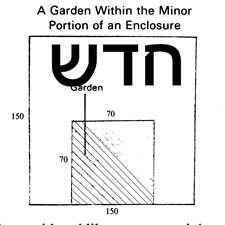
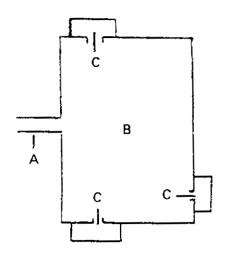
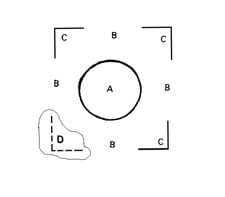
No comments:
Post a Comment